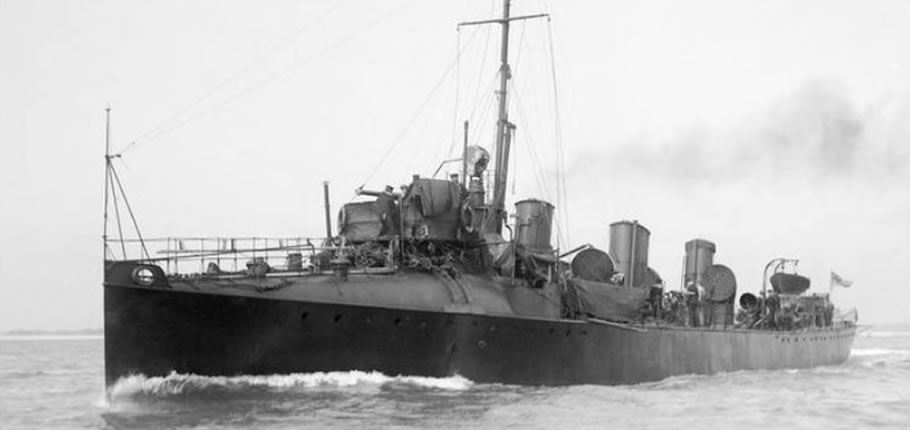
Destroyers – World War 1
After the outbreak of the First World War, a priority for the Royal Navy was to secure the approaches to the English Channel, to prevent elements of the German High Seas Fleet from breaking out into the Atlantic, or from interfering with British maritime trade and convoys to the continent. Most of the major fleet units of the Grand Fleet had dispersed to the navy’s anchorage at Scapa Flow or to other North Eastern ports to monitor the northern route from the North Sea into the Atlantic. Consequently, a number of patrol flotillas were organised along the south and east coasts of England, with commands established at several of the major ports in the region. A large number of destroyers, flotilla leaders and light cruisers were centred at Harwich, under the command of Commodore Reginald Tyrwhitt.
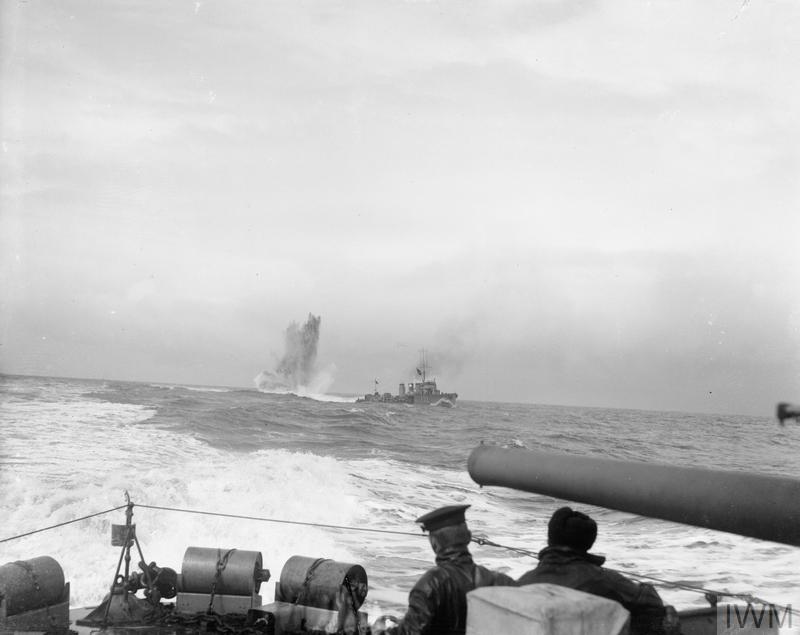
HMS Tempest dropping depth charges in Harwich, Essex on 19th April 1918. © IWM.
In early 1917, the Harwich Force consisted of eight light cruisers, two flotilla leaders and 45 destroyers. By the end of the year, there were nine light cruisers, four flotilla leaders and 24 destroyers. The combination of light, fast ships was intended to provide effective scouting and reconnaissance, whilst still being able to engage German light forces, and to frustrate attempts at minelaying in the Channel.
Early-war destroyers had the speed and armament to intercept submarines before they submerged, either by gunfire or by ramming. Destroyers also had a shallow enough draft that torpedoes would find it difficult to hit them.
Most destroyers were fitted with four or six main guns, smaller calibre canon or machineguns, torpedoes, mine sweeping equipment, depth charges and asdic (sonar).
HMS Archer
- Type. Destroyer
- Class. Acheron
- Pennant. H10,H29,H06
- Builder. Yarrow
- Ordered. 1910-11
- Launched. 21/10/1911
- Commissioned. 1912
- Speed. 31 knots
- Fate. Scrapped 09/05/1921
-
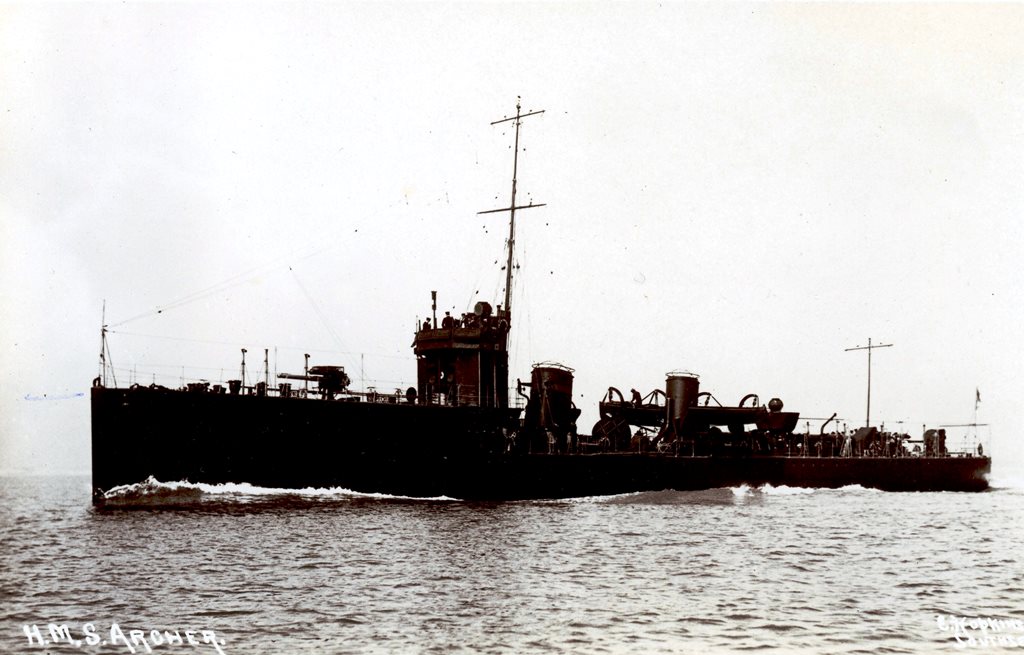
H.M.S. Archer
HMS Archer was an Acheron-class destroyer built in 1911, which served during the First World War and was sold in 1921. She was the fourth ship of the name to serve in the Royal Navy. She was laid down at the Yarrow & Company yard in Scotstoun, Glasgow, and was launched on 21 October 1911. Archer and Attack used steam at higher pressures than the other Acheron-class destroyers and consequently were faster than the standard Admiralty-designed members of their class. Achieving 31 knots (57 km/h) on trials, she carried two 4-inch (102 mm) guns, other smaller guns and 21-inch (530 mm) torpedo tubes and had a complement of 70 men. As part of the First Destroyer Flotilla, she was attached to the Grand Fleet in August 1914, and then to the Third Battle Squadron from the spring of 1916. As part of the Harwich Force, the First Destroyer Flotilla took part in the Battle of Heligoland Bight on 28 August 1914. She was sold to Ward on 9 May 1921 for breaking.
HMS Ariel
- Type. Destroyer
- Class. Acheron
- Pennant. H11, H37, H07
- Builder. Thornycroft
- Ordered. 1910-11
- Laid Down. 1911
- Launched. 26/09/1911
- Commissioned. 1911
- Speed. 31 knots
- Fate. Mined 02/08/1918
-

HMS Ariel
HMS Ariel was an Acheron Class Destroyer; Ariel was laid down at the Woolston yard of John I. Thornycroft & Company, and launched on 26 September 1911. On 5 August 1914, Ariel towed submarine E8 to Terschelling. They were in company with cruiser Attentive and submarine E6, and after releasing the tow, the two submarines conducted the first Heligoland Bight patrol of the war, as part of the Harwich Force, the First Destroyer Flotilla took part in the Battle of Heligoland Bight on 28 August. On 2 August, while conducting mine laying in the western end of the Heligoland Bight, the V-class destroyer Vehement sank after striking a German mine. In attempting to exit the minefield, Ariel lost her bow and sank in less than an hour. 49 lives were lost including her commanding officer.
HMS Attack
- Type. Destroyer
- Class. Acheron
- Pennant. H14, H86, H08
- Builder. Yarrow
- Ordered. 1910-11
- Laid Down. 1911
- Launched. 12/12/1911
- Commissioned. 1911
- Speed. 31 knots
- Fate. Mined 30/12/1917
-
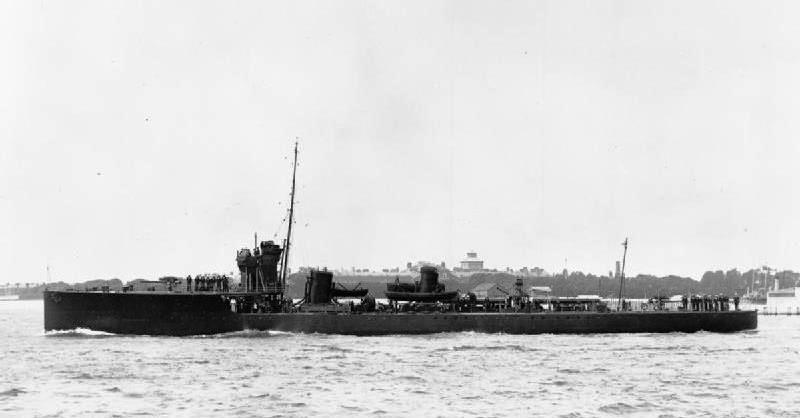
HMS Attack
HMS Attack was an Acheron-class destroyer built in 1911, laid down at the Yarrow & Company yard in Scotstoun, Glasgow, and was launched on 12 December 1911. As part of the First Destroyer Flotilla, she was attached to the Grand Fleet in August 1914, and then to the Third Battle Squadron from the spring of 1916. As part of the Harwich Force, the First Destroyer Flotilla took part in the Battle of Heligoland Bight on 28 August 1914. On 27 December 1917, Attack and two Imperial Japanese Navy destroyers escorted two transport ships, HMT Aragon and SS Nile, from Malta to Egypt. The convoy weathered a gale, and off the Egyptian coast at daybreak on Sunday 30 December it divided. Nile and the two Japanese destroyers proceeded to Port Said, while Aragon and Attack made for Alexandria. Aragon and Attack were in Alexandria Roads about 8 miles outside the port, awaiting permission to enter, when at about 1100 hrs. the German Type UC II submarine SM UC-34 torpedoed Aragon, which rapidly began to sink.
Attack and the armed trawler HMT Points Castle came to the rescue. Attack drew right alongside Aragon to take survivors aboard as quickly as possible, helped by lines cast between the two ships. About 17 to 20 minutes after being hit Aragon went down, and she suffered a second explosion as the cold seawater reached her hot boilers. Some of her boats were left upturned in the water. Then a torpedo struck Attack amidships and blew her into two pieces, both of which sank with five to seven minutes. The explosion ruptured Attack’s bunkers, spilling tons of thick, black bunker fuel oil into the sea as she sank. Hundreds of men were in the water, and many of them became covered in oil or overcome by its fumes. Aragon’s surviving lifeboats now ferried hundreds of survivors to the two trawlers and other trawlers came out to assist. 10 sailors from Attack died, 600 lives were lost in Aragon.
HMS Basilisk
- Type. Destroyer
- Class. Beagle
- Pennant. H99, H33
- Builder. JS White
- Ordered. 1908-09
- Laid Down. 1910
- Launched. 09/02/1910
- Commissioned. 1910
- Speed. 27 knots
- Fate. Scrapped 01/11/1921
-
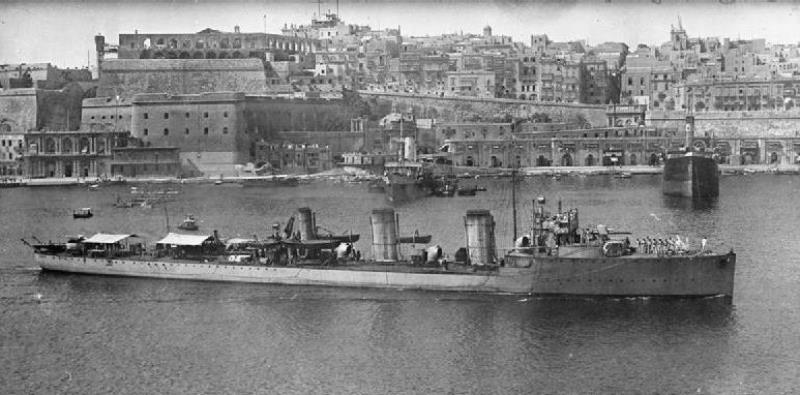
HMS Basilik
HMS Basilisk was a Beagle Class Destroyer launched on the 9th February 1910 by J.S White and sold in 1921 on the 1st May 1912 she was part of the 3rd Destroyer Flotilla based at Harwich.
HMS Beagle
- Type. Destroyer
- Class. Beagle
- Pennant. HC5
- Builder. John Brown
- Ordered. 1908-1909
- Laid Down. 1909
- Launched. 16/10/1909
- Commissioned. 1910
- Speed. 27 knots
- Fate. Scrapped 01/11/1921
-
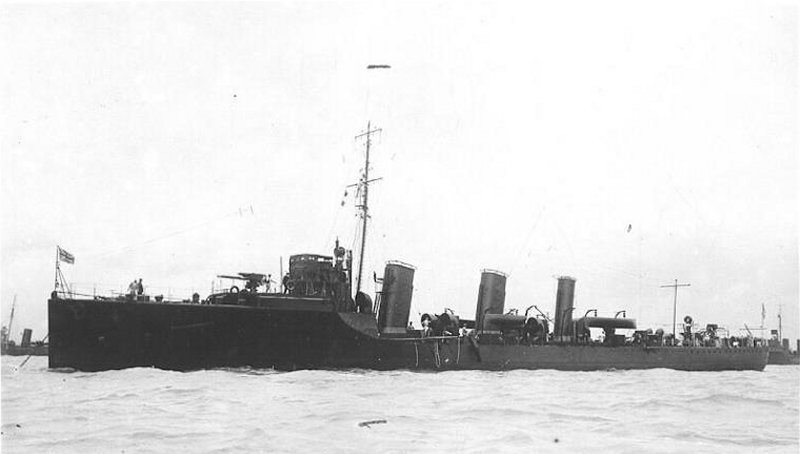
HMS Beagle
HMS Beagle was a Beagle Class Destroyer launched by John Brown and Company, Clydebank on the 16th October 1909. In July 1913 she was serving with the Third Destroyer Flotilla. Commander Harry R. Godfrey commanded her when she covered the landings at Anzac Cove at Gallipoli. At Suvla Bay on 6-7 August, 1915, Beagle worked with five of her sisters and Arno to tow troop barges. Beagle was sold for breaking on the 1st November 1921.
HMS Bruce
- Type. Destroyer
- Class. Scott
- Pennant. F48, D81
- Builder. Cammell Laird
- Ordered. 1916
- Laid Down. 1918
- Launched. 26/02/1918
- Commissioned. 1918
- Speed. 26.5 knots
- Fate. Sank 22/11/1939
-

HMS Bruce
HMS Bruce was a Scott Class Destroyer that served in the First World War and the inter-war period. The ship was ordered in December 1916 and launched on the 26th February 1918 by Cammell Laird shipyard, Birkenhead .In 1918 she served as part of the 10th Destroyer Flotilla at Harwich. After the War she was sunk as an aircraft torpedo target south of the Isle of Wight on the 22nd November 1939.
HMS Bulldog
-
- Type. Destroyer
- Class. Beagle
- Pennant. H25, HC7, HC4
- Builder. John Brown
- Ordered. 1908-09
- Laid Down. 1909
- Launched. 13/11/1909
- Commissioned. 1909
- Speed. 27 knots
- Fate. Scrapped 21/09/1920
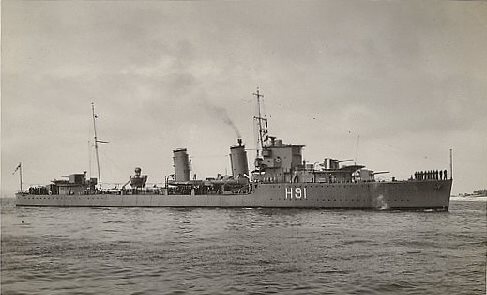
HMS Bulldog
She was commissioned on 7 July 1910 for service with the First Destroyer Flotilla of the First Division of the Home Fleet tendered to HMS Blake.
In February 1919 with the disbandment of the Second Destroyer Flotilla she was withdrawn from active service and laid up in reserve at the Nore. In April 1920 she was placed on the disposal list. She was sold on the 21st of September, 1920 to Thos W Ward of Sheffield for breaking at Rainham, Kent, on Thames Estuary.
HMS Chelmer
- Type. Destroyer
- Class. River Class
- Pennant.
- Builder. Thornycroft
- Ordered. 1903
- Laid Down. 11/12/1903
- Launched. 08/12/1904
- Commissioned.1905
- Speed. 25.5 knots
- Fate. Scrapped 30/06/1920
-
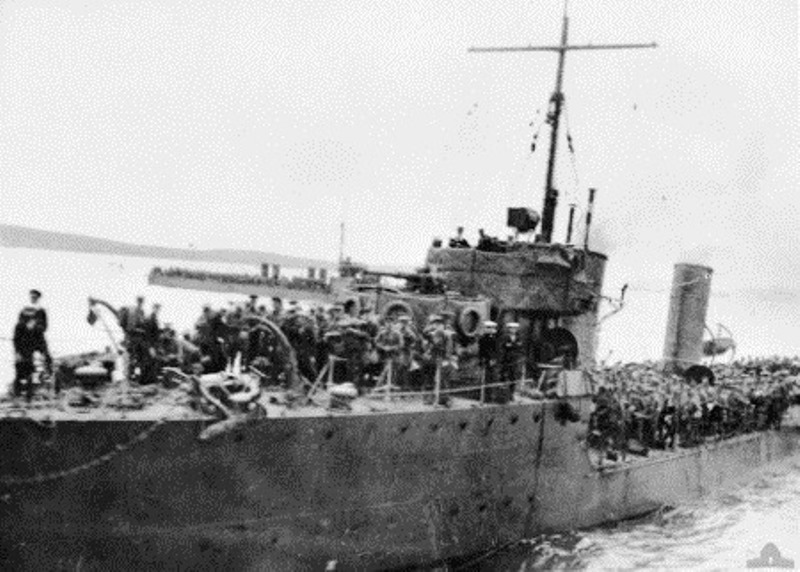
HMS Chelmer
HMS Chelmer was a Thornycroft type River Class Destroyer. She was laid down on 11 December 1903 at the Thornycroft shipyard at Chiswick and launched on 8 December 1904. She was completed in June 1905. After commissioning she was assigned to the East Coast Destroyer Flotilla of the 1st Fleet and based at Harwich. On 27 April 1908 the Eastern Flotilla departed Harwich for live fire and night Manoeuvres. During these exercises HMS Attentive rammed and sank HMS Gala then damaged HMS Ribble. On 30 August 1912 the Admiralty directed all destroyer classes were to be designated by alpha characters starting with the letter ‘A’. The ships of the River Class were assigned to the E Class. After 30 September 1913, she was known as an E Class destroyer and had the letter ‘E’ painted on the hull below the bridge area and on either the fore or aft funnel
In July 1914 she was on China Station based at Hong Kong tendered to HMS Triumph. At the outbreak of war she was in dockyard hands undergoing a refit. With the fall of Tsingtao and the sinking of the SMS Emden, she was redeployed to the 5th Destroyer Flotilla in the Mediterranean Fleet in November 1914 accompanying HMS Triumph, to support the Dardanelles campaign.
In 1919 she returned to Home waters, was paid off and laid up in reserve awaiting disposal. On 30 June 1920 she was sold to Thomas W. Ward of Sheffield for breaking at Hayle, North Cornwall.
HMS Colne
- Type. Destroyer
- Class. River
- Pennant.
- Builder. Thornycroft
- Ordered. 1903
- Laid Down. 21/03/1904
- Launched. 21/05/1905
- Commissioned. 1905
- Speed. 25.5 knots
- Fate. Scrapped 04/11/1919
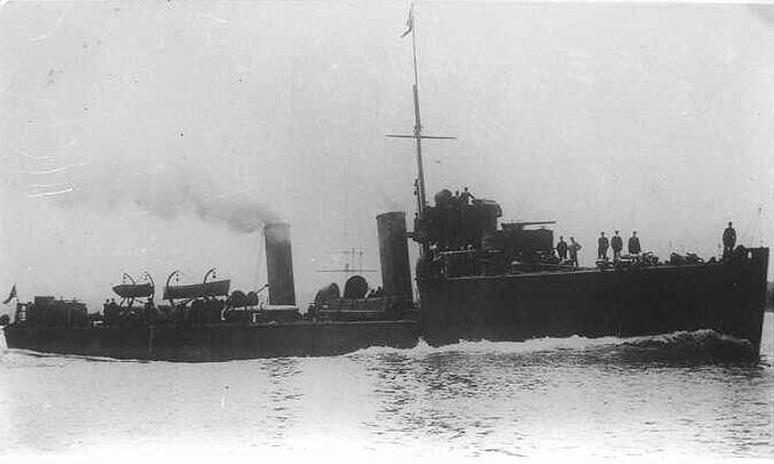
HMS Colne
HMS Colne was a Thornycroft type River Class Destroyer. She was laid down on 21 March 1904 at the Thornycroft shipyard at Chiswick and launched on 21 May 1905. She was completed in July 1905. After commissioning she was assigned to the East Coast Destroyer Flotilla of the 1st Fleet and based at Harwich.
HMS Contest
- Type. Destroyer
- Class. Acasta
- Pennant. H63, H28
- Builder. Hawthorn Leslie
- Ordered. 1911
- Laid Down. 1912
- Launched. 07/01/1913
- Commissioned. 1913
- Speed. 27 knots
- Fate. Sank 18/09/1917
-

HMS Contest
HMS Contest was an Acasta Class Destroyer launched on the 7th January 1913 by Hawthorn Leslie, she was torpedoed in the Western Approaches while assisting the torpedoed steamer City of Lincoln in the English Channel on the 18th sept 1917.
HMS Desperate
- Type. Destroyer
- Class. Two Funnel
- Pennant. P50, D40, D26
- Builder. Thornycroft
- Ordered. 10/05/1895
- Laid Down. 01/07/1895
- Launched. 15/02/1896
- Commissioned. 1897
- Speed. 30 knots
- Fate. Scrapped 20/05/1920
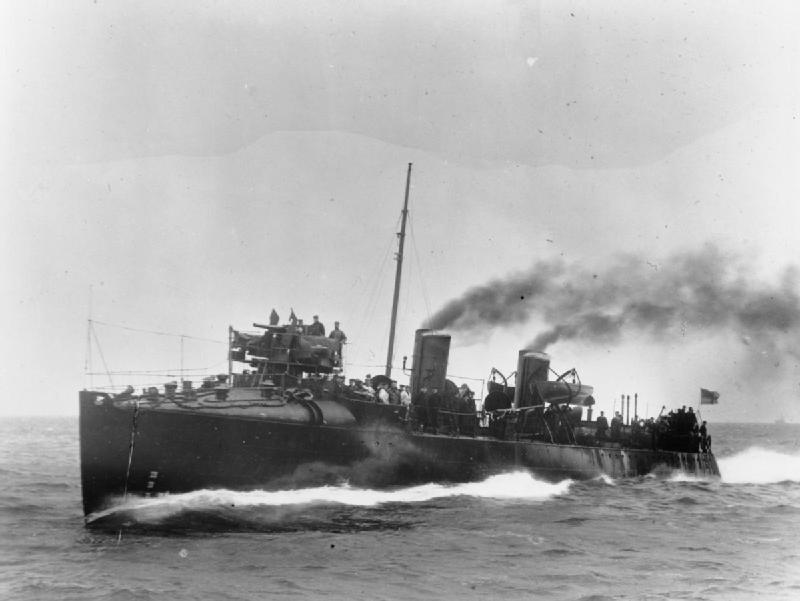
HMS Desperate
HMS Desperate was a Two funnel destroyer laid down as yard number 305 on 1 July 1895 at the John I. Thornycroft & Company shipyard at Chiswick on the River Thames. She was launched on 15 February 1896. After commissioning she was assigned to the Chatham Division of the Harwich Flotilla. On 26 June 1897 she was present at the Royal Naval Review at Spithead in celebration of Queen Victoria’s Diamond Jubilee. She was re-assigned to Sheerness in January 1900 for instructional purposes at the Sheerness school of gunnery.
On 30 August 1912 the Admiralty directed that all destroyer classes were to be designated by letters. She was assigned to the D class along with other destroyers built to the same overall specification. In August 1914 she was in active commission tendered to HMS Excellent, the Portsmouth gunnery school she remained there for the duration of the First World War.
In 1919 Desperate was paid off then laid up in reserve awaiting disposal. She was sold on 20 May 1920 to Thomas W. Ward of Sheffield for breaking at Milford Haven, Wales.
HMS Doon
- Type. Destroyer
- Class. River
- Pennant. N14, D16, D27
- Builder. Hawthorn Leslie
- Ordered. 1903-1904
- Laid Down. 16/02/1904
- Launched. 08/11/1904
- Commissioned. 1905
- Speed. 25.5 knots
- Fate. Scrapped 27/05/1919
-
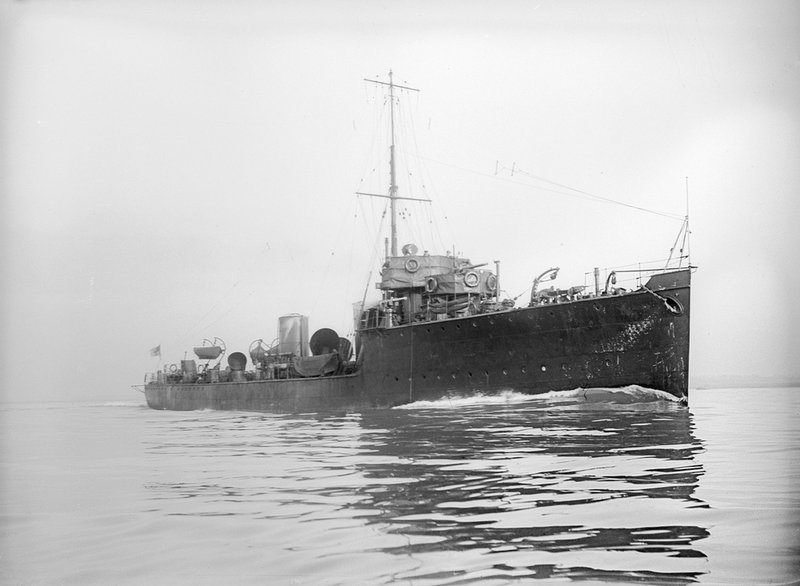
HMS Doon
HMS Doon was laid down on 16 February 1904 at the Hawthorn Leslie shipyard at Hebburn-on-Tyne and launched on 8 November 1904. After commissioning she was assigned to the East Coast Destroyer Flotilla of the 1st Fleet and based at Harwich.
In early 1914 when displaced by G Class destroyers she joined the 9th Destroyer Flotilla based at Chatham tendered to HMS St George. The 9th Flotilla was a Patrol Flotilla tasked with anti-submarine and counter mining patrols in the Firth of Forth area.
On 16 December 1914 under command of Lieutenant-Commander H. McLeod-Fraser, RN, as the division leader with HMS Waveney, HMS Test and HMS Moy were sent to patrol off Hartlepool. During the German Battle Cruiser Raid on Hartlepool, she was damaged by German shellfire. She was straddled by three salvoes with one near miss by an 11-inch shell grazing the after edge of the foremost funnel, damaging a berth on boat, before going overboard and bursting on impact with the water. She suffered splinter damage and had her wireless, aft gun and torpedo tube put out of action. She suffered 3 dead and 6 wounded.
In August 1915 with the amalgamation of the 9th and 7th Flotillas she was deployed to the 7th Destroyer Flotilla based at the River Humber. She remained employed on the Humber Patrol participating in counter mining operations and anti-submarine patrols for the remainder of the war.
In 1919 she was paid off and laid up in reserve awaiting disposal. On 27 May 1919 she was sold to Thomas W. Ward of Sheffield for breaking at Rainham, Kent, on the Thames Estuary
HMS Firedrake
- Type. Destroyer
- Class. Acheron
- Pennant. H79, H33, H89
- Builder. Yarrow
- Ordered. 1910-11
- Laid Down. 1911
- Launched. 09/04/1912
- Commissioned. 1912
- Speed. 32 knots
- Fate. Scrapped 10/10/1921
-
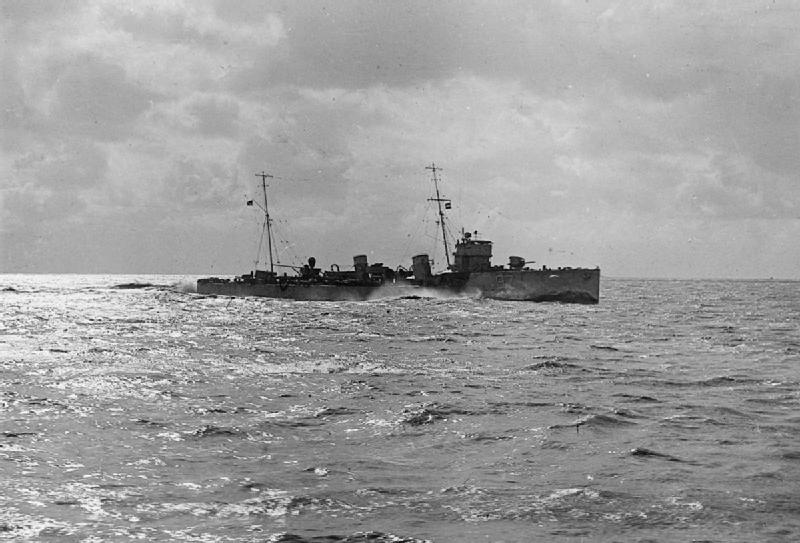
HMS Firedrake
HMS Firedrake was a modified Acheron Class Destroyer, placed with Yarrow & Company of Scotstoun, Glasgow and launched on the 9th April 1912. At the start of World War I Firedrake and Lurcher were assigned to the Eighth Submarine Flotilla under the command of Commodore Keyes, and were based at Parkeston Quay, Harwich. Both ships were employed in escorting, towing and exercising with submarines of their flotilla. On 27 April 1916 the German Navy submarine UC-5 under the command of Oberleutnant zur See Ulrich Mohrbutter ran aground on Ship wash Shoal in position Firedrake captured the U-boat at 1:00pm relatively intact; apart from some damage incurred in the grounding, the crew had taken measures to damage instruments and equipment, including firing small arms at them, and seven destruction charges had caused several holes in the pressure hull. UC-5 was towed to Harwich and placed in a dry dock, where she was examined and reconditioned. She was displayed at Temple Pier on the Thames in London, and later moved to New York, where she was displayed in Central Park. Firedrake’s captain, Commander Aubrey Thomas Tillard was mentioned in dispatches for his part in the capture. HMS Firedrake was sold for breaking in October 1921.
HMS Flirt
- Type. Destroyer
- Class. Palmer
- Pennant. P87, D56
- Builder. Palmers
- Ordered. 1896
- Laid Down. 05/09/1896
- Launched. 15/05/1897
- Commissioned. 1899
- Speed. 30 knots
- Fate. Sank 27/10/1916
-
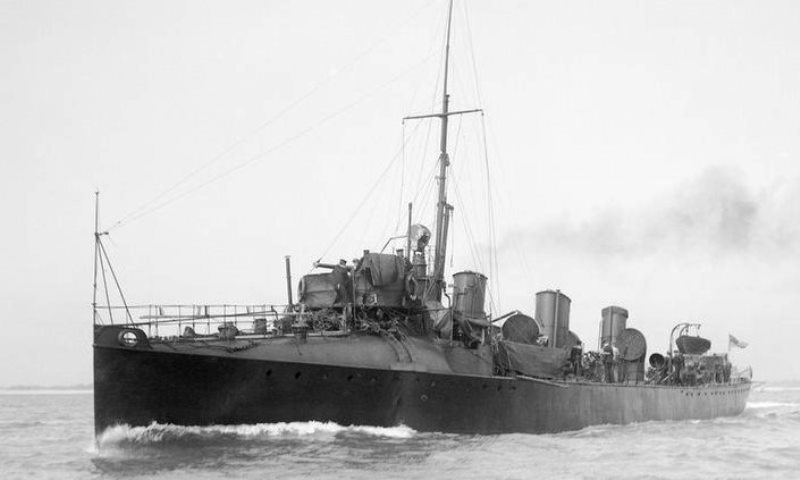
HMS Flirt
HMS Flirt was a Palmer three funnel destroyer. She was laid down on 5 September 1896 at the Palmer shipyard at Jarrow-on-Tyne and launched on 15 May 1897. After commissioning she was assigned to the East Coast Flotilla of the 1st Fleet based at Harwich. On 30 August 1912 the Admiralty directed all destroyer classes were to be designated by alpha characters starting with the letter ‘A’. Since her design speed was 30-knots and she had three funnels she was assigned to the C class. After 30 September 1913, she was known as a C-class destroyer and had the letter ‘C’ painted on the hull below the bridge area and on either the fore or aft funnel.
On the night of 26/27 October 1916 the German Navy raided the Dover Barrage with two and a half flotillas of torpedo boats and destroyers. Flirt under the command of Lieutenant R. P. Kellett responded to gunfire from the drifter line. She found Waveney on fire and sent a boat to assist. When unidentified ships approached she issued a challenge and was immediately fired upon by the Germans. Flirt was lost; the only survivors were those dispatched to aid Waveney.
HMS Flying Fish
- Type. Destroyer
- Class. Palmer
- Pennant. P86, D57, D40, H69
- Builder. Palmers
- Ordered. 1895
- Laid Down. 09/08/1896
- Launched. 04/03/1897
- Commissioned. 1898
- Speed. 30 knots
- Fate. Scrapped 30/08/1919
-
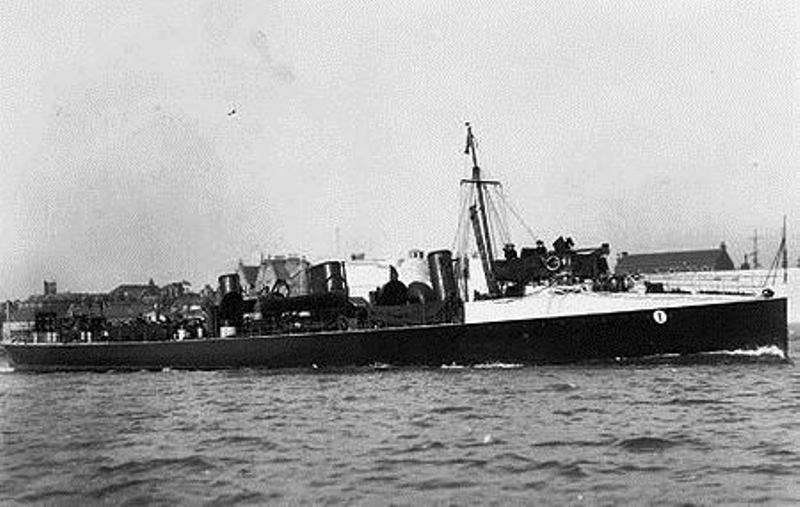
HMS Flying Fish
HMS Flying Fish was a Palmer three funnel destroyer. She was laid down on 9 August 1896 at the Palmer shipyard at Jarrow-on-Tyne and launched on 4 March 1897. During her builder’s trials she made her contracted speed requirement. She was completed and accepted by the Royal Navy in June 1898. After commissioning she was assigned to the East Coast Flotilla of the 1st Fleet based at Harwich. On 16 December 1901 she was re-commissioned by Lieutenant and Commander H. P Buckle for service on the Mediterranean Station, as tender to the battleship Royal Oak After leaving Devonport for her commission in February 1902, she encountered hard weather in the Bay of Biscay and was knocked about so that she started leaking, and had to port at Brest. She was sufficiently repaired to be able to return to Devonport for more extensive repairs in late February.
On 30 August 1912 the Admiralty directed all destroyer classes were to be designated by alpha characters starting with the letter ‘A’. Since her design speed was 30-knots and she had three funnels she was assigned to the C class. After 30 September 1913, she was known as an C-class destroyer and had the letter ‘C’ painted on the hull below the bridge area and on either the fore or aft funnel.
In May 1916 when she was deployed to the 7th Destroyer Flotilla based at the Humber River. She performed patrol duties on the Humber Patrol including anti-submarine and counter-mining patrols. She would remain there for the remainder of the war.
In 1919 Flying Fish was paid off and laid-up in reserve awaiting disposal. She was sold on 30 August 1919 to TR Sales for breaking.
HMS Foxhound
-
- Type. Destroyer
- Class. Beagle
- Pennant. H16, H58
- Builder. John Brown
- Ordered. 1908-09
- Laid Down. 1909
- Launched. 11/12/1909
- Commissioned. 1910
- Speed. 27 knots
- Fate. Scrapped 01/11/1921
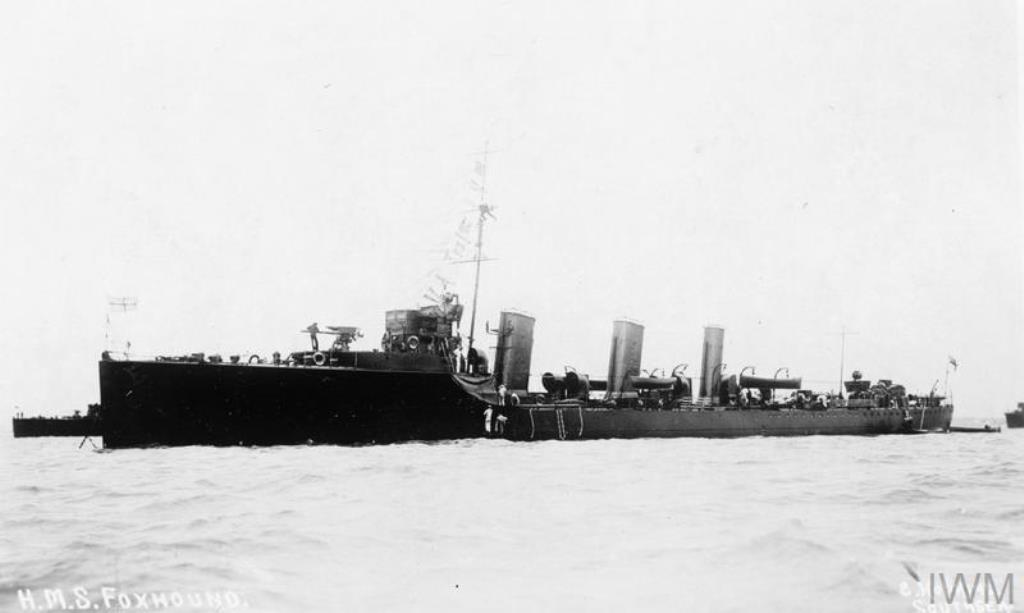
H.M.S. Foxhound
HMS Foxhound was a Beagle Class Destroyer launched on the 11th December 1909 and sold in November 1921. She served with the 3rd Destroyer Flotilla based at Harwich in 1912.
HMS Foyle
- Type. Destroyer
- Class. River
- Pennant. N44, D20
- Builder. Cammell Laird
- Ordered. 1901
- Laid Down.12/06/1902
- Launched. 25/02/1903
- Commissioned. 1904
- Speed. 25.5 knots
- Fate. Sank 15/03/1917
-
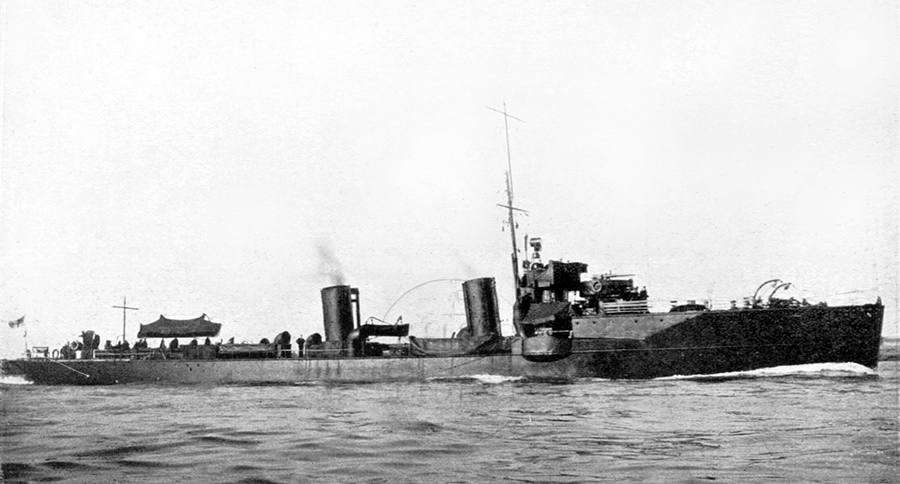
HMS Foyle
HMS Foyle was a Laird Type River Class Destroyer; she was laid down on 12 June 1902 at the Cammell Laird shipyard at Birkenhead and launched on 25 February 1903. After commissioning she was assigned to the East Coast Destroyer Flotilla of the 1st Fleet and based at Harwich. On 27 April 1908 the Eastern Flotilla departed Harwich for live fire and night Manoeuvres. In April 1909 she was assigned to the 3rd Destroyer Flotilla of the 1st Fleet on its formation at Harwich. She remained until displaced by a Basilisk Class destroyer by May 1912. She went into reserve in the 5th Destroyer Flotilla of the 2nd Fleet with a nucleus crew.
On 15 March 1917 HMS Foyle struck a contact mine laid by German submarine UC-68 off Plymouth with the loss of 28 officers and men. Her bow was blown off and she foundered while under tow to Plymouth.
HMS Kestrel
- Type. Destroyer
- Class. C
- Pennant. N47, D60, D49
- Builder. J&G Thompson
- Ordered. 1896-1897
- Laid Down. 02/09/1896
- Launched. 25/03/1898
- Commissioned. 1900
- Speed. 30 knots
- Fate. Scrapped 17/03/1921
-
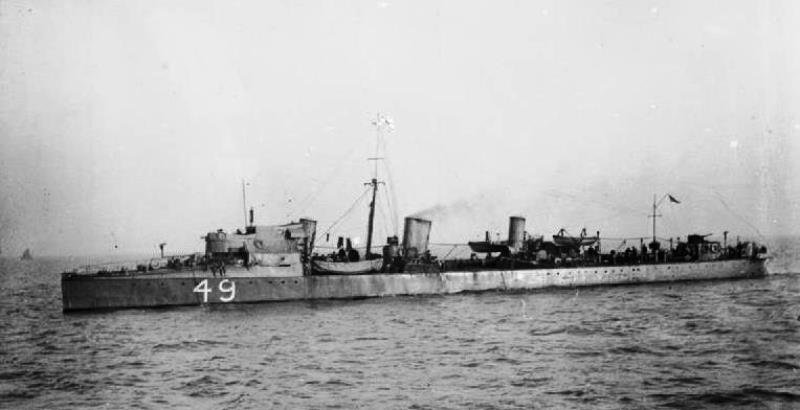
HMS Kestrel
HMS Kestrel was a Clydebank built Destroyer. She was laid down as Yard Number 298 on 2 September 1896 at J & G Thompson shipyard in Clydebank and launched on 25 March 1898. During her builder’s trials she made her contract speed of 30 knots. After commissioning she was assigned to the Chatham Division of the Harwich Flotilla. She was deployed in Home waters for her entire service life. On 30 August 1912 the Admiralty directed all destroyer classes were to be designated by letters. Since her design speed was 30-knots and she had three funnels she was assigned to the C Class. After 30 September 1913, she was known as a C Class destroyer and had the letter ‘C’ painted on the hull below the bridge area and on either the fore or aft funnel.
In 1914 she was in active commission at the Nore based at Sheerness tendered to HMS Actaeon, a Royal Navy training establishment. With the outbreak of hostilities in August 1914 she was assigned to the Nore Local Flotilla. Her duties included anti-submarine and counter mining patrols in the Thames Estuary. In 1919 she was paid off and laid-up in reserve awaiting disposal. She was sold on 17 March 1921 to Thomas W. Ward of Sheffield for breaking at Rainham, Kent on the Thames Estuary.
HMS Laertes
- Type. Destroyer
- Class. Laforey
- Pennant. H94, H45
- Builder. Swan Hunter
- Ordered. 1912
- Laid Down. 1913
- Launched. 05/06/1913
- Commissioned. 1913
- Speed. 29 knots
- Fate. Scrapped 01/12/1921
-
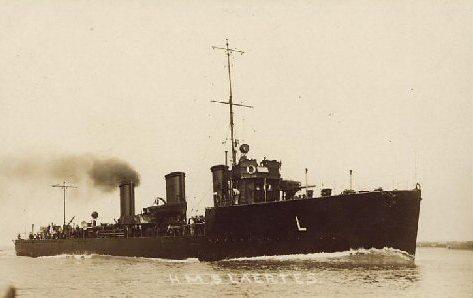
HMS Laertes
HMS Laertes was a Laforey Class Destroyer launched on the 5th June 1913 at the Swan Hunter Shipyard under the name HMS Sarpedon. She was renamed HMS Laertes on 30 September 1913. She took part in the Battle of Heligoland Bight on 28 August 1914, where she was seriously damaged suffering four shell strikes.Laertes was one of the destroyers of the Harwich squadron which attempted to head off attacking German ships during the Bombardment of Yarmouth and Lowestoft on 25 April 1916. The ship was hit by shellfire damaging the boiler room, and would most likely have sunk except for the actions of Stoker Ernest Clarke. Clarke later died from burns received while saving the ship and was posthumously awarded the Distinguished Service Medal. Five of the crew was injured during the attack. Stoker Petty Officer Stephen Pritchard, who entered the cabin flat immediately after a shell had exploded there, and worked a fire hose, was awarded the Distinguished Service Medal.
She was sold on 1 December 1921 to Stanlee, of Dover for breaking up. She stranded whilst being towed to the breakers, but arrived on 8 March 1922. She was scrapped that year.
HMS Laforey
- Type. Destroyer
- Class. L
- Pennant. H03
- Builder. Fairfield
- Ordered. 1912
- Laid Down. 1913
- Launched. 05/06/1913
- Commissioned. 1913
- Speed. 29 knots
- Fate. Sank 23/03/1917
-
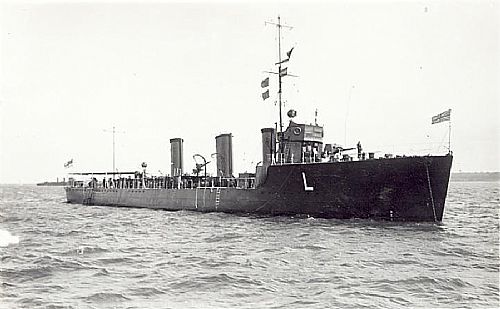
HMS Laforey
HMS Laforey was a Laforey Class Destroyer launched by Fairfield Shipbuilding on the 5th June 1913. She was laid down on 1 March 1939 at the same time as her sister, HMS Lance. She was launched on 15 February 1941 and commissioned on 26 August 1941. She cost £445,684, excluding items such as weapons and communications equipment supplied by the Admiralty. On commissioning she was assigned to the 19th Destroyer Flotilla of the Home Fleet as the Flotilla leader. Laforey returned to Naples and was deployed off Anzio on 9 March 1944 on support and patrol duties that were scheduled to last until 19 March. On 23 March she again returned to Anzio and on 24 March she was deployed for night interception and anti-submarine patrols with HMS Grenville. On 25 March they engaged a number of E-boats after picking them up on their radar. Laforey then sailed to Naples. She deployed for another patrol off the west coast of Italy on 28 March and on 29 March she carried out a hunt for U-223 north of Palermo, in company with the destroyers HMS Tumult, HMS Tuscan, HMS Urchin, HMS Hambledon and HMS Blencathra. U-223 had been detected by HMS Ulster during a routine sweep. The search lasted until 30 March, when after sustaining several hours of depth charge attacks; U-223 surfaced, and was then attacked by the destroyers with gunfire at a range of 1,500 yards. U-223 was able to fire three torpedoes which struck Laforey. She sank quickly, resulting the loss of most of her company, including her captain. There were only 65 survivors out of the 247 on board. U-223 was sunk soon afterwards, and the survivors from the Laforey and U-223 were picked up by HMS Blencathra, HMS Hambledon and HMS Tumult.
HMS Lance
- Type. Destroyer
- Class. Laforey
- Pennant. H23, H46, G87
- Builder. Thornycroft
- Ordered. 1913
- Laid Down. 1914
- Launched. 25/02/1914
- Commissioned. 1914
- Speed. 29 knots
- Fate. Scrapped 1921

HMS Lance
HMS Lance was launched by Thornycroft on the 25th February 1914 as a L Class Destroyer and was attached to the Harwich Force, Lance took part in several engagements during the war, including the sinking of the Königin Luise and the Battle off Texel. Throughout the War, Lance was attached to the 3rd Destroyer Flotilla of Harwich Force. On 17 October 1914 Lance was with her flotilla when it attacked the German Seventh Half Flotilla of torpedo boats completely annihilating the German force.
HMS Landrail
- Type. Destroyer
- Class. Laforey
- Pennant. H54
- Builder. Yarrow
- Launched. 07/02/1914
- Commissioned. 1914
- Speed. 29 knots
- Fate. Sold 01/12/1921
-
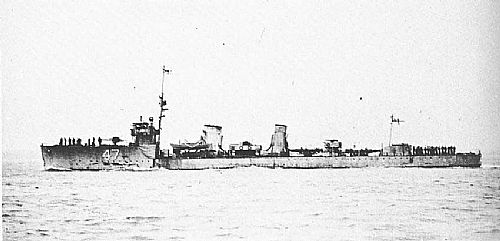
HMS Landrail
HMS Landrail was a Laforey Class Destroyer launched by Yarrow Shipbuilders in 1914. She was to have been named HMS Hotspur, but was renamed in 1913. She was sold in 1921.
5th Aug 1914. Königin Luise was requisitioned by the Kaiserliche Marine on the 3rd of August 1914 to serve as an auxiliary minelayer, and was pressed in to service when Britain entered the war. On the night of the 4th/5th of August she laid a minefield off the coast but was spotted by a number of fishing vessels. The light cruiser HMS Amphion and a number of destroyers of the 3rd Flotilla sailed early in the morning of 5th of August and sailed towards Heligoland Bight. En-route they encountered a fishing vessel, whose crew informed the British ships that they had seen a ship “throwing things over the side” about 20 miles north of the Outer Gabbard. The taskforce spotted Königin Luise at 10:25, but she fled at top speed, moving into a rain squall, where she proceeded to lay more mines. HMS Lance and HMS Landrail gave chase, and Lance opened fire, the first British Naval shot of the war. HMS Amphion soon closed in and also commenced firing on the Königin Luise which attempted to escape to neutral waters to the south-east, leading the pursuing British vessels through her minefield. Being damaged by heavy fire, Commander Biermann ordered the scuttling of the Königin Luise. The surviving crew abandoned ship, and the vessel rolled over to port and sank at 12:22. 46 of the 100 crew were rescued by the British ships.
HMS Lapwing
- Type. Destroyer
- Class. Acheron
- Pennant. H56, H48, H09
- Builder. Cammell Laird
- Ordered. 1910-11
- Laid Down. 1911
- Launched. 29/07/1911
- Commissioned. 1911
- Speed. 27 knots
- Fate. Scrapped 26/10/1921
-

HMS Lapwing
HMS Lapwing was an Acheron-class destroyer that served during World War I and was sold for breaking in 1921. She was built under the 1910-11 shipbuilding programme by Cammell Laird and Company of Birkenhead and had a complement of 72 men. She was launched on 29 September 1911.
In common with the survivors of her class, she was laid up after World War I, and on 26 October 1921 she was sold to the Barking Ship Breaking Company for scrap.
HMS Lark
- Type. Destroyer
- Class. Laforey
- Pennant. H34, H49
- Builder. Yarrow
- Ordered. 1912
- Laid Down. 1913
- Launched. 26/05/1913
- Speed. 29 knots
- Fate. Scrapped 20/01/1923
-
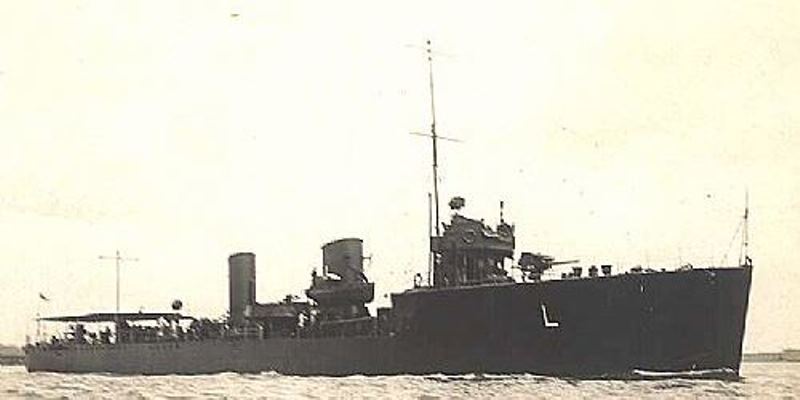
HMS Lark
HMS Lark was a Laforey Class Destroyer built by Yarrow & Co and was launched on the 26th May 1913. At 10.15 hours on 17 Feb, 1945, U-968 fired one LUT torpedo at a warship reported as a Soviet destroyer of the Groznyj class and observed a hit after 6 minutes 20 seconds. HMS Lark was hit in the stern northeast of Murmansk, towed into the Kola Inlet and beached near Rosta.
The ship was declared a total loss by the Royal Navy and the wreck handed over to the Soviets. She was sold on the 20th January 1923.
HMS Lassoo
- Type. Destroyer
- Class. Laforey
- Pennant. G01, F41
- Builder. William Beardmore
- Ordered. 1914
- Laid Down. 1915
- Launched. 24/08/1915
- Speed. 29 knots
- Fate. Sank 13/08/1916
-
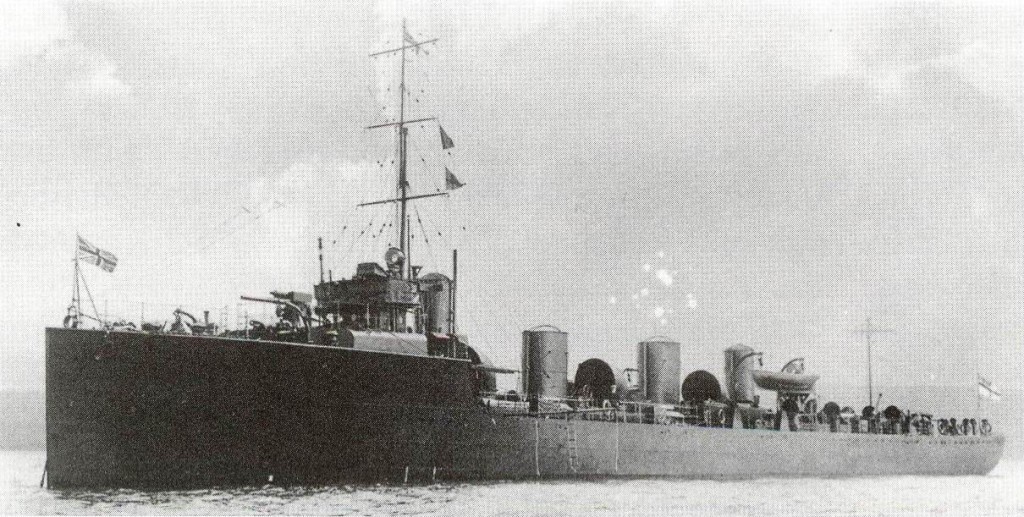
HMS Lassoo
HMS Lassoo was built during the First World War as part of an emergency program of naval construction, to an Admiralty design by William Beardmore & Company, Dalmuir. Lassoo was a Laforey Class Destroyer originally to have been named HMS Magic but she was renamed HMS Lassoo on 15 February 1915 before being launched on 24 August 1915.
She was sunk by the German U-boat SM UB-10 on 13 August 1916 off the Maas lightship in the North Sea.
HMS Laurel
- Type. Destroyer
- Class. Laforey
- Pennant. H91, H51
- Builder. J.S. White
- Ordered. 1912
- Laid Down. 1913
- Launched. 06/05/1913
- Speed. 29 knots
- Fate. Scrapped 01/11/1921
-

HMS Laurel
HMS Laurel was a Laforey Class Destroyer launched on the 6th May 1913 by J.S White as HMS Redgauntlet, but renamed shortly after. She was sold on the 1st November 1921. On the 5th August 1914 she left Harwich as a part of the 3rd Flotilla, under the command of the Amphion, to carry out a search and sweep for enemy craft. Laurel was sold in 1921.
HMS Laverock
- Type. Destroyer
- Class. Laforey
- Pennant. H53
- Builder. Yarrow
- Ordered. 1912
- Laid Down. 1913
- Launched. 19/11/1913
- Commissioned. 1914
- Speed. 29 knots
- Fate. Scrapped 1921
-
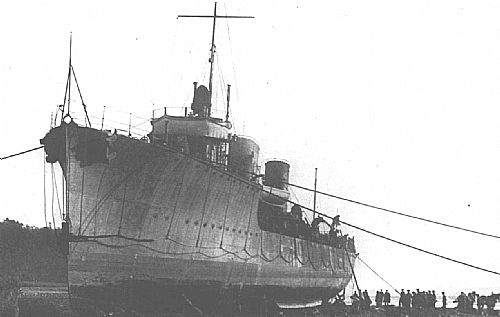
HMS Laverock
HMS Laverock was a Laforey Class Destroyer built by Yarrow & Co and Launched on the 19th November 1913. She served with the 3rd Destroyer Flotilla on completion and transferred to escort duties after 1917. Laverock was Sold for breaking in May 1921.
HMS Lawford
- Type. Destroyer
- Class. Laforey
- Pennant. H06, H53
- Builder. Fairfield
- Ordered. 1912
- Laid Down. 1913
- Launched. 30/10/1913
- Commissioned. 1913
- Speed. 29 knots
- Fate. Scrapped 24/08/1922
-
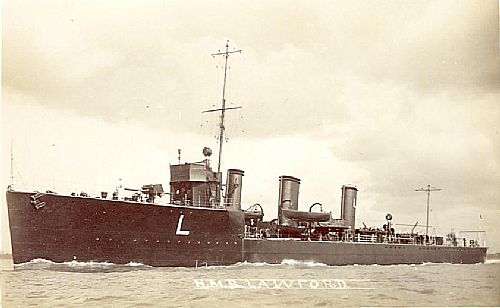
HMS Lawford
HMS Lawford was a Laforey Class Destroyer built by Fairfield shipbuilders, previously named Ivanhoe but renamed shortly after being launched on the 30th October 1913. She was sold for scrapping in 1921.
HMS Leeds
- Type. Destroyer
- Class. Town
- Pennant. G27
- Builder. William Cramp
- Launched. 21/08/1917
- Commissioned. 12/01/1918
- Speed. 30 Knots
- Fate. Scrapped 1947
-
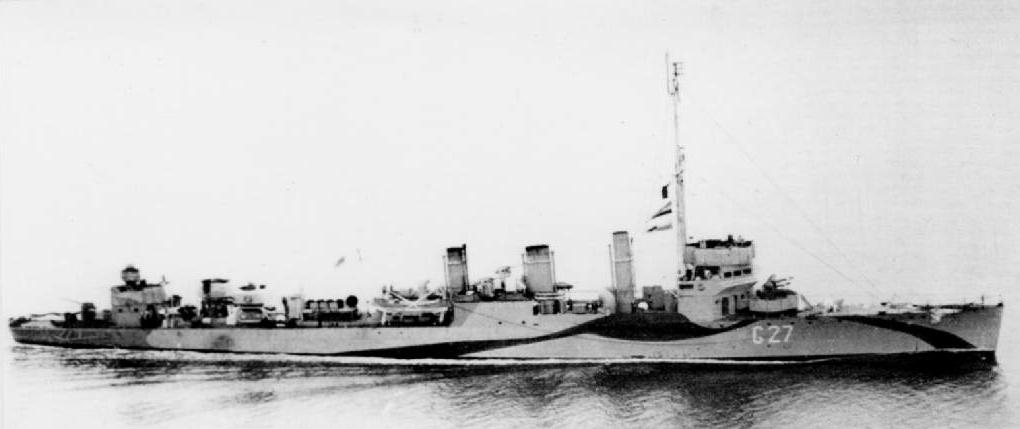
HMS Leeds
HMS Leeds was a Town Class Destroyer built as USS Conner (DD 72) of the Caldwell Class, commissioned in US Navy on 12 Jan, 1918. On 4 Oct, 1919 decommissioned and placed in reserve fleet. In May 1921 recommissioned, but again decommissioned on 21 Jun, 1922. USS Conner was recommissioned 23 August 1940 and fitted out at Philadelphia. Designated for inclusion in the destroyer land bases exchange with Great Britain, she sailed to Halifax, N. S., where she was decommissioned 23 October 1940 and transferred to Britain and commissioned in the Royal Navy as HMS Leeds. On 20 April 1942, she went to the aid of mine-damaged destroyer HMS Cotswold, towing her into Harwich. She drove German E-boats away from her convoy on the night of 24-25 February 1944. Decommissioned in April 1945 and sold for scrap on 4 March 1947 at Grays.
HMS Lennox
- Type. Destroyer
- Class. Laforey
- Pennant. H95, H55
- Builder. William Beardmore
- Laid Down. 1913
- Launched. 02/03/1914
- Commissioned. 1914
- Speed. 29 knots
- Fate. Scrapped 10/11/1921
-
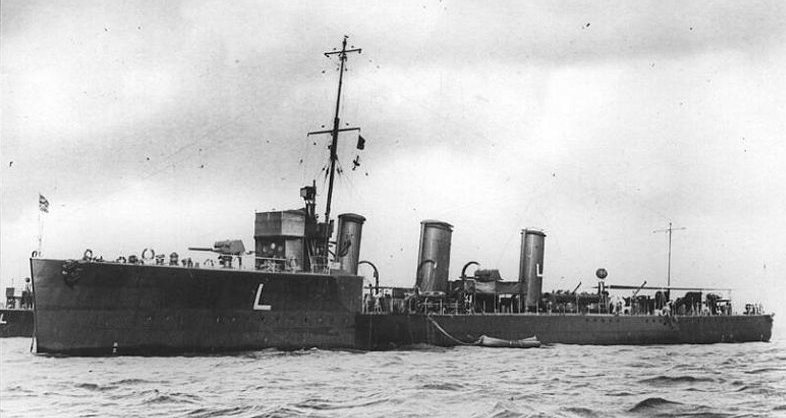
HMS Lennox
HMS Lennox was a Laforey Cass Destroyer laid down as HMS Portia before being renamed. She was constructed by William Beardmore and Company and launched on 2 March 1914. Launched prior to the outbreak of the First World War, she was attached to the Harwich Force and served in the North Sea. Lennox saw action in several engagements, including the Battle off Texel. Sold for Scrapping on the 26th October 1921.
HMS Leonidas
- Type. Destroyer
- Class. Laforey
- Pennant. H20, H56
- Builder. Palmers
- Ordered. 1912
- Laid Down. 1913
- Launched. 30/10/1913
- Speed. 29 knots
- Fate. Scrapped 1921
-
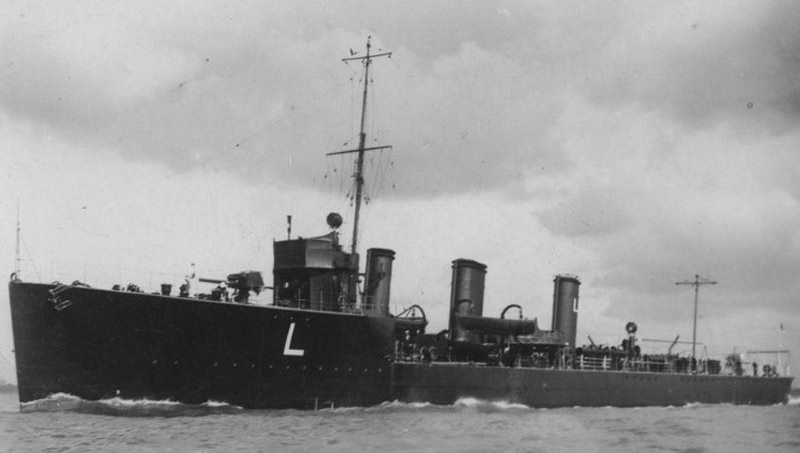
HMS Leonidas
HMS Leonidas was a Laforey Class Destroyer, launched on the 30th October 1913 by Hawthorn Leslie she served in World War I with the 3rd Destroyer Flotilla and as a convoy escort in World War I. Leonidas took part in a battle off Noorhinder Bank on 1 May 1915 when together with three other destroyers, Laforey, Lawford and Lark, she was dispatched to go to the aid of four British armed trawlers which had engaged two German Torpedo boats, A2 and A6. One of the trawlers had been sunk, but sufficient damage had been caused to A6 that the Germans chose to withdraw. The four destroyers pursued the torpedo boats, eventually catching and sinking them. HMS Leonidas also served in the 3rd Destroyer flotilla at the first battle of Heligoland bight, under the command of the famous commodore Tyrwhitt aboard the light cruiser Arethusa. She was sold for scrap in 1921.
HMS Liberty
- Type. Destroyer
- Class. Laforey
- Pennant. H81, H57
- Builder. JS White
- Ordered. 1912
- Laid Down. 1913
- Launched. 15/12/1913
- Commissioned. 1914
- Speed. 29 knots
- Fate. Scrapped 05/11/1921

HMS Liberty
HMS Liberty was a Laforey Class Destroyer constructed by JS White and launched on the 15th December 1913 she served in World War I a part of the 3rd Destroyer Flotilla at Harwich. Liberty was broken up in November 1921.
HMS Lightfoot
- Type. Destroyer
- Class. Laforey
- Pennant. H76, H58, G22, F78
- Builder. JS White
- Ordered. 1914
- Laid Down. 1915
- Launched. 28/05/1915
- Commissioned. 1915
- Speed. 29 knots
- Fate. Scrapped 05/11/1921
-
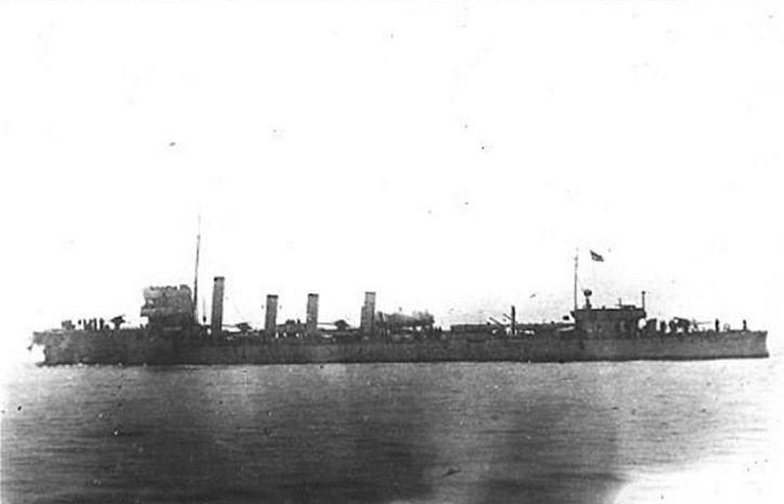
HMS Lightfoot
By October 1915 Lightfoot had joined the Ninth Destroyer Flotilla of the Harwich Force as second leader, replacing Tipperary. On 30 October Lightfoot sailed with the Harwich Force on a sweep across the German Bight, with a single Swedish merchant ship, the Osterland, laden with Iron Ore being arrested and ordered to the Humber for investigation. The Harwich Force, including Lightfoot as well as four light cruisers and 18 destroyers departed Harwich at 2am on 11 February, in the belief that the battlecruisers of the German First Scouting Group were at sea. When it was realised that the German ships were returning to harbour, the Harwich Force turning back for home, but the cruiser Arethusa, flagship of Commodore Reginald Tyrwhitt, commander of the Harwich Force, struck a mine just outside Harwich harbour, killing six men. Lightfoot attempted to take Arethusa in tow, but the line parted, while similar attempts by the destroyer Loyal also failed, with the cruiser running aground and breaking in two.
On 29 June 1916 the Harwich Force was cruising off the Belgian coast when Lightfoot spotted a surfaced submarine and opened fire, following this up with a depth charge when the submarine dived.
HMS Linnet
-
- Type. Destroyer
- Class. Laforey
- Pennant. H43. H59
- Builder. Yarrow
- Ordered. 1912
- Laid Down. 1913
- Launched. 16/08/1913
- Speed. 29 knots
- Fate. Scrapped 04/11/1921
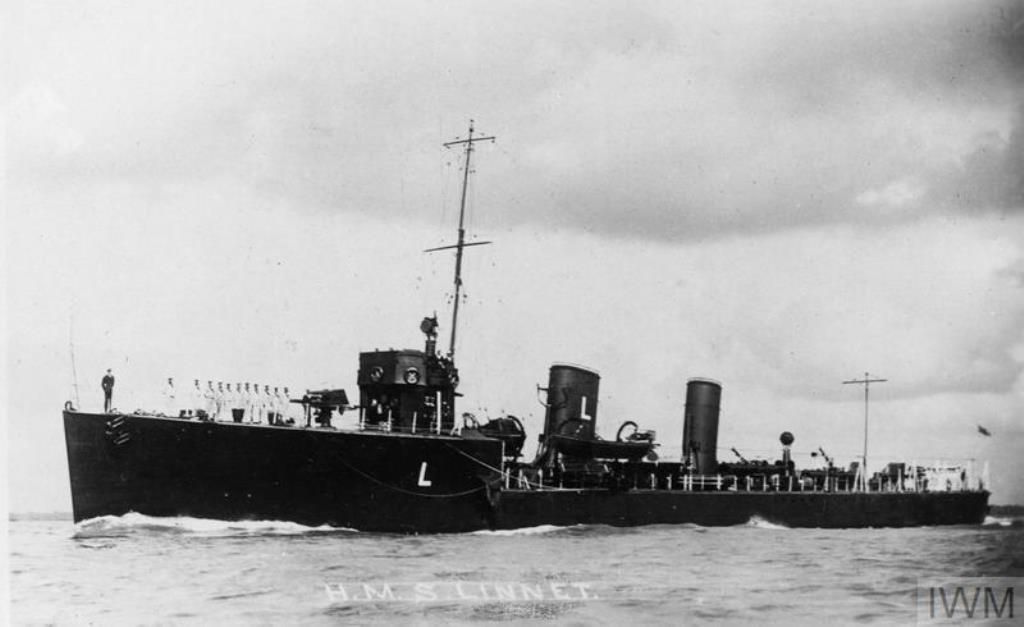
H.M.S. Linnet
HMS Linnet was a Laforey Class Destroyer launched at Yarrow on the 16th August 1913, and originally to have been called Havock. She was sold for scrap on the 4th of November 1921.
History: 8th August 1914 – 3rd Destroyer Flotilla. Harwich
HMS Llewellyn
-
- Type. Destroyer
- Class. L
- Pennant. H99, H61
- Builder. William Beardmore
- Laid Down. 1913
- Launched. 30/10/1913
- Commissioned. 1914
- Speed. 29 knots
- Fate. Scrapped 10/03/1922
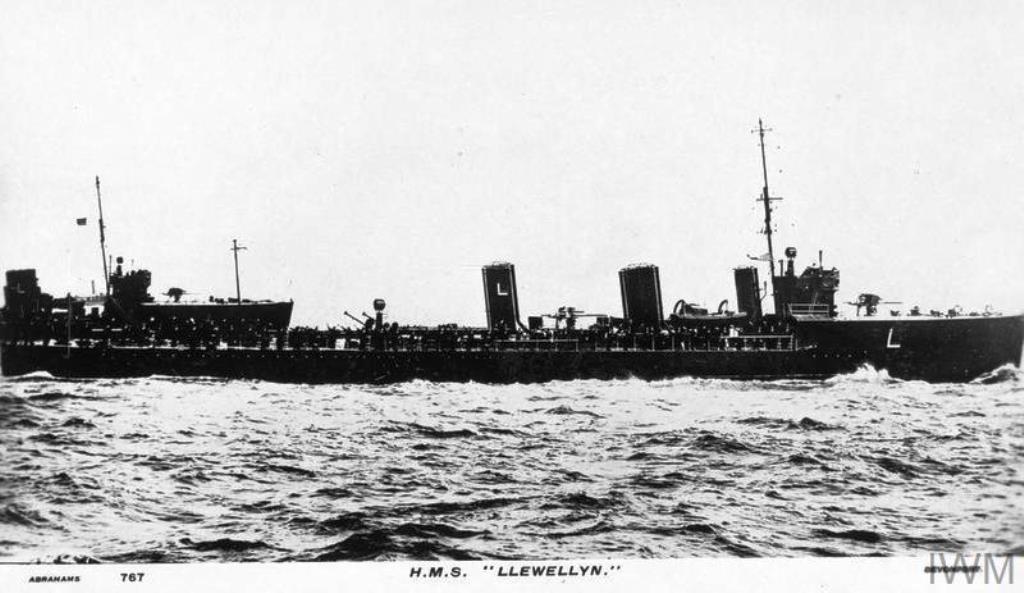
H.M.S. Llewellyn
HMS Llewellyn was a Laforey Class Destroyer launched on the 30th October 1913, built as HMS Picton by William Beardmore but renamed before being launched in 1913. She was sold in March 1922.
HMS Lochinvar
- Type. Destroyer
- Class. Laforey
- Pennant. G06, F42, F52
- Builder. William Beardmore
- Ordered. 1914
- Laid Down. 1915
- Launched. 09/10/1915
- Commissioned. 1915
- Speed. 29 knots
- Fate. Scrapped 25/11/1921
-
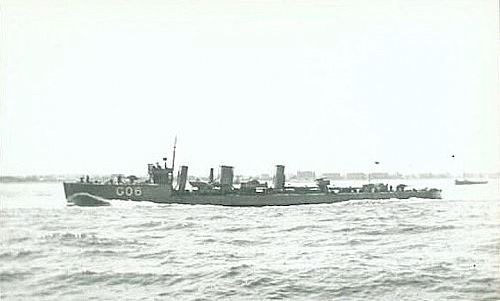
HMS Lochinvar
HMS Lochinvar was a Laforey Class Destroyer built as HMS Malice, but renamed before being launched by William Beardmore on the 9TH October 1915. History: 1915 – 9th Destroyer Flotilla, 9th October 1915 – Served with the 3rd Destroyer Flotilla on completion. She was sold for breaking up on the 25th November 1921.
HMS Lookout
- Type. Destroyer
- Class. Laforey
- Pennant. H24, H62
- Builder. Thornycroft
- Ordered. 1913
- Laid Down. 1914
- Launched. 27/04/1914
- Commissioned. 1914
- Speed. 29 knots
- Fate. Scrapped 24/08/1922
-
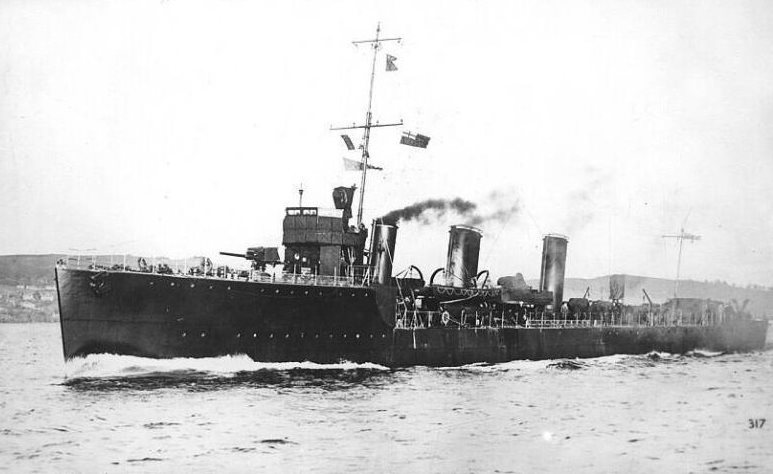
HMS Lookout
HMS Lookout was an L Class Destroyer launched on the 27th April 1914 by Thornycroft. She was sold on the 24th August 1922.
HMS Louis
- Type. Destroyer
- Class. Laforey
- Pennant. H07
- Builder. Fairfield
- Ordered. 1912
- Laid Down. 1913
- Launched. 11/11/1913
- Commissioned. 1914
- Speed. 29 knots
- Fate. Wrecked 31/10/1915
-
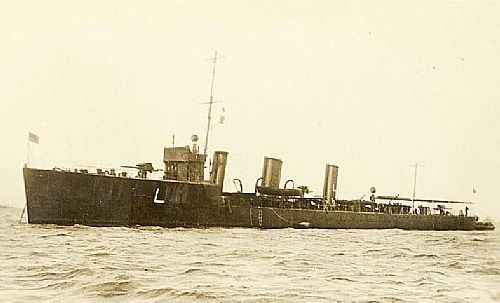
HMS Louis
HMS Louis was a Royal Navy Laforey Class Destroyer, built as HMS Talisman, but renamed on 30 September 1913 before being launched. Built by Fairfield Shipbuilding and Engineering Company, Govan (Yard No 491) and launched 30 December 1913, she was wrecked in Suvla Bay on 31 October 1915 during the Dardanelles campaign.
HMS Loyal
- Type. Destroyer
- Class. Laforey
- Pennant. H80, H63
- Builder. Denny
- Ordered. 1912
- Laid Down. 1913
- Launched. 11/11/1913
- Speed. 29 knots
- Fate. Scrapped 1921
-
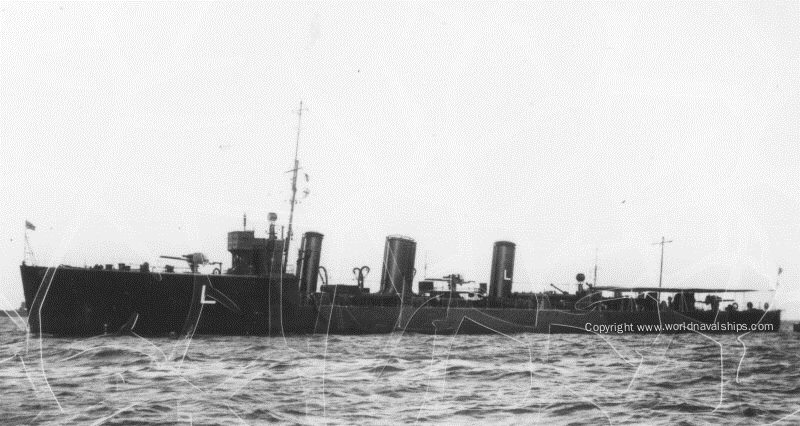
HMS Loyal
HMS Loyal was a Laforey Class Destroyer launched on the 11th November 1913 by William Denny and Brothers. Launched prior to the First World War, she was attached to the Harwich Force and served in the North Sea. Loyal saw action in several engagements, including the Battle off Texel. Loyal was sold for scrap in 1921.
HMS Lucifer
- Type. Destroyer
- Class. Laforey
- Pennant. H22, H64
- Builder. Palmers
- Ordered. 1912
- Laid Down. 1913
- Launched. 29/12/1913
- Speed. 29 knots
- Fate. Sold 1921
-

HMS Lucifer
HMS Lucifer was a Laforey Class Destroyer, Built by Palmers and launched on 29th October 1913. Sold 1921
HMS Lurcher
- Type. Destroyer
- Class. Acheron
- Pennant. H01, H65
- Builder. Yarrow
- Ordered. 1910-11
- Launched. 29/12/1913
- Commissioned. 1914
- Speed. 35 knots
- Fate. Scrapped 09/06/1922
-
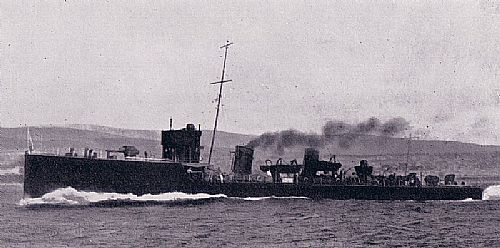
HMS Lurcher
HMS Lurcher was a modified Acheron Class Destroyer built by Yarrow and Company and launched on the 1st January 1912. At the start of World War I Lurcher and Firedrake were assigned to the Eighth Submarine Flotilla under the command of Commodore Keyes, and were based at Parkston Quay, Harwich. Both ships were employed in escorting, towing and exercising with submarines of their flotilla, At the Battle of Heligoland Bight, Lurcher was erroneously feared lost after she’d gone so far into the Ems in search of the enemy. Later, she bolted in to rescue 220 survivors of Mainz. Lurcher survived the war and was sold to J Cashmore of Newport for breaking on 9 June 1921.
HMS Lydiard
- Type. Destroyer
- Class. Laforey
- Pennant. H08, H66
- Builder. Fairfield
- Laid Down. 1913
- Launched. 26/02/1914
- Commissioned. 1914
- Speed. 29 knots
- Fate. Scrapped 1921
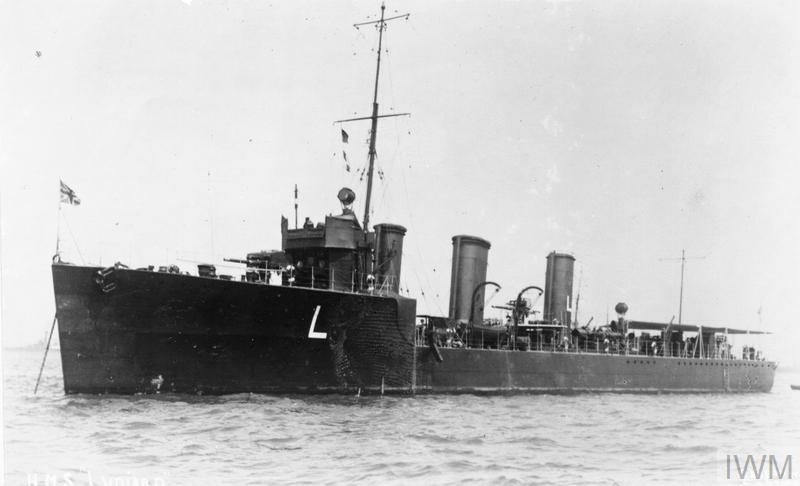
HMS Lydiard © IWM.
HMS Lydiard was a Laforey Class torpedo boat Destroyer of the Royal Navy. She was ordered as the Waverley from Fairfield Shipbuilding and Engineering Company as part of the 1912–13 programme, but was renamed Lydiard before being launched on 26 February 1914. She served in World War I with the 3rd Destroyer Flotilla, and fought at the Battle of Heligoland Bight in 1914, where she was credited with torpedoing the German light cruiser SMS Mainz. She also took part in the Battle of Jutland in 1916, where she formed part of the 9th Destroyer Flotilla, along with fellow Laforey class destroyers Liberty, Landrail and Laurel, supporting Admiral Beatty’s Battle cruisers. She was transferred to escort duties after 1917, and sold for breaking in November 1921.
HMS Lysander
- Type. Destroyer
- Class. Laforey
- Pennant. H93, H68
- Builder. Swan Hunter
- Ordered. 1912
- Laid Down. 1912
- Launched. 18/02/1913
- Commissioned. 1913
- Speed. 29 knots
- Fate. Sold 1922
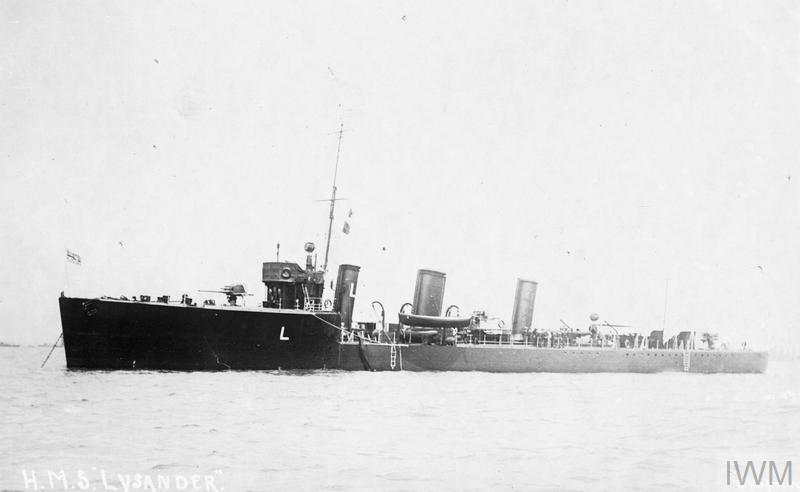
HMS Lysander
© IWM.
HMS Lysander was a Laforey Class Destroyer launched by Swan Hunter on the 8th December 1913 as HMS Ulysses but renamed a few weeks later, She was sold in 1922.
HMS Maenad
- Type. Destroyer
- Class. M
- Pennant. HA7, G26, G27, GA8
- Builder. Denny
- Ordered. 1914
- Laid Down. 1914
- Launched. 10/08/1915
- Commissioned. 1915
- Speed. 35 knots
- Fate. Scrapped 1921
-
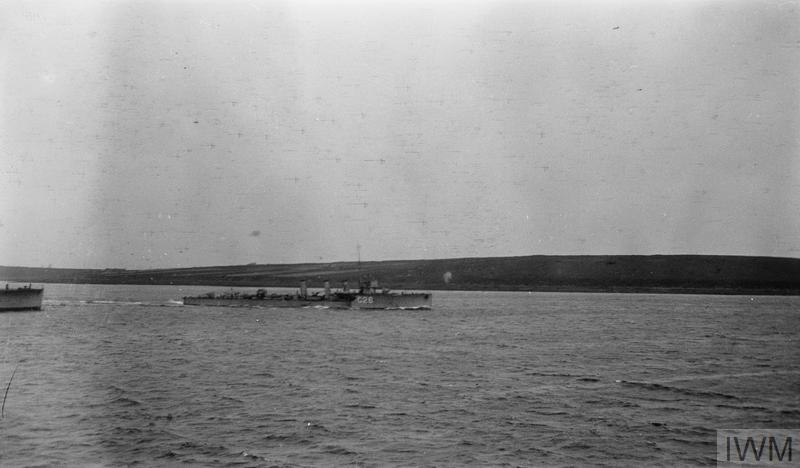
HMS Maenad
HMS Maenad was a M Class Destroyer built by Denny and launched on the 10th August 1915. Maenad was one of the first three destroyers in the Twelfth Destroyer Flotilla when it was first formed in November, 1915. She operated with the Twelfth at the Battle of Jutland. Maenad was reduced to C. & M. Party at Devonport on 15 October, 1919. History: Harwich 3rd Destroyer Flotilla from 1918.
Mameluck
-
- Type. Destroyer
- Class. Spahi
- Pennant.
- Builder. Ateliers & Chantiers de la Loire
- Ordered. 1906
- Laid Down. 1907
- Launched. 10/03/1909
- Commissioned. 1909
- Speed. 28 knots
- Fate. Scrapped 1928
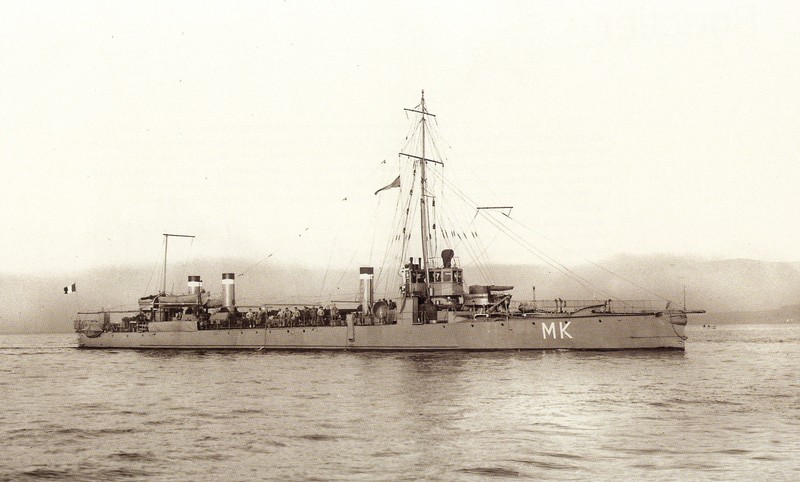
HMS Mameluck
Mameluck was a Spahi-class destroyer of the French Navy. Tasked with escort duties in the Mediterranean Mameluck assigned to the 1st Squadron in June 1911, and a year later she was assigned to the 2nd Destroyer Squadron, of the 1st Fleet. In March 1913 she was assigned to torpedo squadron patrols and to support submarines in the Adriatic. In 1916 she escorted the submarines Faraday and Le Verrier to Milo.
On 14 December 1917, along with Lansquenet, she sank the German U-boat UC-38 off Cape Ducato in the Ionian Sea after the submarine had torpedoed and sunk the light cruiser Châteaurenault
HMS Manly
- Type. Destroyer
- Class. Miranda
- Pennant. H0A, H69, D20
- Builder. Yarrow
- Ordered. 1913
- Laid Down. 1914
- Launched. 12/10/1914
- Commissioned. 1915
- Speed. 35 knots
- Fate. Sold 1921
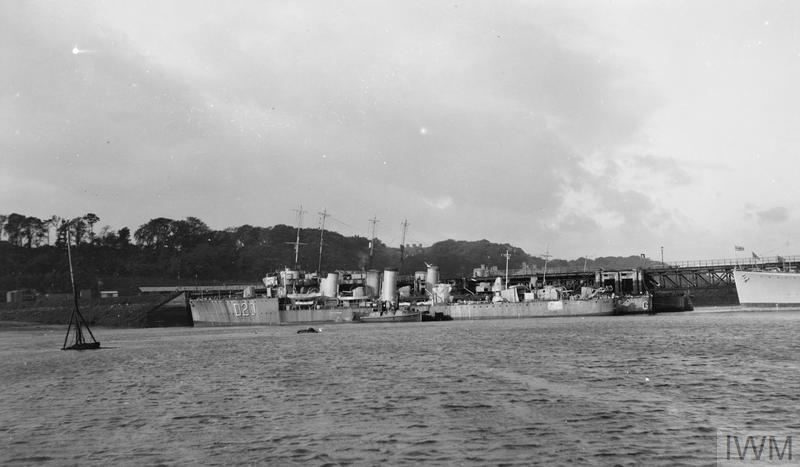
HMS Manly
HMS Manly was an M Class Destroyer built by Yarrow and launched on the 12th October 1914 and sold in 1921.
HMS Mansfield
- Type. Destroyer
- Class. Miranda
- Pennant. H1A, H70, D37
- Builder. Hawthorn Leslie
- Ordered. 1913
- Laid Down. 1914
- Launched. 03/12/1914
- Speed. 35 knots
- Fate. Sold 1921
-
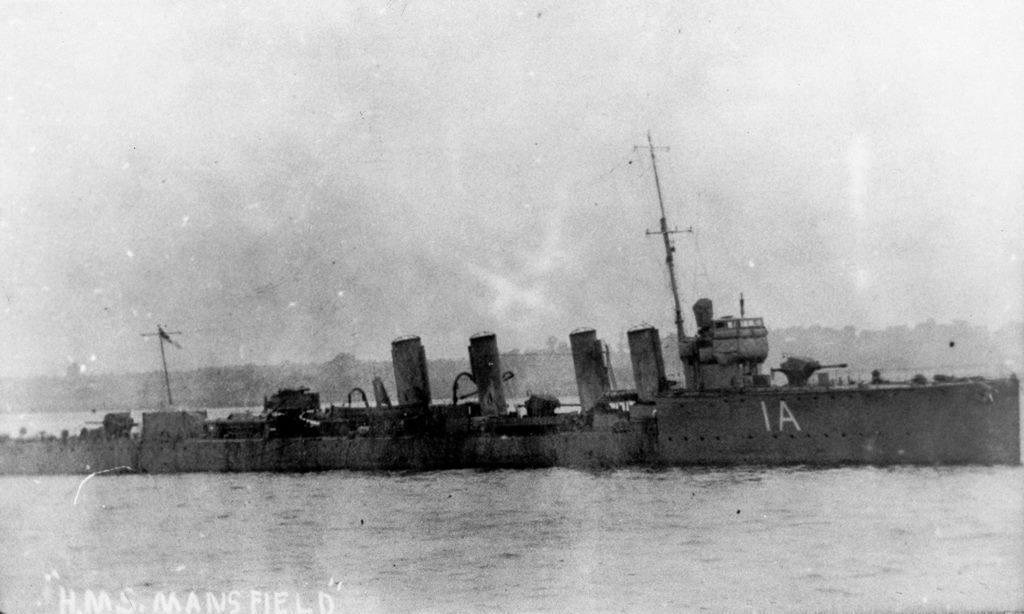
HMS Mansfield
HMS Mansfield was an M Class Destroyer. Built by Hawthorn Leslie, laid down on the 09th July 1913 and launched 3rd December 1914 and completed in April 1915. She was sold on the 26th October 1921.
HMS Marmion
- Type. Destroyer
- Class. Moon
- Pennant. HC2, G04
- Builder. Swan Hunter
- Ordered. 1914
- Laid Down. 1915
- Launched. 28/08/1915
- Commissioned. 1915
- Speed. 35 knots
- Fate. Sank 21/10/1917
-
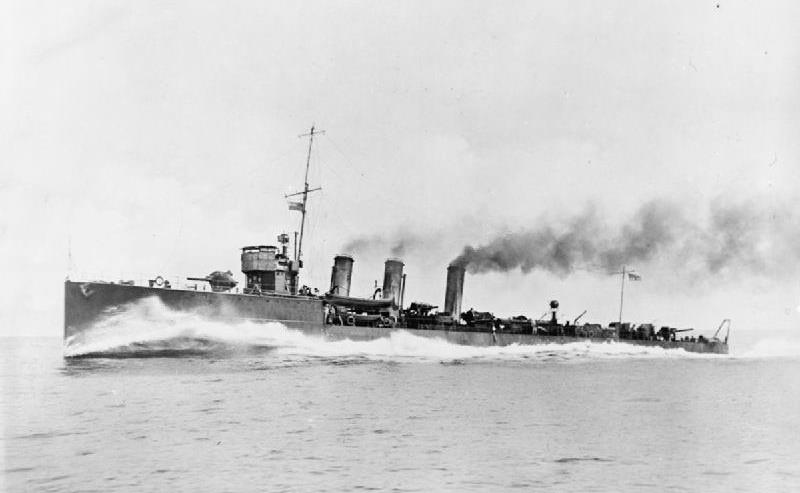
HMS Marmion
HMS Marmion was an Admiralty M Class Destroyer launched on the 28TH August 1915 at Swan Hunter’s Yard. Marmion served as part of the Eleventh Destroyer Flotilla from its inception in September, 1915. She and Musketeer missed participating in the Battle of Jutland, however. Marmion was accidentally rammed by Tirade on 21 October, 1917 when the two were escorting a convoy across the North Sea. Tirade suffered little damage, but Marmion foundered after attempts to take her under tow faltered.
HMS Marvel
- Type. Destroyer
- Class. M
- Pennant. G20, G29, GA3
- Builder. Denny
- Ordered. 1914
- Laid Down. 1915
- Launched. 07/10/1915
- Commissioned. 1915
- Speed. 35 knots
- Fate. Scrapped 1919
-
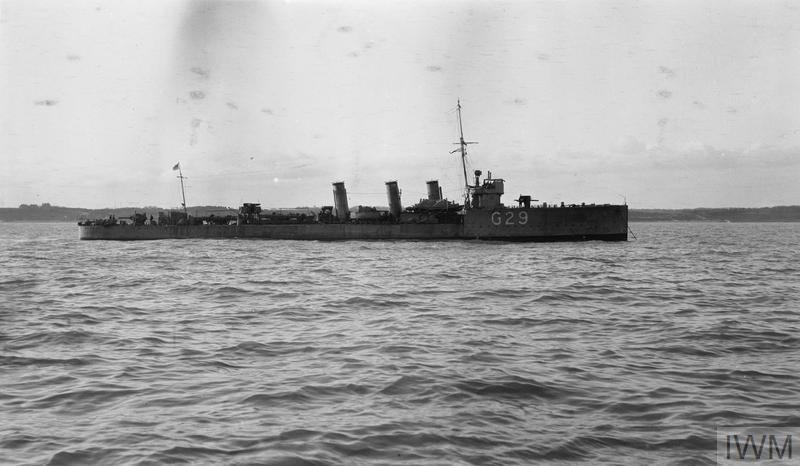
HMS Marvel
HMS Marvel was a M Class Destroyer built by Denny and launched on the 7th October 1915. Marvel joined the Twelfth Destroyer Flotilla in January, 1916, and operated with it at the Battle of Jutland. She was reduced to C. & M. Party at Devonport on 15 October, 1919. History: Harwich 3rd Destroyer Flotilla from 1918.
HMS Mastiff
- Type. Destroyer
- Class. Miranda
- Pennant. H3A, H72, D66
- Builder. Thornycroft
- Ordered. 1913
- Laid Down. 1914
- Launched. 05/09/1914
- Commissioned. 1914
- Speed. 35 knots
- Fate. Scrapped 09/05/1921
-
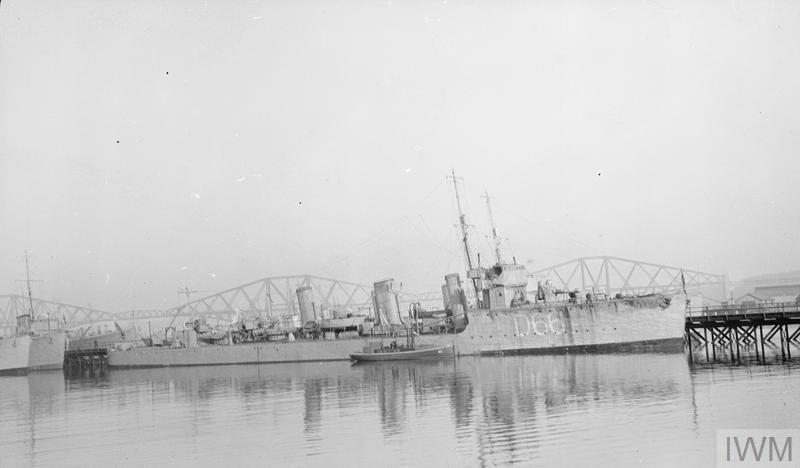
HMS Mastiff
© IWM.
HMS Mastiff was an M Class Destroyer launched on the 5th September 1914 by Thornycroft. In December 1914, Mastiff was one of three M-class assigned to the First Destroyer Flotilla. In January 1915, she transferred to the Third Destroyer Flotilla. In March 1915, she joined the Tenth Destroyer Flotilla, which formed part of the Harwich Striking Force. In January 1916, Mastiff was assigned to temporary duty with the Eleventh Submarine Flotilla supporting the Grand Fleet, before returning to service with the Tenth Destroyer Flotilla at Harwich. HMS Mastiff was paid off at the end of the war and was sold for scrap on the 9th May 1921 after six-and-a-half years of service.
HMS Matchless
- Type. Destroyer
- Class. M
- Pennant. H4A. H73, D47
- Builder. Swan Hunter
- Ordered. 1913
- Laid Down. 1914
- Launched. 05/10/1914
- Commissioned. 1914
- Speed. 35 knots
- Fate. Scrapped 1971

HMS Matchless
HMS Matchless was an M-class destroyer launched on the 5th October 1914 by built Swan Hunter. She served two commissions with the Royal Navy: from February 1942 to August 1944 and from August 1944 to April 1946. She was then held in reserve until August 1957 and eventually sold to the Turkish Navy, who renamed her TCG Kılıç Ali Paşa. She was struck from the Turkish Navy list and scrapped in 1971.
HMS Medea
- Type. Destroyer
- Class. M
- Pennant. H9C, H74
- Builder. Fairfield
- Laid Down. 1914
- Launched. 30/01/1915
- Speed. 35 knots
- Fate. Scrapped 09/05/1921
-
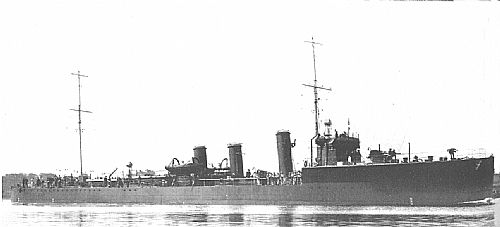
HMS Medea
HMS Medea was laid down as the Kriti, Yard No 429 by John Brown at Clydebank for the Greek Navy on 6th of April 1914, she was purchased by the Admiralty in August 1914. Medea was launched on the 30th of January 1915. Powered by 3 shaft Brown-Curtis turbines with 3 Yarrow oil boilers providing 25,000shp giving 32 knots. Commissioned on the 22nd of June 1915 she joined the 10th Destroyer Flotilla at Harwich. Between 1916 and 1918 she served with the 10th Submarine Flotilla, based at Southbank on the Tees. Medea was sold on the 9th of May 1921 to Ward, Milford Haven and was broken up in 1922.
HMS Medusa
-
- Type. Destroyer
- Class. M
- Pennant. H90
- Builder. John Brown
- Ordered. 1914
- Laid Down. 1914
- Launched. 27/03/1915
- Commissioned. 1915
- Speed. 35 knots
- Fate. Sank 25/03/1916

HMS Medusa
HMS Medusa was a Medea Class Destroyer, Built by John Brown on the Clyde, and launched on the 27th March 1915 and commissioned July 1915. Medusa sank on the 25th March 1916 following collision with the destroyer HMS Laverock off the Schleswig coast.
HMS Melampus
- Type. Destroyer
- Class. M
- Pennant. H44, H75
- Builder. Fairfield
- Ordered. 1913
- Laid Down. 1914
- Launched. 16/12/1914
- Commissioned. 1915
- Speed. 32 knots
- Fate. Scrapped 22/09/1921
-
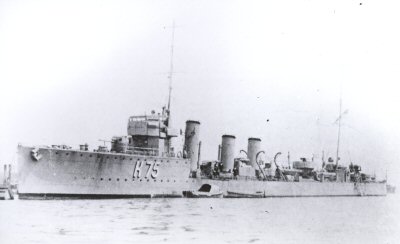
HMS Melampus
HMS Melampus was a Medea Class Destroyer laid down for the Greek Navy by Fairfield Shipbuilding and Engineering Company, Govan. She was launched as 16 December 1914 and completed for service in the Royal Navy as HMS Melampus on 29 June 1915. In 1917 she accidentally rammed and sank the C-class submarine C16. She was sold for breaking up 22 September 1921.
HMS Melpomene
- Type. Destroyer
- Class. M
- Pennant. H09, H76, H50
- Builder. John Brown
- Ordered. 1914
- Laid Down. 1914
- Launched. 01/01/1915
- Commissioned. 1915
- Speed. 35 knots
- Fate. Scrapped 09/05/1921
-
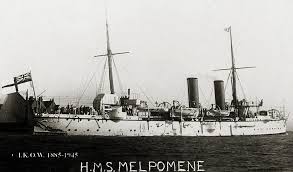
HMS Melpomene
HMS Melpomene was a Medea Class Destroyer, built for the Greek Navy as the Samos. Launched on the 1st January 1915 by John Brown & Company, She was broken up on the 9th May 1921.
HMS Menace
-
- Type. Destroyer
- Class. M
- Pennant. H7C, G28, G30, G6A
- Builder. Swan Hunter
- Ordered. 1914
- Laid Down. 1914
- Launched. 09/11/1914
- Commissioned. 1915
- Speed. 35 knots
- Fate. Scrapped 1919

HMS Menace
HMS Menace was a M Class Destroyer built by Swan Hunter 9th November 1914. Menace joined the Twelfth Destroyer Flotilla in April, 1916, and operated with it at the Battle of Jutland. She reduced to C. & M. Party at the Nore on 3 December, 1919. History: Harwich 3rd Destroyer Flotilla from 1918.
HMS Mentor
- Type. Destroyer
- Class. M
- Pennant. H6A, H77, D54
- Builder. Hawthorn Leslie
- Ordered. 1913
- Laid Down. 1914
- Launched. 21/08/1914
- Commissioned. 1914
- Speed. 35 knots
- Fate. Scrapped 09/05/1921
-
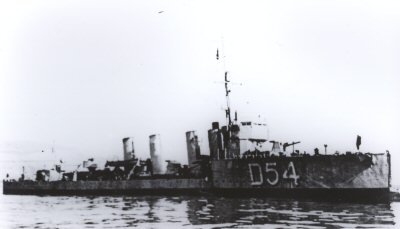
HMS Mentor
HMS Mentor was a Hawthorn M Class Destroyer launched on the 21st August 1914 by Hawthorn Leslie. She served on the First Ostend Raid and the Battle of Dogger Bank (1915); she was broken up in 1921.
HMS Meteor
- Type. Destroyer
- Class. M
- Pennant. H7A, H78, D84
- Builder. Thornycroft
- Ordered. 1913
- Laid Down. 08/05/1913
- Launched. 24/07/1915
- Commissioned. 1915
- Speed. 35 knots
- Fate. 09/05/1921
-

HMS Meteor
HMS Meteor was an M Class Destroyer built by Thornycroft & Company, Southampton and was launched on the 24th July 1914. HMS Meteor saw extensive service throughout the First World War. She maintained continuous operations both as a convoy escort, and in Harbour protection. Served with the Harwich Force 1914-1917 as part of the 20th Flotilla. She was converted to a minelayer in 1917 and eventually sold for scrapping in May 1921.
HMS Michael
- Type. Destroyer
- Class. M
- Pennant. HC5, G07, HA1
- Builder. Thornycroft
- Ordered. 1914
- Laid Down. 1915
- Launched. 19/05/1915
- Commissioned. 1915
- Speed. 35 knots
- Fate. Scrapped 1919
-

HMS Michael
HMS Michael was a M Class Destroyer launched by Thornycroft on the 19th May 1915. She fought at the Battle of Jutland, screening the Battle Fleet as one of the 14 “M” class destroyers of the Eleventh Destroyer Flotilla. Reduced to C. & M. Party at Devonport on 15 October,1919. History: Harwich 3rd Destroyer Flotilla From 1918.
HMS Minos
- Type. Destroyer
- Class. M
- Pennant. H9A, H81
- Builder. Yarrow
- Ordered. 1913
- Laid Down. 1914
- Launched. 06/08/1914
- Commissioned. 1914
- Speed. 37 knots
- Fate. Scrapped 1920
-
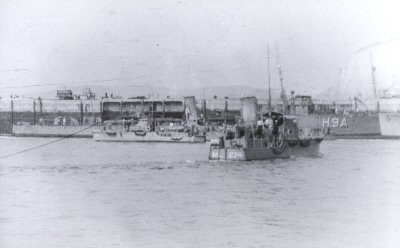
HMS Minos
HMS Minos was a Miranda Class Destroyer built by Yarrow and launched on the 6th August 1914 She was assigned to the First Destroyer Flotilla, but they moved out to Third Destroyer Flotilla in January, and then to the Tenth Destroyer Flotilla in March, 1915.
Minos was sold to Ward, Hayle for breaking up in 1920.
HMS Miranda
- Type. Destroyer
- Class. M
- Pennant. HA0, H83, D24
- Builder. Yarrow
- Ordered. 1913
- Laid Down. 1914
- Launched. 27/05/1914
- Commissioned. 1914
- Speed. 37 knots
- Fate. Scrapped 1921
-

HMS Miranda
HMS Miranda was a Miranda Class Destroyer built by Yarrow and launched on the 27th May 1914. In September 1914, Miranda was selected to join Third Destroyer Flotilla as the half-flotilla leader and be fitted with a Mark II W/T set, longer mast, No. 2 set of flags and two additional signal ratings. At the Battle of Dogger Bank on 24 January 1915, Miranda fired a torpedo at 11:00am from 5,500 yards with 135R and 20 knot target, securing a hit under the bridge of its target.
Miranda was paid off 19 November 1919.
HMS Moorsom
- Type. Destroyer
- Class. M
- Pennant. HA2, H84, D27
- Builder. John Brown
- Ordered. 1913
- Launched. 20/12/1914
- Commissioned. 1915
- Speed. 37 knots
- Fate. Sold 1921
-
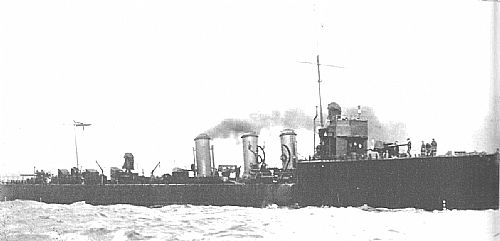
HMS Moorsom
HMS Moorsom was an Miranda Class Destroyer launched on the 20th December 1914,At the Battle of Jutland, Moorsom operated as one of six Harwich Force destroyers screening the Second Battle Cruiser Squadron. Sometime in 1918, a torpedo was fired while the tube was trained inboard, in Harbour. Moorsom was sold in 1921.
HMS Morris
- Type. Destroyer
- Class. M
- Pennant. HA3, H85, D35
- Builder. John Brown
- Ordered. 1913
- Laid Down. 1914
- Launched. 19/11/1914
- Commissioned. 1915
- Speed. 37 knots
- Fate. Sold 1921
-
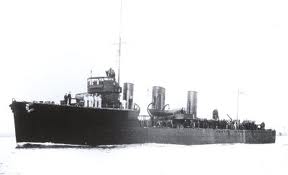
M Class Destroyer
HMS Morris was a Miranda Class Destroyer launched on the 19th November 1914 by Hawthorn Leslies. She fought at the Battle of Jutland with the Tenth Destroyer Flotilla under Lieutenant-Commander Edward S. Graham, one of six Harwich Force destroyers screening the Second Battle Cruiser Squadron. She fought at the Action of 23 July, 1916, a running night action where she pursued a superior force of German destroyers. She was sold in 1921.
HMS Munster
- Type. Destroyer
- Class. M
- Pennant. H8C, G33, G7A
- Builder. Thornycroft
- Ordered. 1914
- Laid Down. 1915
- Launched. 24/11/1915
- Commissioned. 1916
- Speed. 37 knots
- Fate. Scrapped 1919
-

M Class Destroyer
HMS Munster was a M Class Destroyer built by Thornycroft and launched on the 24th November 1915.Munster joined the Twelfth Destroyer Flotilla in February, 1916, and operated with it at the Battle of Jutland. She was reduced to C. & M. Party at Portsmouth on 17 October, 1919. History: 3rd Destroyer Flotilla from 1918.
HMS Murray
- Type. Destroyer
- Class. M
- Pennant. HA4, H86, D33
- Builder. Palmer
- Ordered. 1913
- Laid Down. 1913
- Launched. 06/08/1913
- Commissioned. 1913
- Speed. 37 knots
- Fate. Sold 1921
-

HMS Murray
HMS Murray was an Admiralty M Class Destroyer launched on the 6th August 1913 by Palmers. Murray Served with the Harwich Force between 1914-1917 and was sold in May 1921.
HMS Myngs
- Type. Destroyer
- Class. M
- Pennant. HA5, H87, D41
- Builder. Palmer
- Ordered. 1913
- Laid Down. 1914
- Launched. 24/09/1914
- Commissioned. 1914
- Speed. 37 knots
- Fate. Sold 1921
-
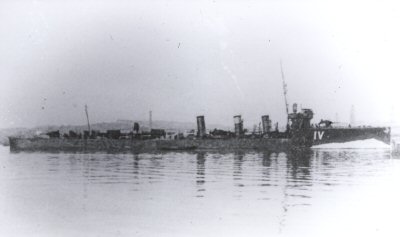
HMS Myngs
HMS Myngs was a Miranda Class Destroyer built by Palmer and launched on the 24th September 1914. History Harwich Force 1914-1917 and was sold on the 9th May 1921.
HMS Napier
- Type. Destroyer
- Class. M
- Pennant. GA0
- Builder. John Brown
- Ordered. 1914
- Laid Down. 1914
- Launched. 27/01/1915
- Commissioned. 1915
- Speed. 37 knots
- Fate. Scrapped 1919
-

M Class Destroyer
HMS Napier was a M Class Destroyer built by John Brown and launched on the 27th January 1915 .Napier joined the Twelfth Destroyer Flotilla in February, 1916, but she missed taking part with her formation at the Battle of Jutland, She was reduced to C. & M. Party at Devonport on 15 October, 1919. History: Harwich 3rd Destroyer Flotilla from 1918.
HMS Nessus
- Type. Destroyer
- Class. M
- Pennant. G00.G37, G36, G5a
- Builder. Swan Hunter
- Ordered. 1914
- Launched. 24/08/1915
- Commissioned. 1915
- Speed. 25.5 knots
- Fate. Sank 08/09/1918
-
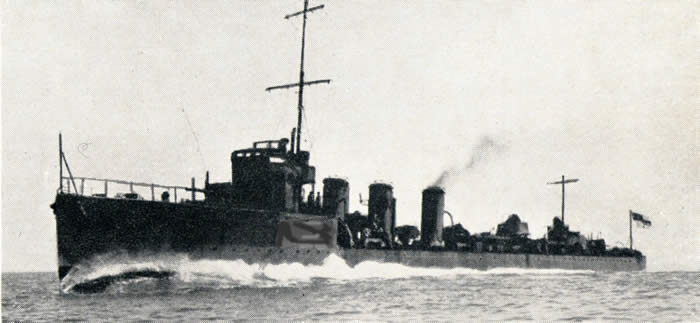
HMS Nessus
HMS Nessus was a M Class Destroyer launched at Swan Hunter on the 24th August 1915, Nessus was one of the first three destroyers in the Twelfth Destroyer Flotilla when it was first formed in November,
History: Harwich 3rd Destroyer Flotilla from 1918.
HMS Nimrod
- Type. Destroyer
- Class. Marksman
- Pennant. H5a, H90
- Builder. Denny
- Ordered. 1914
- Laid Down. 1915
- Launched. 12/04/1915
- Commissioned. 1915
- Speed. 37 knots
- Fate. Sold 1926
-
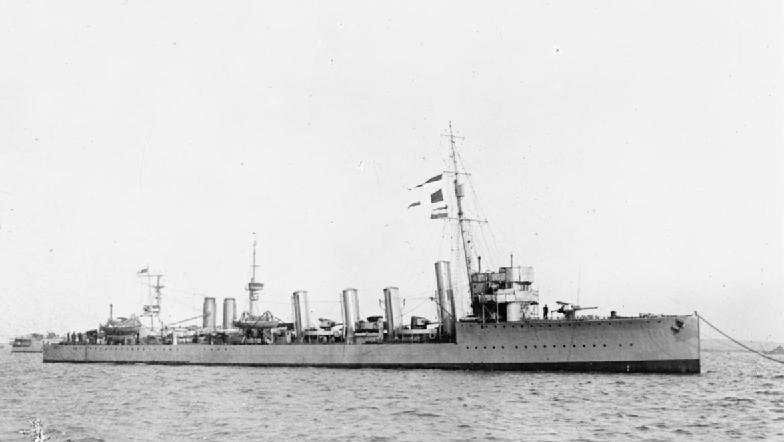
HMS Nimrod
HMS Nimrod was a Marksman class (also known as Lightfoot class) destroyer leader launched on the 12th April 1915 and sold in 1926. History: Harwich 3rd Destroyer Flotilla from 1918.
On commissioning, Nimrod joined the 10th Destroyer Flotilla, part of the Harwich Force as Second leader.
By March 1919, Nimrod was listed as a tender to the depot ship Woolwich, and by June that year she was in reserve at Portsmouth. She was sold for scrap to the Alloa Ship Breaking Company of Rosyth on 5 December 1926.
HMS Noble
- Type. Destroyer
- Class. M
- Pennant. G02, G38. G37, G9a
- Builder. Alexander Stephen
- Ordered. 1914
- Laid Down. 1915
- Launched. 25/11/1915
- Commissioned. 1916
- Speed. 37 knots
- Fate. Scrapped 1919
-

HMS Noble
HMS Noble was a M Class Destroyer built by Alexander Stephen and launched on the 25th November 1915. Noble joined the Twelfth Destroyer Flotilla in February, 1916, and operated with it at the Battle of Jutland. She was reduced to C. & M. Party at Devonport on 15 October, 1919. History: Harwich 3rd Destroyer Flotilla from 1918.
HMS Nonsuch
- Type. Destroyer
- Class. M
- Pennant. G12, G39, G38, G15
- Builder. Palmers
- Ordered. 1914
- Laid Down. 1915
- Launched. 08/12/1915
- Commissioned. 1916
- Speed. 37 knots
- Fate. Scrapped 1919
-
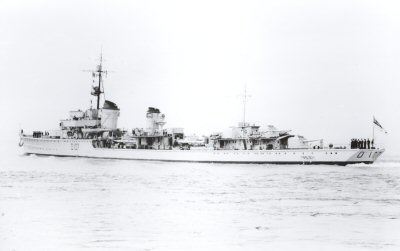
HMS Nonsuch
HMS Nonsuch was built by Palmers and launched on the 8th December 1915. Nonsuch joined the Twelfth Destroyer Flotilla in March, 1916, and operated with it at the Battle of Jutland. She reduced to C. & M. Party at Devonport on 15 October, 1919. History: 3rd Destroyer Flotilla at Harwich from 1918.
HMS North Star
- Type. Destroyer
- Class. M
- Pennant. G16, F45, F53
- Builder. Palmers
- Ordered. 1914
- Laid Down. 1916
- Launched. 09/11/1916
- Commissioned. 1917
- Speed. 37 knots
- Fate. Sank 23/04/1918
-

M Class Destroyer
HMS North Star was a M Class Destroyer built by Palmers and launched on the 9th November 1916 and sank on the 23rd April 1918.
HMS Nugent
- Type. Destroyer
- Class. M
- Pennant. G17, F47, F54, D58
- Builder. Palmers
- Ordered. 1914
- Laid Down. 1916
- Launched. 23/01/1917
- Commissioned. 1917
- Speed. 37 knots
- Fate. Sold 09/05/1921
-
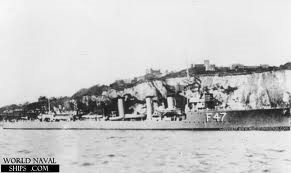
HMS Nugent
HMS Nugent was M Class Destroyer built by Palmers and launched on the 23rd January 1917 and was sold on the 9th May 1921.
HMS Onslaught
- Type. Destroyer
- Class. M
- Pennant. G22, G41, G40, G8A
- Builder. Fairfield
- Ordered. 1914
- Laid Down. 1915
- Launched. 04/12/1915
- Commissioned. 1916
- Speed. 37 knots
- Fate. Sold 17/10/1919
-

M Class Destroyer
HMS Onslaught was M Class Destroyer built by Fairfield Shipbuilding and launched on the 4th December 1915. Onslaught joined the Twelfth Destroyer Flotilla in February, 1916, and operated with it at the Battle of Jutland. In May, 1918, she transferred to the Third Destroyer Flotilla, being then one of just two destroyers. She was reduced to C. & M. Party at Portsmouth on 17 October 1919.
HMS Oriole
- Type. Destroyer
- Class. M
- Pennant. G44, F16, D1A, D06
- Builder. Palmers
- Ordered. 1915
- Laid Down. 1916
- Launched. 31/07/1916
- Commissioned. 1916
- Speed. 37 knots
- Fate. Sold 09/05/1921
-
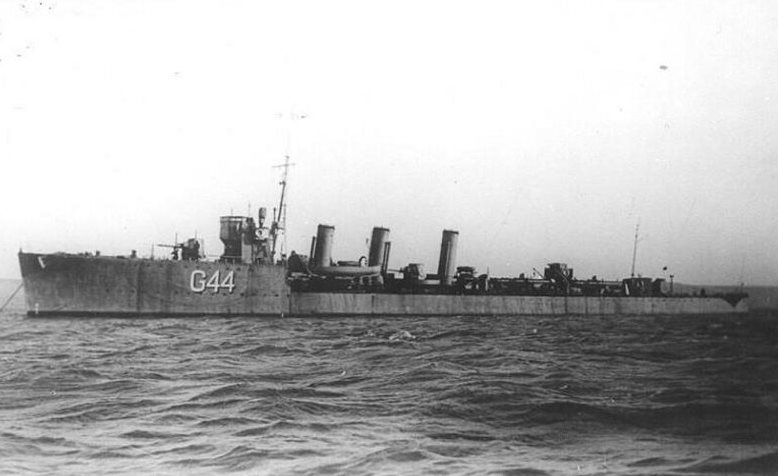
HMS Oriole
HMS Oriole was an M Class Destroyer launched by Palmers on the 31st July 1916 and sold on May 9th 1921.
HMS Petard
- Type. Destroyer
- Class. M
- Pennant. G66, F20, F32, G29, GA7
- Builder. Denny
- Ordered. 1915
- Laid Down. 05/07/1915
- Launched. 24/03/1916
- Commissioned. 1916
- Speed. 34 knots
- Fate. Scrapped 09/05/1921
-

M Class Destroyer
HMS Petard was an Admiralty M class destroyer built by Denny and launched on 24 March 1916.,During the Battle of Jutland, Petard was one of ten destroyers of the 13th Destroyer Flotilla assigned to screen the 1st Battle Cruiser Squadron, following the lead of light cruiser HMS Champion. The first engagement of the battle was between a British force of six battle cruisers and four battleships and lighter vessels commanded by Admiral Beatty and a German squadron of five battle cruisers plus accompanying vessels commanded by Admiral Hipper.
At 4.15pm on 31 May 1916, the opposing fleets sent their destroyers in to deliver a torpedo attack on the opposing line. Petard was one of eight destroyers of the 13th flotilla to respond, along with three destroyers of other formations. The opposing destroyers fought a gun battle in hopes of blunting the enemy’s torpedo attack while striving to deliver their own. Petard fired a torpedo on a high speed setting at a group of four German destroyers, possibly achieving a hit from about 3,000 yards range, and a second at a slower speed against the German battle cruisers from a range of about 9,000 yards. Petard then turned roughly parallel to the German battle cruisers but slightly converging, so as to get ahead of the column before once more turning towards the enemy to fire the remaining two torpedoes. Petard reported that her torpedoes must have crossed the enemy line, but did not claim a hit.
Turning back towards the British ships, Petard passed HMS Nestor, which was also returning but at reduced speed because of damage. It now became apparent that further German ships were approaching, which proved to be the main German High Seas Fleet. Proceeding, Petard approached an oil slick where HMS Laurel was picking up survivors from the battlecruiser HMS Queen Mary, sunk by German gunfire, and picked up one man. Approximately 20 survivors in total were rescued from the 1000 man crew. Petard then returned to her station at the head of the battlecruiser line. she was sold for breaking up on 9 May 1921.
HMS Plover
- Type. Destroyer
- Class. M
- Pennant. G66, F20, F32, G29, GA7
- Builder. Denny
- Ordered. 1915
- Laid Down. 1916
- Launched. 24/03/1916
- Commissioned. 1916
- Speed. 37 knots
- Fate. Scrapped 09/05/1921
-
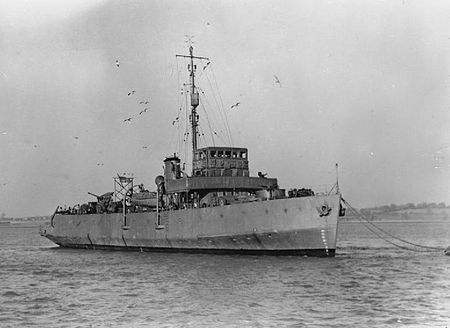
HMS Plover
HMS Plover was a Moon Class Destroyer launched by Hawthorn Leslie on the 3rd of March 1916. Sold for scrapping 9th May 1921.
HMS Radiant
- Type. Destroyer
- Class. R
- Pennant. F59, F56
- Builder. Thornycroft
- Ordered. 1915
- Laid Down. 1916
- Launched. 25/11/1916
- Commissioned. 1917
- Speed. 36 knots
- Fate. Scrapped 1957
-
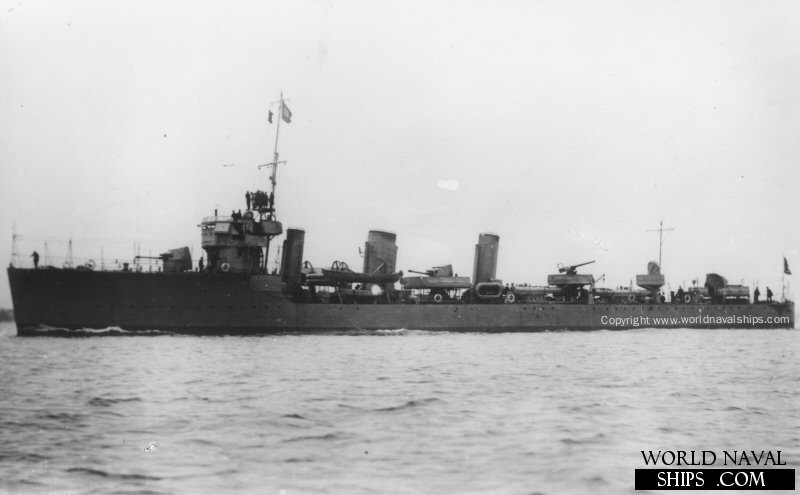
HMS Radiant
HMS Radiant was an R Class Destroyer built by Thornycroft and on the 25th November 1916 she was sold back to Thornycroft on the 21st June 1920, who then sold her to the Thai Navy in September 1920. She was renamed Phra Ruang and was the last of the R class to survive and was eventually scrapped in 1957.
HMS Redgauntlet
- Type. Destroyer
- Class. R
- Pennant. F58, F51, F97
- Builder. Denny
- Ordered. 1915
- Laid Down. 1916
- Launched. 23/11/1916
- Commissioned. 1917
- Speed. 36 knots
- Fate. Scrapped 13/07/1926
-
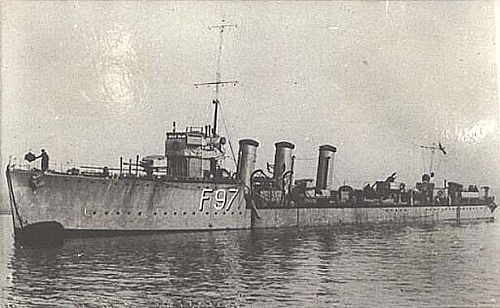
HMS Redgauntlet
HMS Redgauntlet was an R Class Destroyer which was launched on the 23rd November 1916 by William Denny & Brothers Dumbarton and sold for breaking in July 1926.
HMS Redoubt
- Type. Destroyer
- Class. R
- Pennant. F56, F57, H68
- Builder. Doxford
- Ordered. 1915
- Launched. 28/10/1916
- Commissioned. 1917
- Speed. 36 knots
- Fate. Scrapped 13/07/1926
-
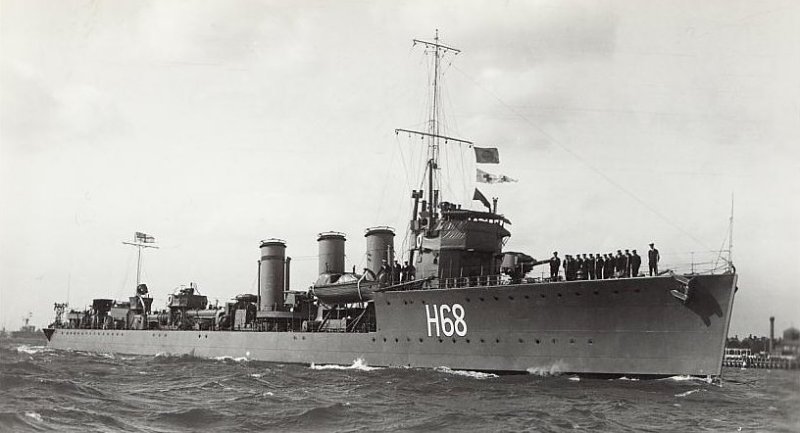
HMS Redoubt
HMS Redoubt was an R Class Destroyer Built by William Doxford & Sons, Sunderland and launched 28 October 1916 and sold for breaking up on the 13th July 1926.
HMS Retriever
- Type. Destroyer
- Class. R
- Pennant. F64, F58
- Builder. Thornycroft
- Ordered. 1915
- Laid Down. 1916
- Launched. 15/01/1917
- Commissioned. 1917
- Speed. 36 knots
- Fate. Scrapped 26/07/1927
-
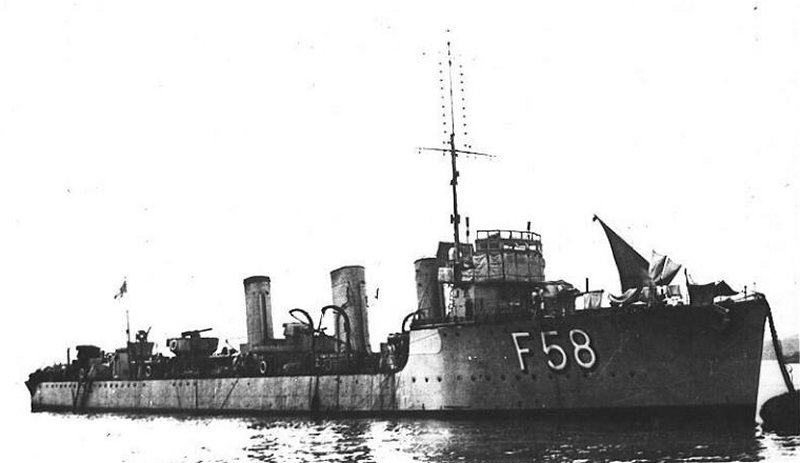
HMS Retriever
HMS Retriever was an R Class Destroyer Launched on the 15th January 1917 by Yarrow Shipbuilders John I. Thornycroft & Company and scrapped on the 26th July 1927.
HMS Satyr
- Type. Destroyer
- Class. R
- Pennant. F51, F59, G52
- Builder. Alexander Stephen
- Ordered. 1915
- Laid Down. 1916
- Launched. 13/04/1917
- Commissioned. 1917
- Speed. 36 knots
- Fate. Scrapped 16/12/1926
-
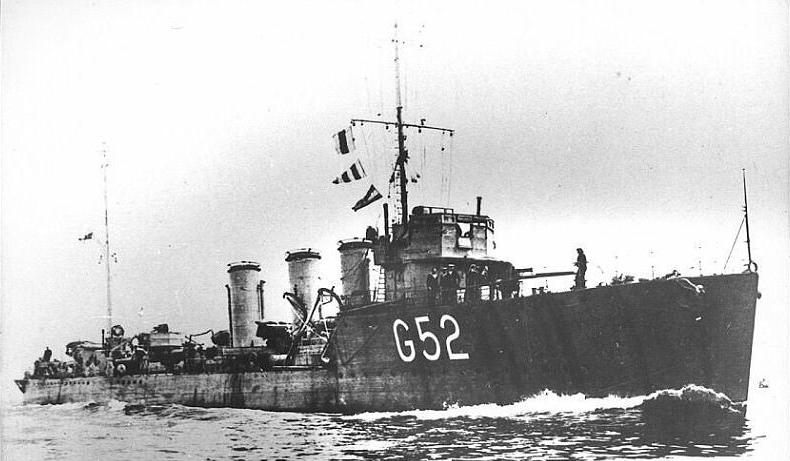
HMS Satyr
HMS Satyr was built by Alexander Stephen and Sons, at Linthouse (Glasgow), was launched on 13 April 1917 and during her trials averaged nearly 36 knots in force 6 winds. ‘Sceptre’ saw action as part of Admiral David Beatty’s force, primarily employed in convoy escort and patrol duty in the North Sea and Atlantic, the title here suggesting she was part of Tyrwhitt’s Harwich Force: her pendant number (as shown here) was F60 only from January 1918 to October 1919. on 17 July 1917, she shot down a Zeppelin and later that year sank an armed German trawler. She was sold for breaking up in 1926.
HMS Scott
- Type. Destroyer
- Class. V&W
- Pennant. F98
- Builder. Cammell Laird
- Ordered. 1916
- Launched. 18/10/1917
- Commissioned. 1917
- Speed. 36.5 knots
- Fate. Sank 15/08/1918
-
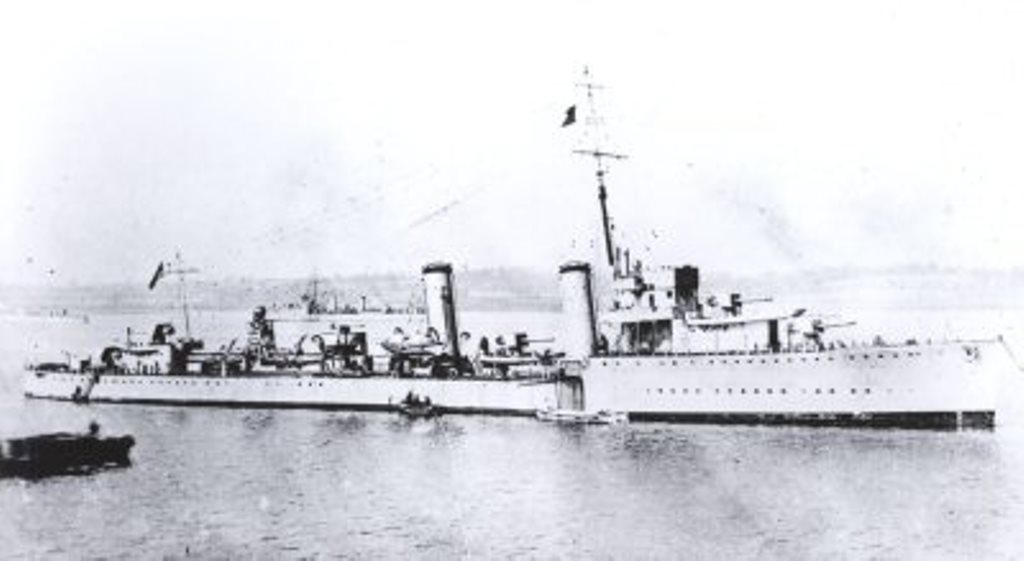
HMS Scott
HMS Scott was an Admiralty type destroyer leader. She was launched in 1917 and sunk in 1918 by a German submarine. HMS Scott was the first of a new destroyer leader class built to be flotilla leaders for the V- and W-class destroyers. She was ordered during the First World War in 1916, and the class would unofficially be named after her. The ship herself was the first to bear the name Scott and was named after Sir Walter Scott, 1st Baronet.
Scott was launched on 18 October 1917; on 15 August 1918, however, she was sunk off the Dutch coast — less than a year after entering service. The cause of her sinking is unclear, it is assumed that a German U-boat torpedoed and sunk her, however it is also possible that she hit a mine. Regardless of cause, the German submarine UC-17 — which had been patrolling and mining the area — is usually credited with her sinking.
HMS Setter
- Type. Destroyer
- Class. R
- Pennant. G98, F55
- Builder. J.S. White
- Ordered. 1915
- Laid Down. 1916
- Launched. 18/08/1916
- Commissioned. 1916
- Speed. 36 knots
- Fate. Sank 17/05/1917
-
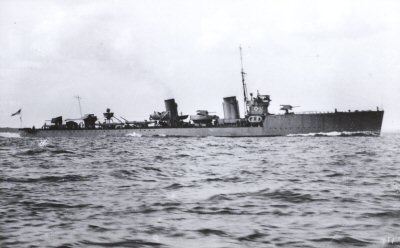
R Class Destroyer
HMS Setter was an R Class Destroyer launched on the 18th August 1916 by JS White, while serving in the Tenth Destroyer Flotilla or the Harwich Force, she was lost in a collision in collision with HMS Sylph off Harwich 17 May 1917.
HMS Shakespeare
- Type. Destroyer
- Class. Shakespeare
- Pennant. F89
- Builder. Thornycroft
- Ordered. 1916
- Laid Down.02/10/1916
- Launched. 07/07/1917
- Commissioned. 1917
- Speed. 33 knots
- Fate. Scrapped 02/09/1936
-

HMS Shakespeare
HMS Shakespeare was laid down on the 2nd of October 1916, launched 7 July 1917 and completed 10 October 1917. Badly damaged by mine in June 1918, sold for breaking up and handed over 2 September 1936.
HMS Sharpshooter
- Type. Destroyer
- Class. R
- Pennant. F48, F61
- Builder. William Beardmore
- Ordered. 1915
- Laid Down. 1916
- Launched. 27/02/1917
- Speed. 36 knots
- Fate. Scrapped 29/04/1927
-
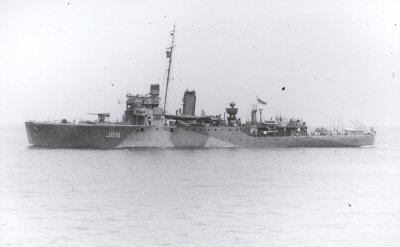
HMS Sharpshooter
HMS Sharpshooter was a R Class Destroyer built by William Beardmore & Company Dalmuir, Launched on Tuesday 27th February 1917. She was reduced to Reserve Complement at Portsmouth on 5 March, 1919.
HMS Simoom
- Type. Destroyer
- Class. R
- Pennant. F57
- Builder. John Brown
- Ordered. 1915
- Laid Down. 1916
- Launched. 30/10/1916
- Commissioned. 1916
- Speed. 36 knots
- Fate. Sank 23/01/1917
-

R Class Destroyer
HMS Simoom was a R Class Destroyer launched by John Brown on the 30th October 1916. Torpedoed 23/1/17.
Able seaman Charles Edward Gurney (J2424) DOB 10/06/1891
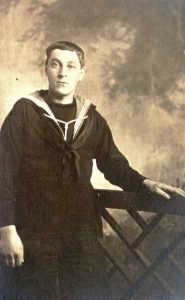
Charles Edward Gurney
Formerly an errand boy, Charles Edward Gurney served in the navy for 12 years firstly as a “Boy”. His first ship was HMS Ganges at Harwich. by June 1910 he was an Ordinary Seaman & by February 1911 Able Seaman. He served on various ships before joining HMS Simoom (also known as “Dido”) which belonged to the Harwich force, on 21 December 1916, under Commander R Y Tyrwhitt. On the night of 22 January 1917, the Simoom was put to sea to intercept a German flotilla consisting of 11 V,S & G destroyers known to be making for Zeebrugge from German ports. The rival forces made contact at 2:45am on 23rd January 1917. In the fight that ensued the S50 ran into a line of 4 British destroyers of which the Simoom was the leading ship. There was an exchange of salvoes & the S50 discharged a torpedo which struck the Simoom & exploded her magazine, causing heavy casualties of which Charles was one. The S50 then escaped in the darkness. The destroyer “Morris” recovered the Simoom’s survivors and she was then torpedoed & sunk by the “Nimrod” under Commander Tyrwhitt’s orders.
Photo and information by Sharon Warren. Charles is commemorated at Chatham Navy Memorial Aged 25.
HMS Skate
- Type. Destroyer
- Class. R
- Pennant. F62, G05, F46, H39
- Builder. John Brown
- Ordered. 1915
- Laid Down. 1916
- Launched. 11/01/1917
- Commissioned. 1917
- Speed. 36 knots
- Fate. Scrapped 20/07/1947
-

HMS Skate
HMS Skate was a built by John Brown Clydebank and launched on 11th January 1917.
22 Sept 1940. picks up 55 survivors from the British tanker Torinia that was torpedoed and sunk by the German submarine U 100 340 miles west of Bloody Foreland.
24 Sept 1940. picks up 45 survivors from the British merchant Scholar, that was torpedoed and damaged on 22 September 1940 by the German submarine U 100 340 miles west of Bloody Foreland. On 23 September 1940 the Scholar was taken in tow by the British rescue tug HMRT Marauder. On the 24th the tow was abandoned and the wreck of the Scholar was scuttled by HMS Skate.
18 June 1941. picks up 70 survivors from the British merchant Norfolk that was torpedoed and sunk by the German submarine U 552 150 miles northwest of Malin Head.
HMS Skilful
- Type. Destroyer
- Class. R
- Pennant. F78, F62
- Builder. Harland & Wolff
- Ordered. 1915
- Laid Down. 1916
- Launched. 03/02/1917
- Commissioned. 1917
- Speed. 36 knots
- Fate. Scrapped 13/07/1926
-
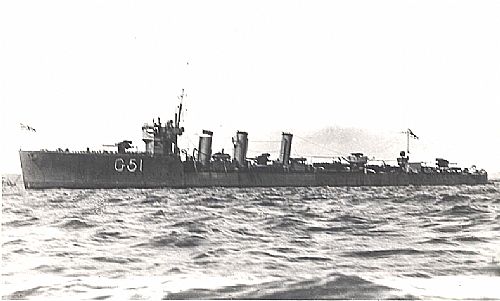
HMS Skilful
HMS Skilful was an R Class Destroyer built by Harland & Wolff and launched on the 3rd February 1917. Sold for breaking 13 July 1926.
HMS Sparrowhawk
- Type. Destroyer
- Class. Acasta
- Pennant. H61
- Builder. Swan Hunter
- Ordered. 1911
- Laid Down. 1911
- Launched. 12/10/1912
- Commissioned. 1912
- Speed. 29 knots
- Fate. Sank 01/06/1916
-

HMS Sparrowhawk
HMS Sparrowhawk was an Acasta Class Destroyer. She was built at the Wallsend yard of Swan, Hunter & Wigham Richardson and launched on 12 October 1912. She joined the 4th Destroyer Flotilla on completion. She was sunk on 1 June 1916 after a collision with HMS Broke at the battle of Jutland. Six of her crew was killed.
HMS Spenser
- Type. Destroyer
- Class. Shakespeare
- Pennant. F90
- Builder. Thornycroft
- Laid Down. 1916
- Launched. 22/09/1917
- Commissioned. 1917
- Speed. 33 knots
- Fate. Scrapped 29/09/1936
-
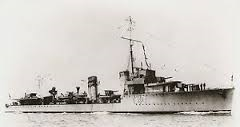
HMS Spenser
HMS Spenser was laid down 9 October 1916, launched 22 September 1917 by Thornycroft and completed 12 December 1917. sold for breaking up and handed over 29 September 1936.
HMS Spitfire
- Type. Destroyer
- Class. Acasta
- Pennant. H41, H1a
- Builder. Swan Hunter
- Ordered. 1911
- Laid Down. 1912
- Launched. 23/12/1912
- Commissioned. 1913
- Speed. 29 knots
- Fate. Scrapped 09/05/1921
-

HMS Spitfire
HMS Spitfire was an Acasta Class Destroyer. She was launched on 23 December 1912 from the Wallsend yard of Swan, Hunter & Wigham Richardson and joined the Fourth Destroyer Flotilla. Amongst the small engagements which happened during the night of 31 May–1 June 1916 during the Battle of Jutland was one between Spitfire and the German battleship Nassau. Spitfire evaded an attempt by Nassau to ram her, but the two ships nevertheless collided and Spitfire was seriously damaged, blast from Nassau’s guns demolishing much of her upper works, but she ripped off a 20 ft (6 m) section of the German ship’s side plating. Both ships survived to return to port.
Spitfire helped in the rescue of survivors from the hospital/evacuation ship Rhodesia (formerly the Union Castle liner Galway Castle) which was torpedoed 160 miles off Fastnet by the German submarine U-82 on 12 September 1918. Spitfire was sold to Ward for scrapping on 9 May 1921.
HMS Springbok
- Type. Destroyer
- Class. R
- Pennant. H40
- Builder. Harland & Wolfe
- Ordered. 1915
- Laid Down. 1916
- Launched. 09/03/1917
- Commissioned. 1917
- Speed. 36 knots
- Fate. Scrapped 16/12/1926
-
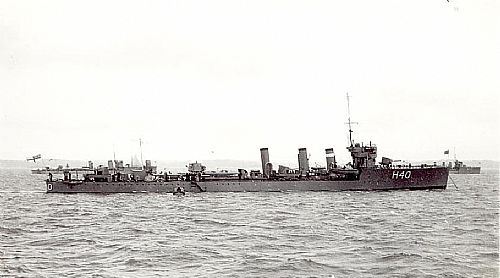
HMS Springbok
HMS Springbok was a R Class Destroyer launched on Friday 9th March 1917 by Harland and Wolff, Govan and sold for breaking up 16 December 1926.
HMS Starfish
- Type. Destroyer
- Class. R
- Pennant. F60
- Builder. Hawthorn
- Ordered. 1915
- Laid Down. 1915
- Launched. 27/09/1916
- Commissioned. 1916
- Speed. 36 knots
- Fate. Scrapped 21/04/1928
-

R Class Destroyer
HMS Starfish was a R Class Destroyer built by Hawthorn Leslie and launched on the 27th September 1916, sold for breaking up 21 April 1928.
HMS Stork
- Type. Destroyer
- Class. R
- Pennant. F66
- Builder. Hawthorn
- Ordered. 1915
- Laid Down. 1916
- Launched. 15/11/1916
- Commissioned. 1917
- Speed. 36 knots
- Fate. Scrapped 07/10/1927
-
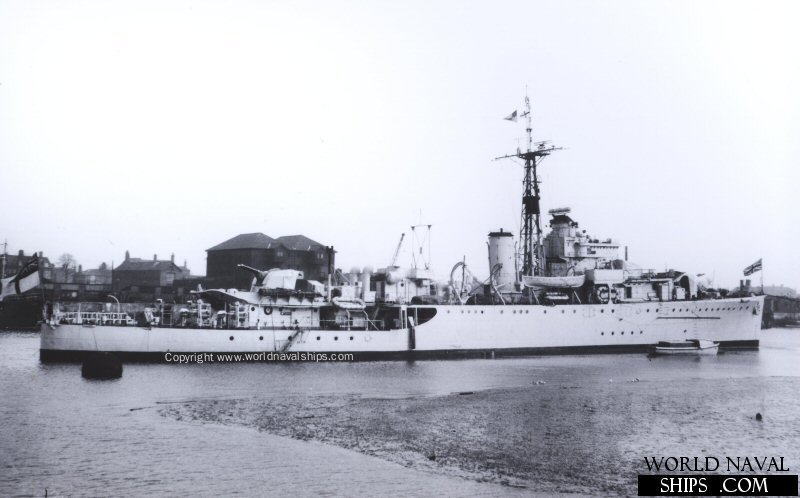
HMS Stork
HMS Stork was an R Class, destroyer built by Hawthorn Leslie and launched on the 15th November 1916 and Sold for breaking on the 7th October 1927 at Cashmore of Newport.
HMS Strongbow
- Type. Destroyer
- Class. R
- Pennant. G44
- Builder. Yarrow
- Ordered. 1915
- Laid Down. 1916
- Launched. 30/09/1916
- Commissioned. 1916
- Speed. 36 knots
- Fate. Sank 17/10/1917
-
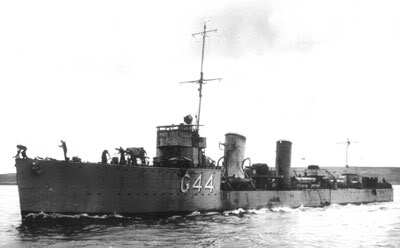
HMS Strongbow
HMS Strongbow was an Admiralty R-class Destroyer, launched on the 30th September 1916 by Yarrow Shipbuilders and was sunk on the 17th October 1917.
HMS Sturgeon
- Type. Destroyer
- Class. R
- Pennant. F49, G17, F47
- Builder. Alexander Stephen
- Ordered. 1915
- Laid Down. 1916
- Launched. 11/01/1917
- Commissioned. 1917
- Speed. 36 knots
- Fate. Scrapped 16/12/1926
-

R Class Destroyer
HMS Sturgeon was a R Class Destroyer built by Alexander Stephen and Sons, Linthouse, Govan and launched on the 11th January 1917. She was reduced to complement on 16 August, 1920.
HMS Surprise
- Type. Destroyer
- Class. R
- Pennant. F69, F66
- Builder. Yarrow
- Ordered. 1915
- Laid Down. 1916
- Launched. 25/11/1916
- Commissioned. 1917
- Speed. 36 knots
- Fate. Sank 23/12/1917
-

R Class Destroyer
HMS Surprise was launched on the 25th November 1916 by Yarrow, Mined in the North Sea 23rd December 1917.
HMS Swallow
- Type. Destroyer
- Class. S
- Pennant. D14
- Builder. Scott’s
- Ordered. 1917
- Laid Down. 1918
- Launched. 01/08/1918
- Commissioned. 1918
- Speed. 36 knots
- Fate. Scrapped 1936
-
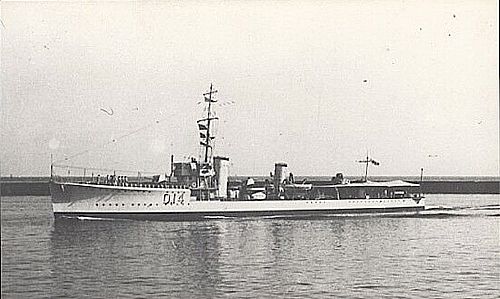
HMS Swallow
HMS Swallow was a S Class Destroyer launched on the 01st August 1918 by Scotts of Greenock. handed over to the breakers in part payment for RMS Majestic in 1936, and subsequently broken up.
HMS Swordfish
- Type. Destroyer
- Class. Swordfish
- Pennant.
- Builder. Armstrong Whitworth
- Ordered. 1893
- Laid Down. 04/06/1894
- Launched. 27/02/1895
- Commissioned. 1896
- Speed. 27 knots
- Fate. Scrapped 1910
-
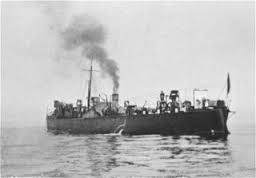
HMS Swordfish
HMS Swordfish was one of two Swordfish-class Destroyers which served with the Royal Navy. She was launched on February 27, 1895 by Armstrong Mitchell and Co at Elswick and sold off in 1910. Swordfish was based at Chatham in 1901, also serving at Sheerness and Portsmouth. The two Armstrong-built Twenty-seven knotters were not popular in service, with Armstrong’s not being invited to tender for the Thirty-knot destroyers required in the next few shipbuilding programmes. While most of the 27-knotters mounted their full armament of 1 × 12 pounder (76 mm) gun, 5 × 6-pounder guns and two 18-in torpedo tubes, Swordfish, owing to concerns about stability, tended to only carry a single torpedo tube. By 1905, it was stated by the Rear Admiral (Destroyers), that Swordfish was one of a number of destroyers that were “..all worn out” and that “every shilling spent on these old 27-knotters is a waste of money”. The ship’s speed dropped during service, with maximum speed falling to 18 1⁄2 knots (21.3 mph; 34.3 km/h) by 1909.
Swordfish was sold for scrap to John Cashmore Ltd of Newport, Wales on 11 October 1910.
HMS Sylph
- Type. Destroyer
- Class. R
- Pennant. G87
- Builder. Harland & Wolfe
- Ordered. 1915
- Launched. 15/11/1916
- Fate. Scrapped 16/12/1926
-
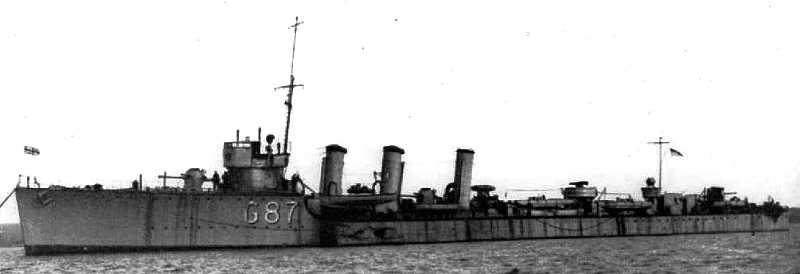
HMS Sylph
HMS Sylph was an R Class Destroyer built by Harland & Wolff Ltd Govan, Yard and Launched on Wednesday the 15th of November 1916. Sold for breaking up 16 December 1926, but stranded while under tow en route to breakers 28 January 1927 and broken up at Aberavon.
HMS Sybille
- Type. Destroyer
- Class. R
- Pennant. F77
- Builder. Yarrow
- Ordered. 1915
- Launched. 05/02/1917
- Commissioned. 1917
- Speed. 36 knots
- Fate. Scrapped 05/11/1926
-
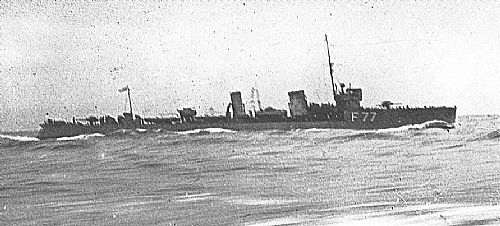
HMS Sybille
HMS Sybille was an R Class Destroyer laid down in August 1915 and launched on the 5th of February 1917. Sold for breaking up 5 November 1926.
HMS Tactician
- Type. Destroyer
- Class. S
- Pennant. G54
- Builder. William Beardmore
- Ordered. 1917
- Laid Down. 1918
- Launched. 07/08/1918
- Commissioned. 1918
- Speed. 36 knots
- Fate. Scrapped 1931
-
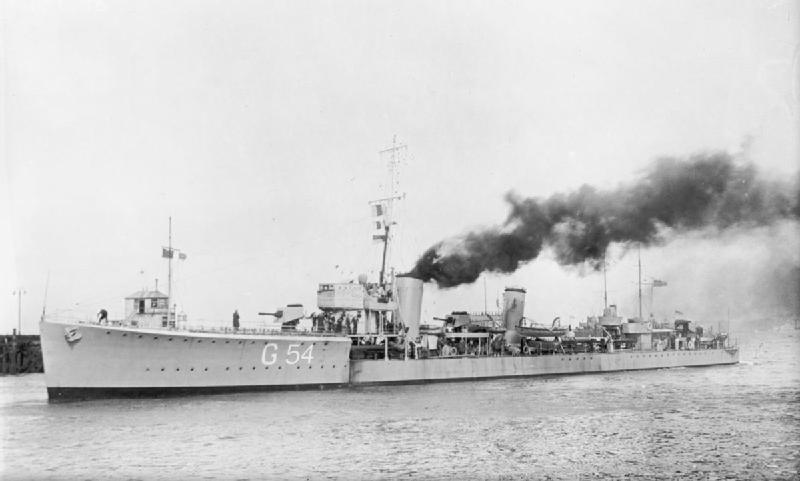
HMS Tactician
HMS Tactician was a S class Destroyer built by William Beardmore and launched on the 7th August 1918. Tactician was sold for scrap in 1931.
HMS Talisman
- Type. Destroyer
- Class. Talisman
- Pennant. G08, F44, F68, G4A
- Builder. Hawthorn Leslie
- Ordered. 1914
- Launched. 15/07/1915
- Commissioned. 1915
- Speed. 32 knots
- Fate. Scrapped 1920
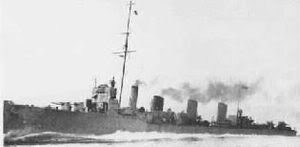
Talisman Class Destroyer
HMS Talisman was a Talisman Class Destroyer built by Hawthorn & Leslie and launched on the 15th July 1915. She was reduced to a C. & M. Party at the Nore on 18 March, 1920. History: 3rd Destroyer Flotilla at Harwich from 1918.
HMS Tarpon
- Type. Destroyer
- Class. R
- Pennant. F72, F22, F79
- Builder. John Brown
- Ordered. 1916
- Laid Down. 1916
- Launched. 10/03/1917
- Commissioned. 1917
- Speed. 36 knots
- Fate. Scrapped 04/08/1927
-

R Class Destroyer
HMS Tarpon was built by John brown and launched on the 10th March 1917.Tarpon was assigned to the Thirteenth Destroyer Flotilla. She suffered a prolonged disappearance from the Navy List from August 1917 until March, 1918 when she was placed in the new Twentieth Destroyer Flotilla operating out of the Humber. She was re-commissioned on 1 February, 1920, tender to Vernon.
HMS Tartar
- Type. Destroyer
- Class. Tribal
- Pennant. H29,D08,D86
- Builder. Thornycroft
- Ordered.1905-06
- Launched. 25/06/1907
- Commissioned. 1907
- Speed. 33 knots
- Fate. Scrapped 1921
-
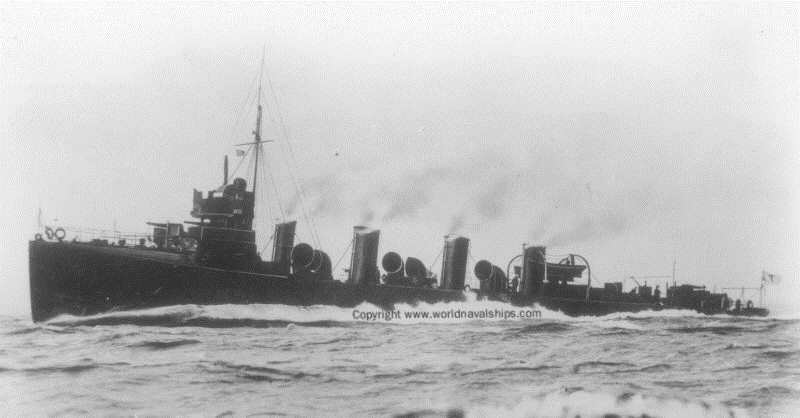
HMS Tartar
HMS Tartar was a Tribal class destroyer of the Royal Navy launched in 1907 and sold in 1921. During the First World War she served in the North Sea and the English Channel with the 6th Destroyer Flotilla.
HMS Telemachus
- Type. Destroyer
- Class. R
- Pennant. F86, F23, F81
- Builder. John Brown
- Ordered. 1916
- Laid Down. 1916
- Launched. 21/04/1917
- Commissioned. 1917
- Speed. 36 knots
- Fate. Scrapped 26/07/1927
-

R Class Destroyer
HMS Telemachus was a R Class Destroyer built by John brown and launched on the 21st April 1917.Telemachus joined the Thirteenth Destroyer Flotilla in July, 1917. In March, 1918, she went to the Twentieth Destroyer Flotilla, part of the East Coast Forces. She was reduced to Reserve at Devonport in February of 1920.
HMS Tempest
- Type. Destroyer
- Class. R
- Pennant. F76, F72
- Builder. Fairfield
- Ordered. 1916
- Laid Down. 1916
- Launched. 26/01/1917
- Commissioned. 1917
- Speed. 36 knots
- Fate. Scrapped 28/01/1937
-

R Class Destroyer
HMS Tempest was a R Class Destroyer built by Fairfield and launched on the 26th January 1917. and was sold for scrapping in 1937.
HMS Tetrarch
- Type. Destroyer
- Class. R
- Pennant. F87, F74
- Builder. Harland & Wolff
- Ordered. 1916
- Laid Down. 1916
- Launched. 20/04/1917
- Commissioned. 1917
- Speed. 36 knots
- Fate. 28/07/1934
-

R Class Destroyer
HMS Tetrarch was an R Class Destroyer launched on the 20th April 1917 by Harland & Wolff, Belfast. Sold for Scrapping in 1934.
HMS Termagant
- Type. Destroyer
- Class. Talisman
- Pennant. G24, F47, F73, D36
- Builder. Hawthorn Leslie
- Ordered. 1914
- Laid Down. 1915
- Launched. 26/08/1915
- Commissioned. 1915
- Speed. 32 knots
- Fate. Scrapped 1923
-

R Class Destroyer
HMS Termagant was a Talisman Class Destroyer built by Hawthorn Leslie and launched on the 26th of August 1914 and sold for Scrap on the 25th of January 1923.
HMS Teviot
- Type. Destroyer
- Class. River
- Pennant. N26, D33, D88
- Builder. Yarrow
- Ordered. 1901
- Laid Down. 18/08/1902
- Launched. 07/11/1903
- Commissioned. 1904
- Speed. 25.5 knots
- Fate. Scrapped 23/06/1919
-
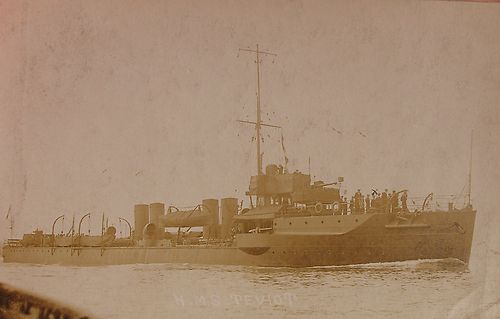
HMS Teviot
HMS Teviot was a Yarrow type River Class Destroyer She was laid down on 18 August 1902 at the Yarrow shipyard at Poplar and launched on the 7 November 1903. After commissioning she was assigned to the East Coast Destroyer Flotilla of the 1st Fleet and based at Harwich. In April 1909 she was assigned to the 3rd Destroyer Flotilla of the 1st Fleet on its formation at Harwich. She remained until displaced by a Basilisk Class destroyer by May of 1912. She was assigned to the 5th Destroyer Flotilla in the 2nd Fleet with a nucleus crew.
In early 1914 after being displaced by G Class destroyers she was assigned to the 9th Destroyer Flotilla based at Chatham tendered to HMS St George. The 9th Flotilla was a Patrol Flotilla tasked with anti-submarine and counter mining patrols in the Firth of Forth area. By September of 1914, she was deployed to Portsmouth and the Dover Patrol. Here she provided anti-submarine, counter mining patrols and defended the Dover Barrage.
In August of 1915 with the amalgamation of the 7th and 9th Flotillas, she was assigned to the 1st Destroyer Flotilla when it was redeployed to Portsmouth in November 1916. She was equipped with depth charges for employment in anti-submarine patrols, escorting of merchant ships and defending the Dover Barrage. In the spring of 1917 as the convoy system was being introduced the 1st Flotilla was employed in convoy escort duties for the English Channel for the remainder of the war.
In 1919 she was paid off and laid up in reserve awaiting disposal. On 23 June, 1919 she was sold to Thomas W. Ward of Sheffield for breaking at Morecombe, Lancashire.
HMS Thisbe
- Type. Destroyer
- Class. R
- Pennant. F82, F75
- Builder. Hawthorn Leslie
- Ordered. 1916
- Laid Down. 1916
- Launched. 08/03/1917
- Commissioned. 1916
- Speed. 36 knots
- Fate. Scrapped 31/08/1936
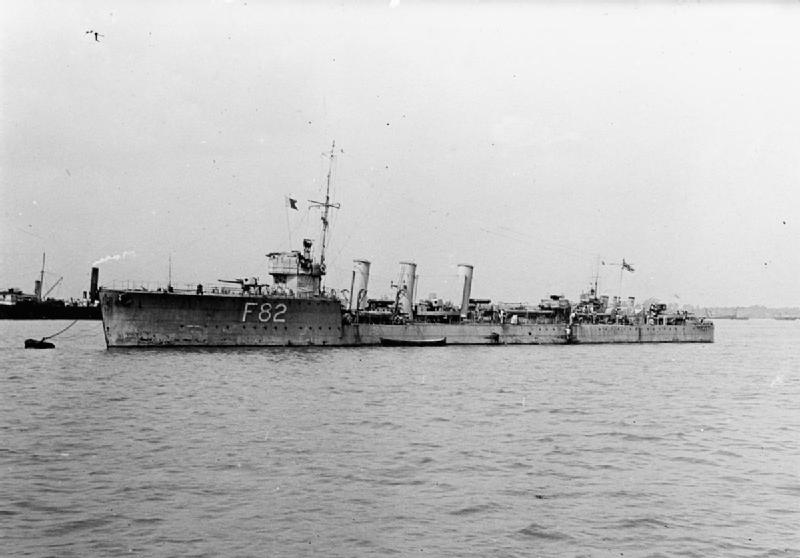
HMS Thisbe was an R-class Destroyer launched by Hawthorn Leslie on the 8th of March 19117, and handed over for breaking up in part-payment for RMS Majestic in 1936.
HMS Thruster
- Type. Destroyer
- Class. R
- Pennant. F74, F76
- Builder. Hawthorn Leslie
- Ordered. 1916
- Laid Down. 1916
- Launched. 10/01/1917
- Commissioned. 1917
- Speed. 36 knots
- Fate. Scrapped 1937
-
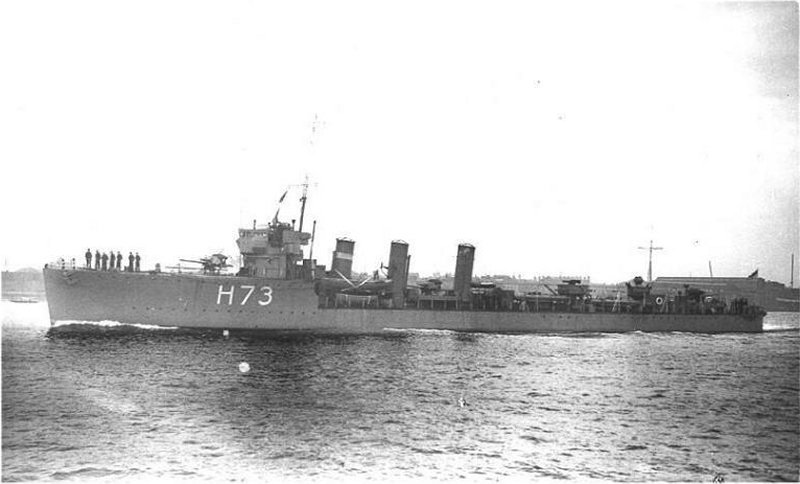
HMS Thruster
HMS Thruster was an R Class Destroyer built by Hawthorn Leslie and launched on the 10th of January 1917. Sold and arrived for breaking up 16th March 1937.
HMS Tipperary
- Type. Destroyer
- Class. Faulknor
- Pennant. H6c
- Builder. J.S White
- Laid Down. 1014
- Launched. 05/03/1915
- Commissioned. 1915
- Speed. 32 knots
- Fate. Sank 01/06/1916
-
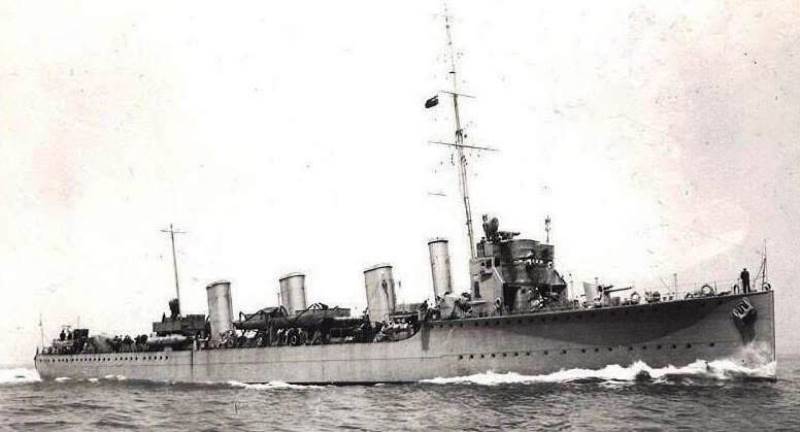
HMS Tipperary
HMS Tipperary was launched on 5 March 1915, a Faulknor-class destroyer leader. Originally ordered by Chile, Tipperary served as the second flotilla leader with the 3rd destroyer flotilla in the Harwich Force, arriving there in June, 1915. Late in that same year, she took charge of a detachment of destroyers from the 2nd flotilla before being made the leader of the 4th Flotilla in May, 1916 – a formation which directly supported the Grand Fleet. Tipperary led the 4th Flotilla at the Battle of Jutland. Tipperary and her squadron pressed home determined torpedo attacks on the German main battle line as it escaped across the rear of the British fleet during the night action, starting at approximately 23:20 on 31 May 1916 . The 4th Flotilla sank the German light cruiser SMS Frauenlob, but Tipperary and many of the other British destroyers were sunk or badly damaged. These engagements took place at such close range that some of Tipperary’s squadron were able to hit the German dreadnoughts with their small 4-inch guns, causing casualties that included command officers on the bridges.
HMS Tipperary was sunk on 1 June 1916 by fire from the secondary battery of the German dreadnought SMS Westfalen with the loss of 185 hands from her crew of 197.
HMS Tirade
- Type. Destroyer
- Class. R
- Pennant. F81, G80
- Builder. Scott’s
- Ordered. 1916
- Laid Down. 1916
- Launched. 21/04/1917
- Commissioned. 28/06/1917
- Speed. 36 knots
- Fate. Scrapped 15/11/1921
-
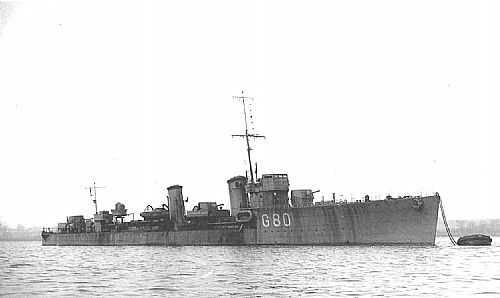
HMS Tirade
HMS Tirade was a Modified R Class Destroyer built by Scott’s of Greenock and launched on the 2st of April 1917. Upon joining the fleet on 21 July 1917, she joined the Fifteenth Destroyer Flotilla to help escort convoys out of Lough Swilly, despite a minor fault in a 4-in gun and a steering defect that would not be rectified before September. In early August, she and Rapid were tasked to search for the culprit in torpedoing and sinking a vessel. They found only flotsam and a swimming horse, whom they destroyed. While returning to their convoy, a gunner aboard Tirade sighted the conning tower of a distant submarine, which dived. Tirade dropped two depth charges to no appreciable immediate effect.
Later in the same month, Tirade was among three destroyers escorting three empty oilers when one was torpedoed at sunrise. A second torpedo attack the next midnight failed to hit Tirade and a remaining oiler.
After taking twelve days to address her steering problem, she proceeded to Scapa Flow to work with the Fifteenth. She lost several torpedoes in practice firings and then commenced escorting excruciatingly slow and disorderly convoys from Norway. On 29 September at 2.15 p.m., Moravia pointed her toward UC 55, visible on the surface and in distress due to a diving mishap. Charging in and firing from a range of 3,400 yards, Tirade’s third shell struck near the conning tower of the fleeing sub, and her fifth on the aft casing below the waterline. Tirade approached to ram and drop depth charges on her hapless foe, and Sylvia charged in, firing her forward 12-pdr.. Moravia and Rowena attempted to pile on, but the kill was Tirade’s. She recovered two of the nineteen Germans rescued from the water.
On 21 October, 1917, Tirade accidentally rammed Marmion while they were shepherding another convoy. Tirade suffered little damage, but her victim foundered before she could be towed to safety.
Reduced to C. & M. Party at the Nore on 28 November, 1919.
HMS Torrent
- Type. Destroyer
- Class. R
- Pennant. F67, F79
- Builder. Swan Hunter
- Ordered. 1916
- Laid Down. 1916
- Launched. 26/11/1916
- Commissioned. 1917
- Speed. 36 knots
- Fate. Sank 23/12/1917
-

R Class Destroyer
HMS Torrent was a R Class Destroyer built by Swan Hunter and launched on the 26th November 1916. Mined in the North Sea on the 23rd December 1917.
HMS Torrid
- Type. Destroyer
- Class. R
- Pennant. F75, F80
- Builder. Swan Hunter
- Ordered. 1916
- Laid Down. 1917
- Launched. 10/12/1917
- Commissioned. 1918
- Speed. 36 knots
- Fate. Wrecked 16/03/1937
-
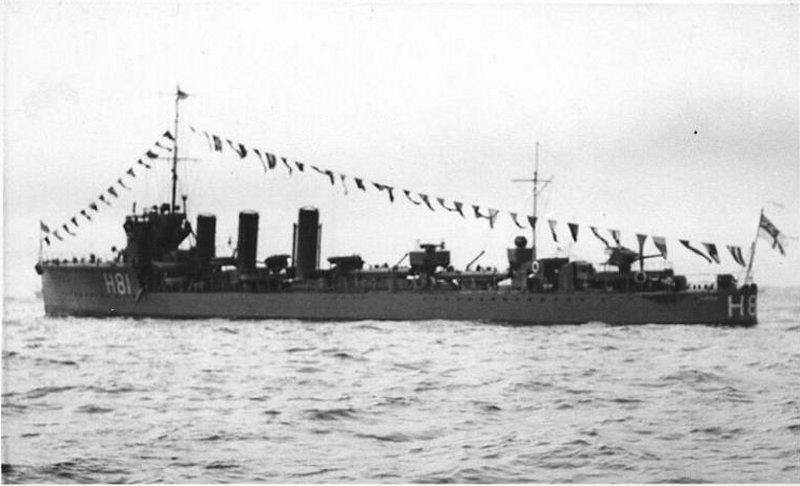
HMS Torrid
HMS Torrid was a R Class Destroyer built by Swan Hunter and launched on the 10TH of February 1917 under pennant F75 she was wrecked off Falmouth on the 16th March 1937 while under tow en route to breakers.
HMS Tornado
- Type. Destroyer
- Class. R
- Pennant. F97, F78
- Builder. A. Stephen
- Ordered. 1916
- Launched. 04/08/1917
- Commissioned. 1917
- Speed. 36 knots
- Fate. Mined 23/12/1917

R Class Destroyer
HMS Tornado was involved in one of the worst nights for the British Navy, when 3 Destroyers were all mined on 23rd December, 1917, off the Dutch North Sea coast near the Maas light buoy. seventy-five died and only two survived.
HMS Tower
- Type. Destroyer
- Class. R
- Pennant. F98, F24
- Builder. Swan Hunter
- Ordered. 1916
- Laid Down. 1916
- Launched. 05/04/1917
- Commissioned. 1917
- Speed. 36 knots
- Fate. Scrapped 17/03/1928
-
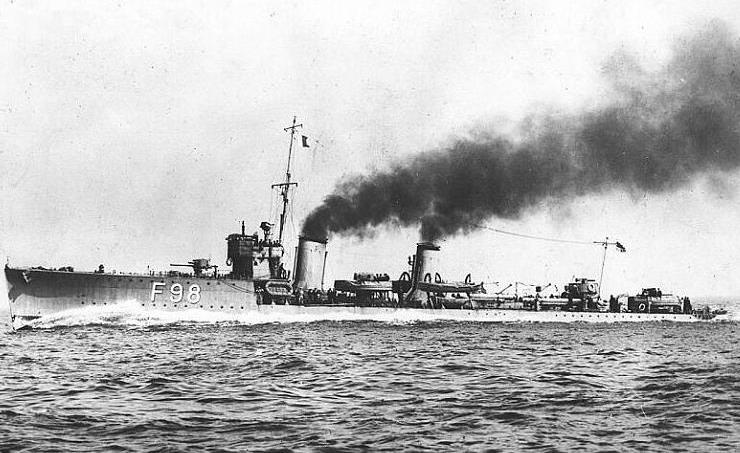
HMS Tower
HMS Tower was a modified R-class Destroyer built by Swan Hunter, and launched on 5th April 1917. She served as part of the Grand Fleet and Harwich Force. She held the pennant number of F24 from January 1918 until she was sold in 1928. Tower was sold for scrap on the 17th May 1928 and subsequently broken up by John Cashmore Ltd at Newport.
HMS Trenchant
- Type. Destroyer
- Class. R
- Pennant. G96, G78
- Builder. JS White
- Ordered. 1916
- Laid Down. 1916
- Launched. 23/12/1916
- Commissioned. 1917
- Speed. 36 knots
- Fate. Scrapped 15/11/1928
-
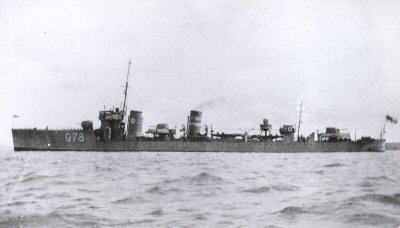
HMS Trenchant
HMS Trenchant was a R Class Destroyer built by White & Co and launched on the 23rd December 1916 she was scrapped in November 1928.
HMS Trident
- Type. Destroyer
- Class. Talisman
- Pennant. G36, F50, F81, D38
- Builder. Hawthorn Leslie
- Ordered. 1914
- Laid Down. 1915
- Launched. 20/11/1915
- Commissioned. 1915
- Speed. 32 knots
- Fate. Scrapped 01/03/1920
-
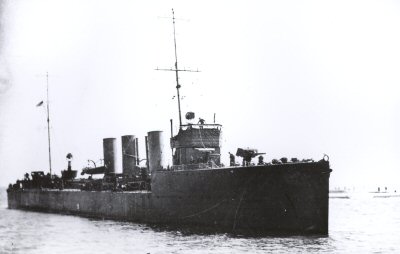
HMS Trident
HMS Trident was a Shakespeare Class Destroyer built by Hawthorn Leslie and launched on the 20th November 1915. Reduced to C & M. Party on 1 March, 1920.
HMS Tristram
- Type. Destroyer
- Class. R
- Pennant. F89, F25
- Builder. JS White
- Ordered. 1916
- Laid Down. 1916
- Launched. 24/02/1917
- Commissioned. 1917
- Speed. 36 knots
- Fate. Scrapped 09/05/1921
-
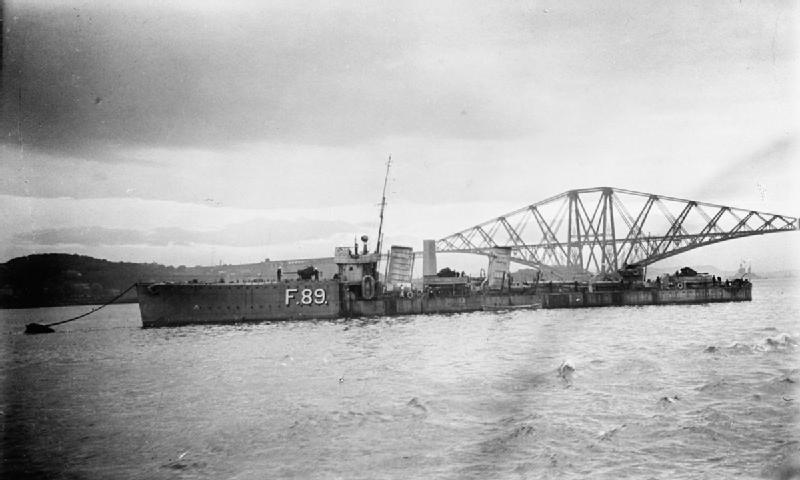
HMS Tristram
HMS Tristram was a R Class Destroyer launched on the 24th February 1917 by White & co. Scrapped 9th May 1921.
HMS Truculent
- Type. Destroyer
- Class. R
- Pennant. F70, F82
- Builder. Yarrow
- Ordered. 1916
- Laid Down. 1916
- Launched. 24/03/1917
- Commissioned. 1917
- Speed. 36 knots
- Fate. Scrapped 29/04/1927
-
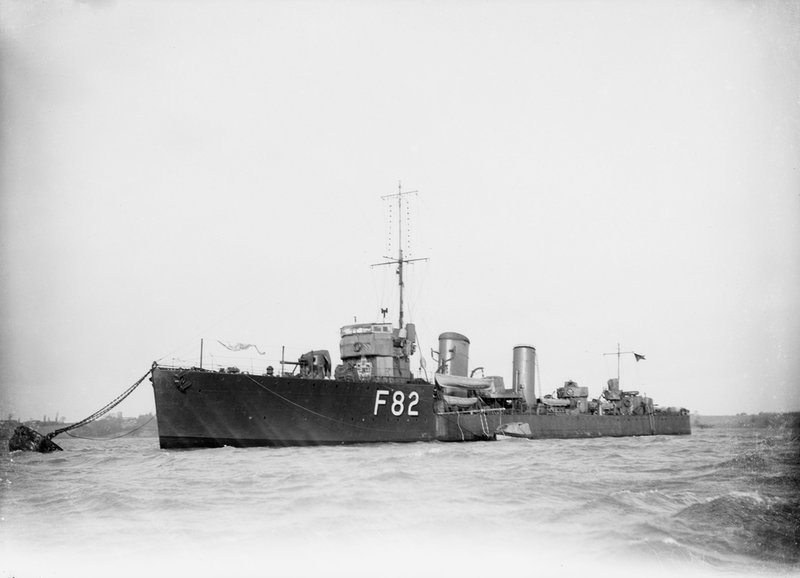
HMS Truculent
HMS Truculent was a M Class Destroyer launched on the 24th March 1917 by Yarrow. Reduced to Reserve Complement at Portsmouth on 31 August, 1920.
HMS Turbulent
- Type. Destroyer
- Class. Talisman
- Pennant. G42
- Builder. Hawthorn Leslie
- Laid Down. 1915
- Launched. 05/01/1916
- Commissioned. 12/05/1916
- Speed. 32 knots
- Fate. Sank 01/06/1916
-
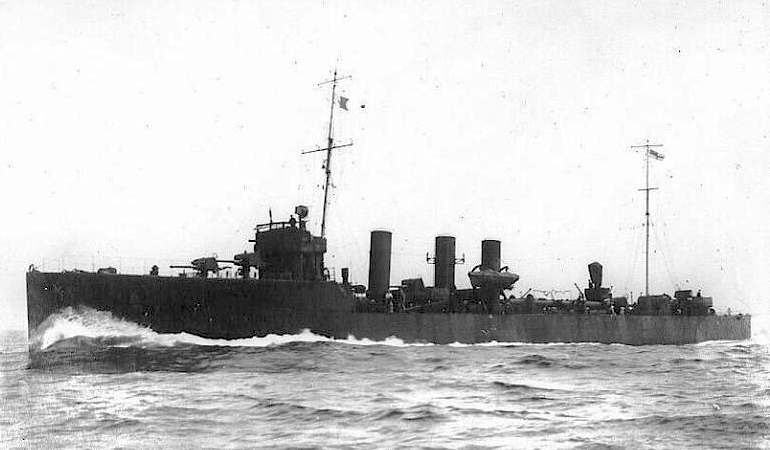
HMS Turbulent
HMS Turbulent was a Talisman class Destroyer built by Hawthorn Leslie and launched on 5 January 1916. She served with the 10th Destroyer Flotilla of the Grand Fleet on completion. She was sunk on 1 June 1916 at the battle of Jutland by a German battlecruiser with the loss of 90 crew.
HMS Ulster
- Type. Destroyer
- Class. R
- Pennant. F91, F17
- Builder. William Beardmore
- Ordered. 1916
- Launched. 10/10/1917
- Commissioned. 1917
- Speed. 36 knots
- Fate. Scrapped 1928
-
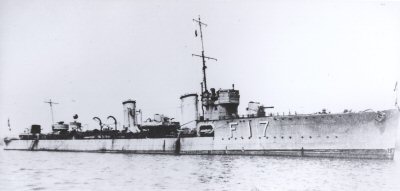
HMS Ulster
HMS Ulster was an R Class Destroyer launched on the 10th of October 1917 by William Beardmore; Ulster joined the Thirteenth Destroyer Flotilla in November, 1917. She re-commissioned in Reserve at the Nore on 15 October, 1919. Scrapped April 1928.
HMS Ullswater
- Type. Destroyer
- Class. R
- Pennant. F83
- Builder. Yarrow
- Ordered. 1916
- Laid Down. 1916
- Launched. 04/08/1917
- Commissioned. 1917
- Speed. 36 knots
- Fate. Sank 15/08/1918
-

R Class Destroyer
HMS Ullswater was a R Class Destroyer built by Yarrow Shipbuilders and launched on the 4th August 1917. Torpedoed by UC17 of Holland 15/8/18
HMS Ulysses
- Type. Destroyer
- Class. R
- Pennant. F80, G96, G77
- Builder. Doxford
- Ordered. 1916
- Laid Down. 1916
- Launched. 24/03/1917
- Commissioned. 1917
- Speed. 36 knots
- Fate. Sank 29/10/1918
-

HMS ulysses
HMS Ulysses was a British R Class Destroyer built by William Doxford & sons, Sunderland and launched in 1917, She was sunk in collision with the s.s Ellerie in fog in the Firth of Clyde on the 29th of October 1918.
HMS Umpire
- Type. Destroyer
- Class. R
- Pennant. F94, F26
- Builder. Doxford
- Ordered. 1916
- Laid Down. 1916
- Launched. 09/06/1917
- Commissioned. 1917
- Speed. 36 knots
- Fate. Scrapped 07/01/1930
-
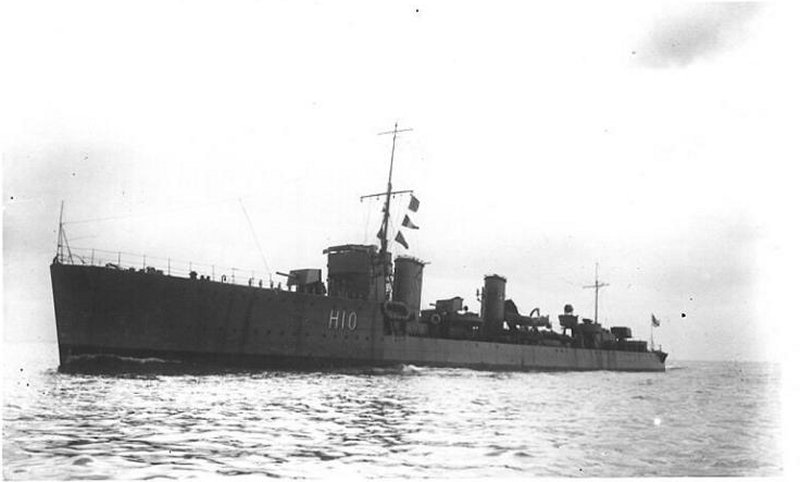
HMS Umpire
HMS Umpire was a modified R-class Destroyer launched on the 9th June 1917 by William Doxford & Sons, Sunderland and sold for breaking up on 7 January 1930.
HMS Undine
- Type. Destroyer
- Class. R
- Pennant. G97, G79
- Builder. Fairfield
- Ordered. 1916
- Laid Down. 1916
- Launched. 22/03/1917
- Commissioned. 1917
- Speed. 36 knots
- Fate. Scrapped 1928
-
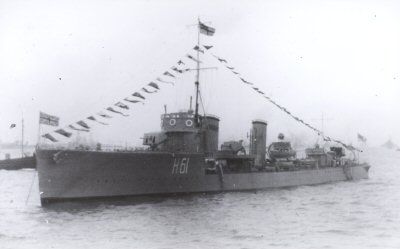
HMS Undine
HMS Undine was an R class Destroyer launched on the 22nd of March 1917 by Fairfield Shipbuilding and sold in 1928. She was then wrecked later that year and the wreck sold for breaking up.
HMS Urchin
- Type. Destroyer
- Class. R
- Pennant. F95, F04
- Builder. Palmers
- Ordered. 1916
- Laid Down. 1917
- Launched. 07/07/1917
- Commissioned. 1917
- Speed. 36 knots
- Fate. Sold 07/01/1930
-

HMS Urchin
HMS Urchin was a modified R-Class destroyer built by Palmers Shipbuilding and Iron Company and launched in 1917. In August, 1917, Urchin was assigned to the Thirteenth Destroyer Flotilla, and sold on the 7th of January 1930.
HMS Ursa
- Type. Destroyer
- Class. R
- Pennant. F10
- Builder. Palmers
- Ordered. 1916
- Laid Down. 1917
- Launched. 23/07/1917
- Commissioned. 1917
- Speed. 36 knots
- Fate. Sold 13/07/1926
-
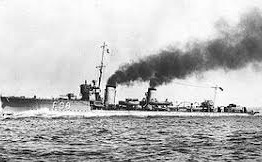
HMS Ursa
HMS Ursa was a modified R-class destroyer launched on the 23rd of July 1917 by Scott’s of Greenock. Ursa joined the Thirteenth Destroyer Flotilla in October, 1917. Ursa was sold on the 13th of July 1926.
HMS Ursula
- Type. Destroyer
- Class. R
- Pennant. F88
- Builder. Scotts
- Ordered. 1916
- Laid Down. 1917
- Launched. 02/08/1917
- Commissioned. 1917
- Speed. 36 knots
- Fate. Scrapped 13/07/1929
-

R Class Destroyer
HMS Ursula was an R Class Destroyer built by Scotts of Greenock and launched on the 2nd of August 1917. Sold for scrap November 1929.
HMS Valkyrie
- Type. Destroyer
- Class. V
- Pennant. F83, F86, F05
- Builder. Denny
- Ordered. 1916
- Laid Down. 1916
- Launched. 13/03/1917
- Commissioned. 1917
- Speed. 34 knots
- Fate. Stricken 1936
-

HMS Valkyrie
HMS Valkyrie was a V class flotilla leader ordered in July of 1916 from William Denny & Bros. Ltd shipyard under the 9th Order for Destroyers of the Emergency War Program of 1916-17. She was originally to be called HMS Malcolm but was renamed before being completed. Valkyrie and Valorous were ordered from William Denny and Brothers in April 1916, with three more being ordered from other builders in July that year. HMS Valkyrie’s keel was laid on 25th May 1916 at Denny’s shipyard in Dumbarton, Scotland. She was launched on 13 March 1917. After commissioning she was modified to carry mines.
She shipped four Mk V QF (quick fire) 4-inch L/45 guns in four single center-line mounts. These were disposed as two forward and two aft in super imposed firing positions. She also carried one QF 3-inch 20 cwt anti-aircraft gun aft of the second funnel. Aft of the 3-inch gun, she carried four 21-inch Torpedo tubes mounted in pairs on the center-line.
She was damaged by a mine in Dec 1917. In 1918, Valkyrie was part of the 13th Destroyer Flotilla led by the light cruiser HMS Champion. In 1919 she was reassigned to the 2nd Destroyer Flotilla and assigned the Pennant number D61. She maintained this pennant number through to her being stricken in 1936.
HMS Vega
- Type. Destroyer
- Class. V
- Pennant. F4a, F92, F09
- Builder. Doxford
- Ordered. 1916
- Laid Down. 1917
- Launched. 01/09/1917
- Commissioned. 1917
- Speed. 34 knots
- Fate. Scrapped 26/03/1947
-
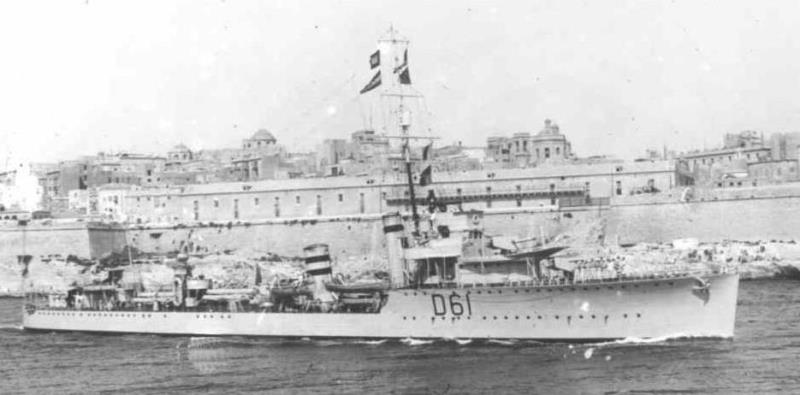
HMS Vega
HMS Vega was a V-class Destroyer of the British Royal Navy that saw service in World War I and World War II. Vega was ordered on 30 June 1916 as part of the 9th Order of the 1916–17 Naval Programme. She was laid down on 11 December 1916 by William Doxford & Sons at Sunderland, and launched on 1 September 1917. She was commissioned into service on 14 December 1917.
Vega was assigned to the Grand Fleet or Harwich Force and saw service in the last year of World War I, suffering damage while operating with the fleet in 1918. In July 1940, Vega returned to convoy duty in the North Sea. This came to an end on 11 November 1940, when she struck a naval mine off Sunk Head, Harwich, and suffered heavy damage. After the armistice with Japan brought World War II to an end on 15 August 1945, Vega was decommissioned and placed in reserve. She was sold on 4 March 1947 to Bisco for scrapping by Clayton and Davies at Dunston on Tyne and arrived at the Shipbreakers yard at on 26 March 1947.
HMS Vehement
- Type. Destroyer
- Class. V
- Pennant. F1a, F12, H2a
- Builder. Denny
- Ordered. 1916
- Laid Down. 25/09/1916
- Launched. 06/07/1917
- Commissioned. 1917
- Speed. 34 knots
- Fate. Sank 01/08/1918
-
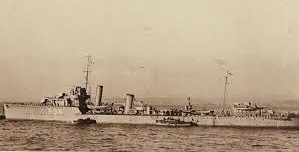
HMS Vehement
HMS Vehement was a V class destroyer ordered in July 1916. She was laid down on 25 September 1916 by William Denny and Brothers at Dumbarton, Scotland, She was launched on 6 July 1917 and was completed later in 1917 and commissioned into service. Her original pennant number, F1A, was changed to F12 in January 1918 and to H2A in June 1918. In 1918, the 20th Destroyer Flotilla was engaged in a major British effort to lay minefields in the North Sea to close the Heligoland Bight to passage by German ships and submarines. On 31 May 1918, Vehement put to sea from Immingham with the flotilla to lay mines in the Dogger Bank area. On the night of 4-5 June 1918, the flotilla again deployed from the Humber estuary to mine the same area, bringing the total number of mines laid in the two expeditions to 330.
HMS Vehement’s next minelaying operation on 24 July 1918 involved the entire flotilla laying 496 mines in the North Sea in 22 rows; during the operation, Vehement detected two periscopes. The flotilla sortied from the Humber again at 13:00 hours on 28 July 1918 and during the night of 28-29 July laid a North Sea field of 416 mines in 18 rows. On 1 August 1918, the 20th Destroyer Flotilla departed the Humber to lay a minefield in the North Sea at the seaward end of one of the German-swept channels through the German minefield in the Heligoland Bight. At 23:47 hours the force was within 20 nautical miles of the area it was to mine when Vehement struck a mine, Its explosion caused her forward ammunition magazine to detonate, blowing off the entire forward section of the ship forward of the forward funnel, killing one officer and 47 ratings. As the force maneuvered to clear the German minefield it had entered, the destroyer HMS Ariel also struck a mine at 00:10 hours on 2 August and, in a repeat of what had happened to Vehement, suffered a magazine detonation that blew off the entire section of the ship forward of the whaleboat’s davit. Ariel sank at about 01:00 hours, with the loss of four officers and 45 ratings, but Vehement remained afloat, and her crew had put out all of her fires by about an hour after she struck the mine. She was taken in tow by the destroyer HMS Abdiel in the hope of saving her, but at 04:00 hours on 2 August Vehement’s stern rose into the air, making further towing impossible. Vehement’s surviving crew opened all of her hull valves to speed her sinking and abandoned ship. Telemachus and Vanquisher then sank Vehement with gunfire.
HMS Venetia
- Type. Destroyer
- Class. V
- Pennant. F93, F14, D53
- Builder. Fairfield
- Laid Down.02/02/1917
- Launched. 29/10/1917
- Commissioned. 19/12/1917
- Fate. Sank 19/10/1940
-
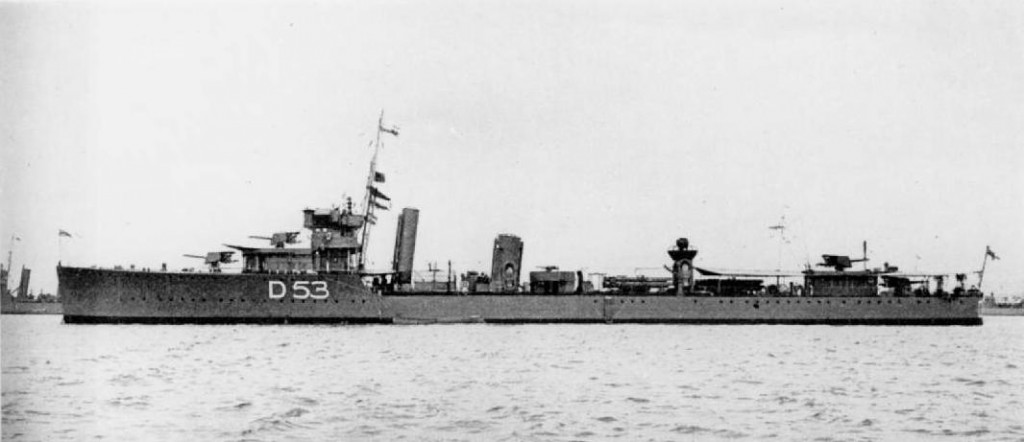
HMS Venetia
HMS Venetia was ordered on 30 June 1916 as part of the 9th Order of the 1916-17 Naval Programme. She was laid down on 2 February 1917 by the Fairfield Shipbuilding and Engineering Company at Govan, Scotland, and launched on 29 October 1917. She was completed on 19 December 1917 and commissioned into service the same day.
In May 1940, Venetia was transferred to Nore Command for operations related to the evacuation of Allied personnel from the Netherlands, Belgium, and France because of the successful German offensive there. On 12 May, in Operation J, she and the destroyer HMS Vivacious escorted the destroyer HMS Codrington as Codrington transported the Dutch Royal Family from the Hook of Holland into exile in the United Kingdom.
After spending the summer of 1940 undergoing repairs, Venetia returned to Nore Command in August 1940 and began convoy defence and patrol duties in the North Sea and Thames Estuary in September 1940. On 19 October 1940, she struck a mine off Knob Buoy in the Thames Estuary 12 nautical miles northeast of Margate, Kent.
HMS Verdun
- Type. Destroyer
- Class. V
- Pennant. D93, L93
- Builder. Hawthorn
- Ordered. 1916-1917
- Laid Down. 13/01/1917
- Launched. 21/08/1917
- Commissioned. 03/11/1917
- Speed. 34 knots
- Fate. Scrapped 1946
-
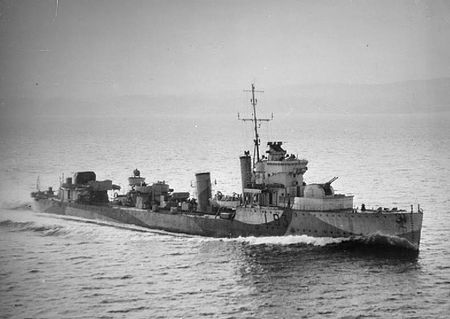
HMS Verdun
HMS Verdun was an Admiralty V class destroyer of the Royal Navy which saw service in the First and Second World Wars. Launched on 21 August 1917 at the Hawthorn Leslie shipyard in Hebburn on Tyneside, she completed in November of the same year. She served with the Grand Fleet and the Harwich Force.
Verdun went into reserve at Rosyth as part of the 9th Destroyer Flotilla until September 1939, when she was selected for conversion into an Anti-Aircraft Escort at Chatham Dockyard. She operated as a convoy escort out of Rosyth and in the North Sea, being damaged by a bomb on 1 November 1940 that killed 11 men, including her captain. She was repaired at Harwich and spent the rest of the war escorting convoys along the east coast. In November 1941, she was in sustained action against an attack by German E-boats; three British merchant ships were sunk in the engagement
HMS Verdun was placed in reserve after VE Day and then sold to be scrapped at Granton, Edinburgh in April 1946.
HMS Vesper
- Type. Destroyer
- Class. V
- Pennant. D55, F39
- Builder. Stephens
- Ordered. 30/06/1916
- Laid Down. 07/12/1916
- Launched. 15/12/1917
- Commissioned. 20/02/1918
- Speed. 34 knots
- Fate. Scrapped 07/04/1947
-
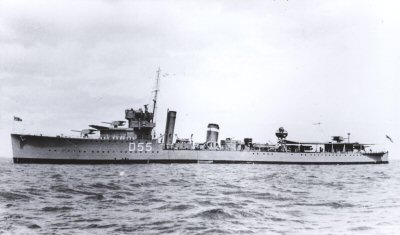
HMS Vesper
HMS Vesper was a V class destroyer that saw service in World War I and World War II. Vesper was ordered on 30 June 1916 as part of the 9th Order of the 1916-17 Naval Programme. She was laid down on 7 December 1916 by Stephen’s of Govan, Glasgow, and launched on 15 December 1917. She was completed on 20 February 1918.
Vesper was recommissioned in 1939. After the United Kingdom entered World War II in September 1939, she was assigned to convoy defence and patrol duties in the South western Approaches through December 1939.
In May 1940, Vesper was deployed with the 19th Destroyer Flotilla to Harwich, and assigned to the support of the evacuation of troops from France. On 10 May 1940 she carried a demolition party to IJmuiden in the Netherlands in Operation XD to destroy oil tanks there to prevent their capture by advancing Germany Army forces, and on 14 May 1940 she took part in Operation Ordnance, the evacuation of forces from the Hook of Holland. During June 1940, deployed with her destroyer flotilla to Dover and provided gunfire support to the retreating British Expeditionary Force at Le Tréport, France.
After Germany‘s surrender, Vesper did not deploy operationally, and she soon was decommissioned and placed in reserve, being no longer included on the Royal Navy’s July 1945 active list. She was sold to Bisco on 7 March 1947 for scrapping by T. W. Ward, and arrived at the Shipbreakers yard in March 1948.
HMS Violent
- Type. Destroyer
- Class. V
- Pennant. F95, D57
- Builder. Swan Hunter
- Ordered. 1916
- Laid Down. 1916
- Launched. 01/09/1917
- Commissioned. 1917
- Speed. 34 knots
- Fate. Scrapped 08/03/1937
-
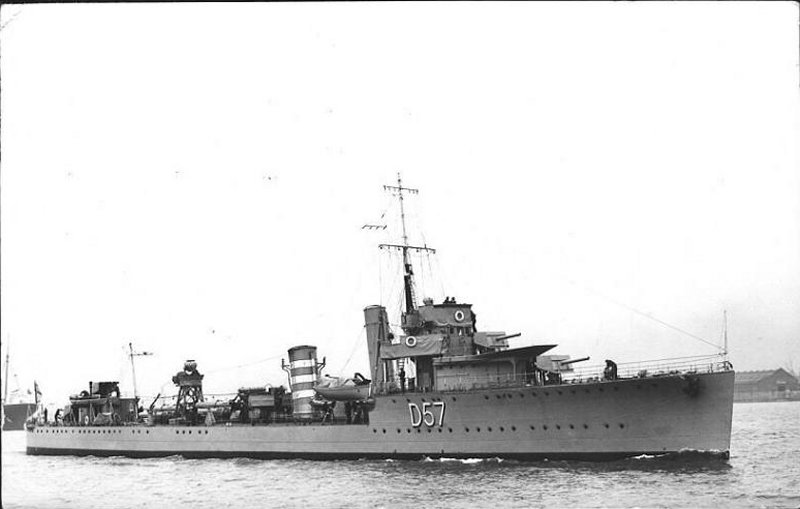
HMS Violent
HMS Violent was a V-class destroyer of the British Royal Navy that saw service in World War I and was in commissioned from 1917 to 1937. Violent, was ordered in July 1916. She was laid down by Swan Hunter at Wallsend, Tyne and Wear, in November 1916 and launched on 1 September 1917. She was completed in November 1917.
Violent was assigned to the Grand Fleet or Harwich Force for the rest of World War I. On 19 July 1918, she participated in the history’s first attack by aircraft launched from the flight deck of an aircraft carrier, when she operated in the North Sea in support of a strike by Royal Air Force Sopwith 2F.1 Camel fighters from the aircraft carrier HMS Furious against the Imperial German Navy Zeppelin dirigible sheds at Tondern, Germany in what became known as the Tondern Raid. Returning from the strike, Camel pilot Captain William F. Dickson, who had decided he would not be able to return to Furious, sighted Violent – the first British warship he encountered during his return flight – and circled her before ditching his aircraft in the sea. Violent recovered him, and he went on to become a Marshal of the Royal Air Force, Chief of the Air Staff, and Chief of the Defence Staff.
After World War I, the United Kingdom received the passenger liner SS Bismarck from Germany in 1920 as a war reparation, and she was sold to the White Star Line, later the Cunard White Star Line, in which she served as RMS Majestic. In 1936, Cunard White Star retired Majestic and sold her to Thomas W. Ward for scrapping, but because of legal requirements imposed under the agreement transferring Majestic to the United Kingdom as a war prize, the British government instead took control of Majestic and assigned her to the Royal Navy. To pay Thomas W. Ward for Majestic, the Royal Navy agreed to transfer 24 old destroyers with a combined scrap value equivalent to that of Majestic to Thomas W. Ward for scrapping. Violent was among these, and her transfer to Thomas W. Ward took place on 8 March 1937. She was scrapped at Inverkeithing, Scotland.
HMS Vivacious
- Type. Destroyer
- Class. V
- Pennant. D36, F32, G71, G01
- Builder. Yarrow
- Ordered. 30/06/1916
- Laid Down. 1916
- Launched. 3/11/1916
- Commissioned. 29/12/1917
- Speed. 34 knots
- Fate. Scrapped 07/05/1947
-
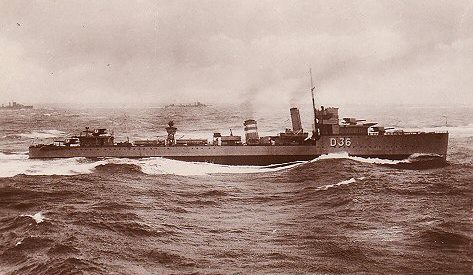
HMS Vivacious
HMS Vivacious was a V-class destroyer that saw service in World War I and World War II. She was laid down in July 1916 by Yarrow Shipbuilders of Glasgow, Scotland, and launched on 3 November 1916. She was completed in December 1917 and commissioned on 29 December 1917.Upon completion, Vivacious was fitted for use as a minelayer and entered service with the fleet during the final year of World War I. After the war, she deployed to the Baltic Sea in 1919 to participate in the British campaign there against Bolshevik forces during the Russian Civil War, seeing action against Russian warships.
Vivacious was decommissioned during the summer of 1945 and was in reserve until placed on the disposal list in 1947. She was sold on 17 May 1947 to Bisco for scrapping by Metal Industries and arrived at the ship breaker’s yard on 10 September 1947.
HMS Vivien
- Type. Destroyer
- Class. V
- Pennant. G39, L33
- Builder. Yarrow
- Ordered. 1918
- Laid Down. 1918
- Launched. 16/12/1918
- Commissioned. 1919
- Speed. 34 knots
- Fate. Scrapped 1948
-
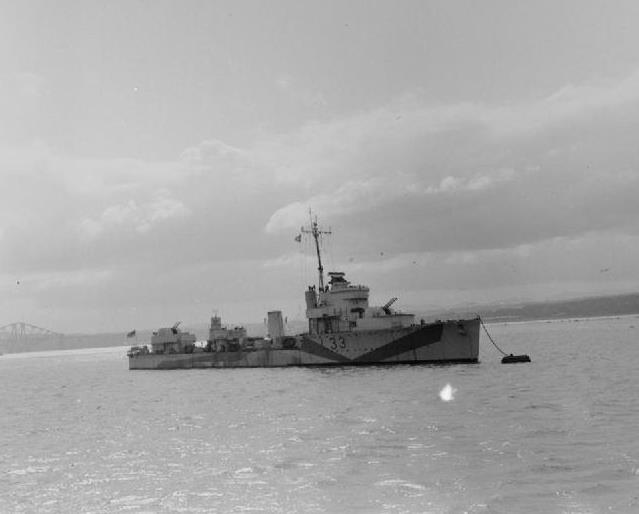
HMS Vivien
HMS Vivien was ordered on 30 June 1916 as part of the 9th Order of the 1916-17 Naval Programme. She was laid down in July 1916 by Yarrow Shipbuilders at Scotstoun, Glasgow, Scotland, and launched on 16 February 1918. She was completed on 28 May 1918 and commissioned into service the same day.
Vivien was decommissioned in May 1945 and placed in reserve. She was placed on the disposal list in 1947 and was sold to Bisco on 18 February 1948 for scrapping by Metal Industries. She arrived at the Shipbreakers yard at Charlestown, Fife, Scotland. She arrived under tow at the Shipbreakers yard in April 1948.
HMS Vulture
- Type. Destroyer
- Class. V
- Pennant. N50, D75
- Builder. J&G Thompson
- Ordered. 1895
- Laid Down.26/11/1895
- Launched. 22/03/1898
- Fate. Scrapped 1919
-
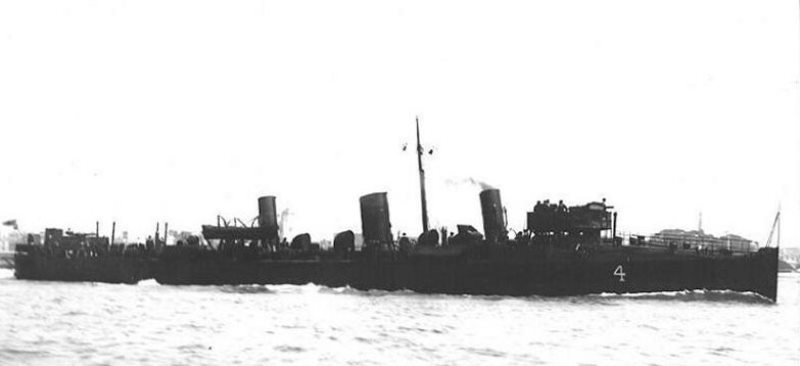
V & W Class Destroyer
HMS Vulture was a Clydebank three funnel destroyer ordered. She was laid down as Yard Number 291 on 26 November 1895 at J & G Thompson shipyard in Clydebank and launched on the 22nd March 1898. In 1899 during the construction of these ships, steelmaker John Brown and Company of Sheffield bought J&G Thomson’s Clydebank yard for £923,255 3s 3d. She was completed and accepted by the Royal Navy in May 1900. She was the last to be laid down but the first accepted in this group. After commissioning she was assigned to the Chatham Division of the Harwich Flotilla. She was deployed in Home waters for her entire service life. On 30 August 1912 the Admiralty directed all destroyer classes were to be designated by alpha characters starting with the letter ‘A’. Since her design speed was 30-knots and she had three funnels she was assigned to the C Class.
In 1914 she was undergoing refit at the Nore based at Sheerness tendered to HMS Actaeon, a Royal Navy training establishment. With the outbreak of hostilities in August 1914 she was assigned to the Nore Local Flotilla. Her duties included anti-submarine and counter mining patrols in the Thames Estuary. She remained in this employment for the duration of the war.
In 1919 she was paid off and laid-up in reserve awaiting disposal. She was sold on 27 May 1919 to Hayes of Porthcawl for breaking.
HMS Walrus
- Type. Destroyer
- Class. W
- Pennant. G17, D24
- Builder. Fairfield
- Ordered. 1916
- Laid Down. 1917
- Launched. 27/12/1917
- Commissioned. 08/03/1918
- Speed. 34 knots
- Fate. Scrapped 1938
-
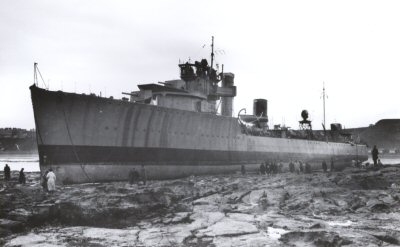
HMS Walrus
HMS Walrus was ordered in December 1916 and was laid down by the Fairfield Shipbuilding and Engineering Company at Govan, Scotland, in February 1917. She was launched on 27 December 1917 and commissioned on 8 March 1918.
The Royal Navy decided to convert Walrus into an anti aircraft escort, and in February 1938 a tug took her under tow from Rosyth with a skeleton crew of four men aboard bound for Chatham Dockyard, where she was to undergo the conversion. During the voyage, however, a powerful storm struck the North Sea, and on 12 February 1938 her towline broke in high winds and heavy seas and she was driven ashore in Filey Bay north of Scarborough, Yorkshire. The four men aboard Walrus made it to shore safely in one of her boats.
Deemed beyond economical repair, Walrus was sold to Round Brothers of Sunderland, England, on 5 March 1938 for scrapping. She was refloated on 29 March 1938 and scrapped in October 1938.
HMS Warwick
- Type. Destroyer
- Class. W
- Pennant. H38
- Builder. Hawthorn Leslie
- Ordered. 1916
- Laid Down. 10/03/1917
- Launched. 28/12/1917
- Commissioned. 18/03/1918
- Speed. 34 knots
- Fate. Sank 20/02/1944
-

HMS Warwick
HMS Warwick was an Admiralty ‘W’ class destroyer built by Hawthorn Leslie & Company, Hebburn, being laid down 10 March 1917. She launched on 28 December 1917, and completed 18 March 1918. Warwick commissioned in March 1918 and saw action in the last months of World War I. She took part in the raid on Zeebrugge in April, the attempt by the RN to blockade Germany’s U-boat force stationed in Flanders. She also participated in the second raid on Ostend in May and was heavily damaged by mine. Warwick was present at Scapa Flow in November 1918 when the Grand Fleet received the surrender of the German High Seas Fleet at the end of the war.
On 20 February 1944, while patrolling off Trevose Head, and under command of Cdr. Denys Rayner, Warwick was torpedoed by U-413. She sank in minutes, with the loss of over half her crew.
We are adding more information to this site on a regular basis, if you wish to submit any photos or provide any information on naval vessels that were based or visited Harwich, then please use the contact page at the bottom of the screen.
Copyright Ownership.
We attempted to get the consent of copyright holders to use this material for nearly all of the photographs on the website.
In the few cases where names are available, a thorough search was made using telephone directories, photographic copyright directories, People Search and Google Area Search. None of the copyright owners could be traced in this way and we believe we have exhausted all reasonable avenues.
The consensus opinion of these authorities was that if any two of the following situations applied we would be deemed to have taken sufficient action to avoid infringing copyright laws:
- Reasonable efforts made to contact the copyright holder
- No financial gain will be made in relation to the photos
- A letter is obtained from present owner of photos
- There is a proviso included stating that if offence is caused document will be removed
The website owner undertakes to remove any photograph from the website where offence is caused. All the above conditions have therefore been met.
Website Contributors: IWM
← Destroyers – World War 2 Depot Ships – World War 2 →